Quick filters:
Sumerian ziggurat Stock Photos and Images
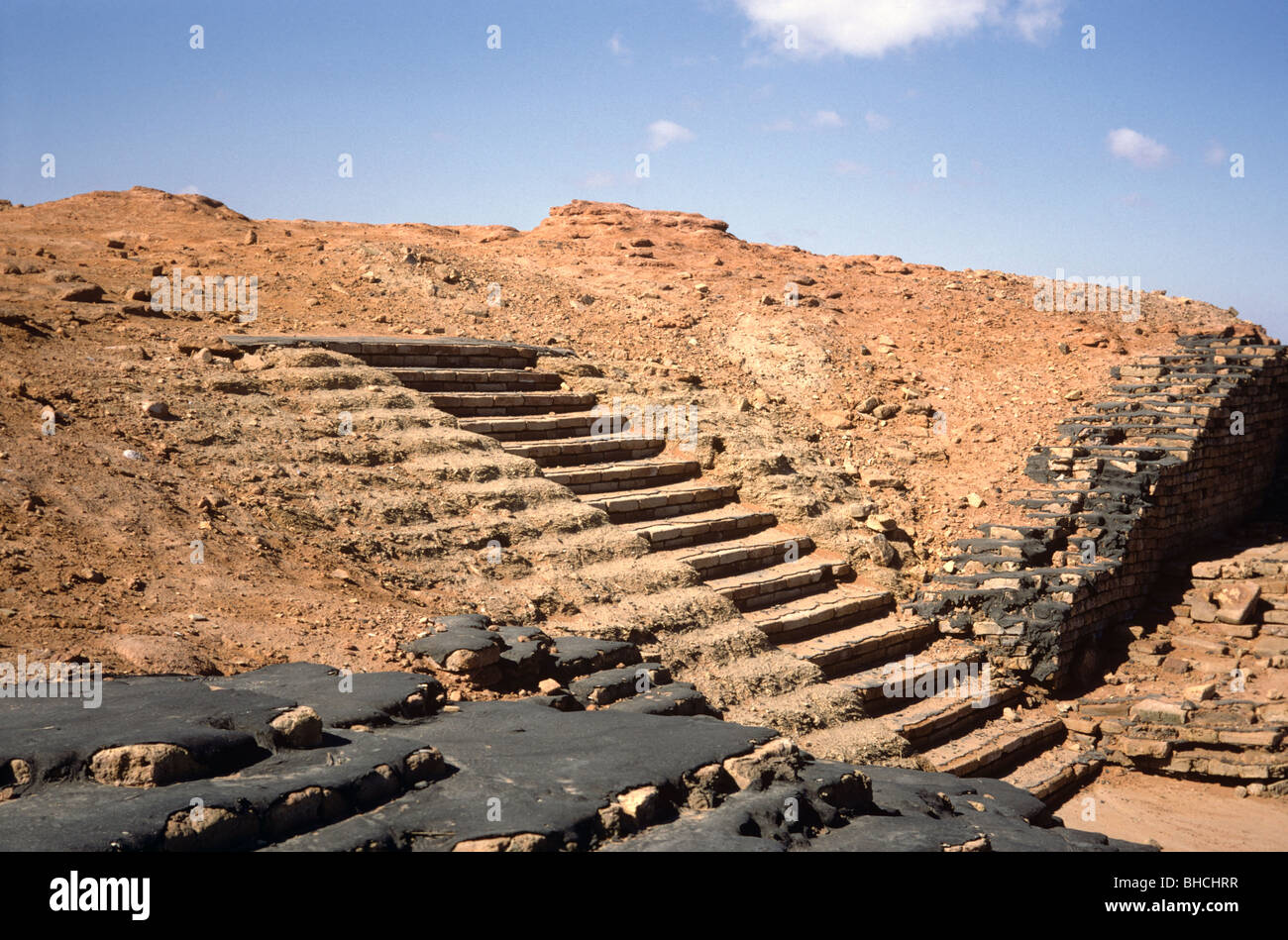 The top level of the Ziggurat of Ur-Nammu (Sumerian, founder of the 3rd dynasty of Ur, c.2470/2100 BC), Iraq 690131 012 Stock Photohttps://www.alamy.com/image-license-details/?v=1https://www.alamy.com/stock-photo-the-top-level-of-the-ziggurat-of-ur-nammu-sumerian-founder-of-the-27936939.html
The top level of the Ziggurat of Ur-Nammu (Sumerian, founder of the 3rd dynasty of Ur, c.2470/2100 BC), Iraq 690131 012 Stock Photohttps://www.alamy.com/image-license-details/?v=1https://www.alamy.com/stock-photo-the-top-level-of-the-ziggurat-of-ur-nammu-sumerian-founder-of-the-27936939.htmlRMBHCHRR–The top level of the Ziggurat of Ur-Nammu (Sumerian, founder of the 3rd dynasty of Ur, c.2470/2100 BC), Iraq 690131 012
![The reconstructed facade of the Neo-Sumerian Great Ziggurat of Ur, near Nasiriya, Iraq. Ziggurats were built by the Sumerians, Babylonians, Elamites, Acadians, and Assyrians for local religions. Each ziggurat was part of a temple complex which included other buildings. The precursors of the ziggurat were raised platforms that date from the Ubaid period[1] during the fourth millennium BC. The earliest ziggurats began near the end of the Early Dynastic Period.[2] The latest Mesopotamian ziggurats date from the 6th century BC. Stock Photo The reconstructed facade of the Neo-Sumerian Great Ziggurat of Ur, near Nasiriya, Iraq. Ziggurats were built by the Sumerians, Babylonians, Elamites, Acadians, and Assyrians for local religions. Each ziggurat was part of a temple complex which included other buildings. The precursors of the ziggurat were raised platforms that date from the Ubaid period[1] during the fourth millennium BC. The earliest ziggurats began near the end of the Early Dynastic Period.[2] The latest Mesopotamian ziggurats date from the 6th century BC. Stock Photo](https://c8.alamy.com/comp/EC7WTB/the-reconstructed-facade-of-the-neo-sumerian-great-ziggurat-of-ur-EC7WTB.jpg) The reconstructed facade of the Neo-Sumerian Great Ziggurat of Ur, near Nasiriya, Iraq. Ziggurats were built by the Sumerians, Babylonians, Elamites, Acadians, and Assyrians for local religions. Each ziggurat was part of a temple complex which included other buildings. The precursors of the ziggurat were raised platforms that date from the Ubaid period[1] during the fourth millennium BC. The earliest ziggurats began near the end of the Early Dynastic Period.[2] The latest Mesopotamian ziggurats date from the 6th century BC. Stock Photohttps://www.alamy.com/image-license-details/?v=1https://www.alamy.com/stock-photo-the-reconstructed-facade-of-the-neo-sumerian-great-ziggurat-of-ur-76391291.html
The reconstructed facade of the Neo-Sumerian Great Ziggurat of Ur, near Nasiriya, Iraq. Ziggurats were built by the Sumerians, Babylonians, Elamites, Acadians, and Assyrians for local religions. Each ziggurat was part of a temple complex which included other buildings. The precursors of the ziggurat were raised platforms that date from the Ubaid period[1] during the fourth millennium BC. The earliest ziggurats began near the end of the Early Dynastic Period.[2] The latest Mesopotamian ziggurats date from the 6th century BC. Stock Photohttps://www.alamy.com/image-license-details/?v=1https://www.alamy.com/stock-photo-the-reconstructed-facade-of-the-neo-sumerian-great-ziggurat-of-ur-76391291.htmlRMEC7WTB–The reconstructed facade of the Neo-Sumerian Great Ziggurat of Ur, near Nasiriya, Iraq. Ziggurats were built by the Sumerians, Babylonians, Elamites, Acadians, and Assyrians for local religions. Each ziggurat was part of a temple complex which included other buildings. The precursors of the ziggurat were raised platforms that date from the Ubaid period[1] during the fourth millennium BC. The earliest ziggurats began near the end of the Early Dynastic Period.[2] The latest Mesopotamian ziggurats date from the 6th century BC.
 Picture of Ziggurat of Ur and one of the most important monuments in Iraq and that goes back to the Sumerian period which are located in the province of Dhi Qar in southern Iraq. Stock Photohttps://www.alamy.com/image-license-details/?v=1https://www.alamy.com/stock-photo-picture-of-ziggurat-of-ur-and-one-of-the-most-important-monuments-111856771.html
Picture of Ziggurat of Ur and one of the most important monuments in Iraq and that goes back to the Sumerian period which are located in the province of Dhi Qar in southern Iraq. Stock Photohttps://www.alamy.com/image-license-details/?v=1https://www.alamy.com/stock-photo-picture-of-ziggurat-of-ur-and-one-of-the-most-important-monuments-111856771.htmlRMGDYECK–Picture of Ziggurat of Ur and one of the most important monuments in Iraq and that goes back to the Sumerian period which are located in the province of Dhi Qar in southern Iraq.
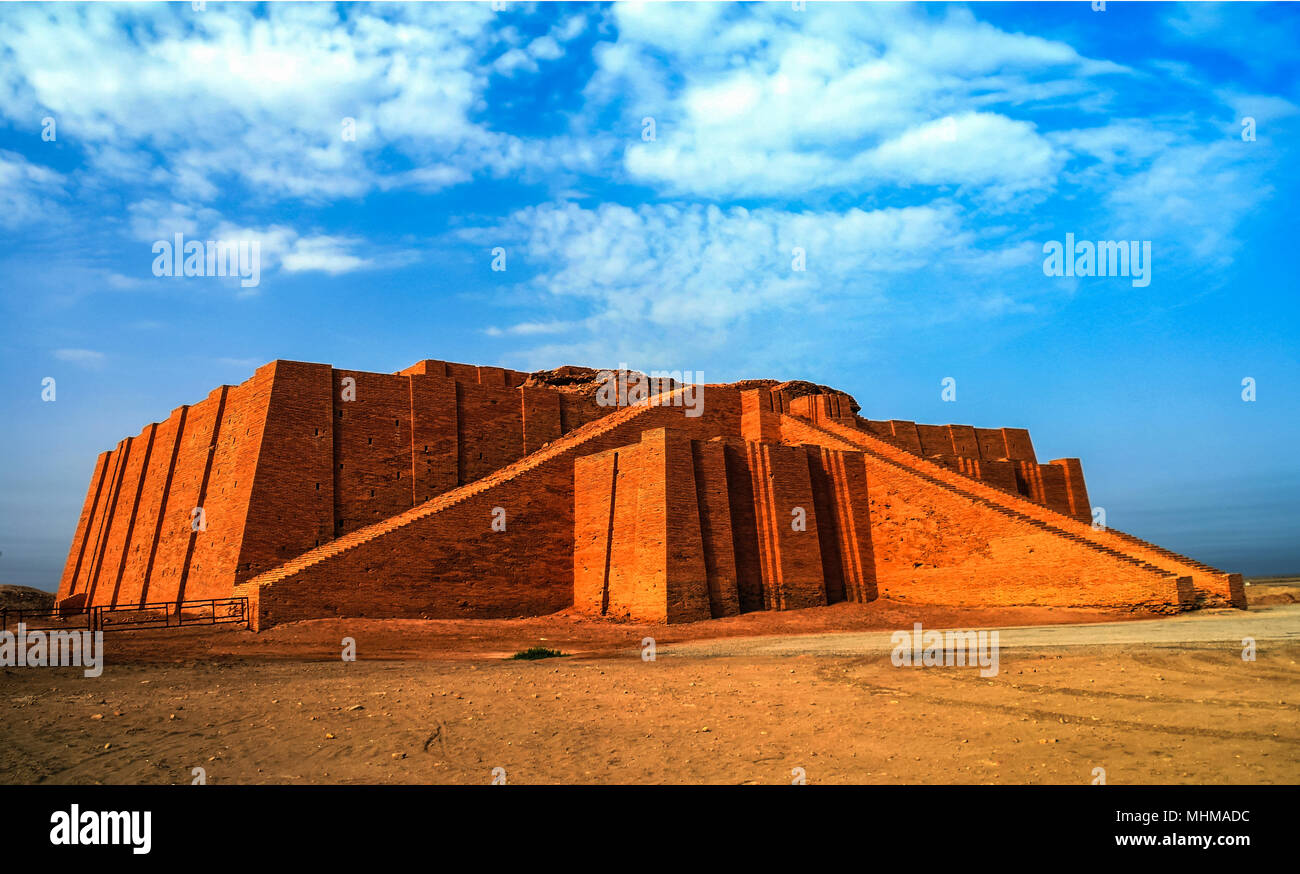 Restored ziggurat in ancient Ur, sumerian temple in Iraq Stock Photohttps://www.alamy.com/image-license-details/?v=1https://www.alamy.com/restored-ziggurat-in-ancient-ur-sumerian-temple-in-iraq-image183000088.html
Restored ziggurat in ancient Ur, sumerian temple in Iraq Stock Photohttps://www.alamy.com/image-license-details/?v=1https://www.alamy.com/restored-ziggurat-in-ancient-ur-sumerian-temple-in-iraq-image183000088.htmlRFMHMADC–Restored ziggurat in ancient Ur, sumerian temple in Iraq
 The Great Ziggurat of Ur was built by the Neo-Sumerians in the reign of King Nabonidus 556-539 BC on the rubble of an older Sumerian structure constructed by Sumerian King Ur-Nammu ca 2100 B.C. It received extensive restoration in the 1980s by the Iraq government of Saddam Hussein. Sept. 5 2010. (BSLOC 2011 12 400) Stock Photohttps://www.alamy.com/image-license-details/?v=1https://www.alamy.com/stock-photo-the-great-ziggurat-of-ur-was-built-by-the-neo-sumerians-in-the-reign-38134948.html
The Great Ziggurat of Ur was built by the Neo-Sumerians in the reign of King Nabonidus 556-539 BC on the rubble of an older Sumerian structure constructed by Sumerian King Ur-Nammu ca 2100 B.C. It received extensive restoration in the 1980s by the Iraq government of Saddam Hussein. Sept. 5 2010. (BSLOC 2011 12 400) Stock Photohttps://www.alamy.com/image-license-details/?v=1https://www.alamy.com/stock-photo-the-great-ziggurat-of-ur-was-built-by-the-neo-sumerians-in-the-reign-38134948.htmlRMC615EC–The Great Ziggurat of Ur was built by the Neo-Sumerians in the reign of King Nabonidus 556-539 BC on the rubble of an older Sumerian structure constructed by Sumerian King Ur-Nammu ca 2100 B.C. It received extensive restoration in the 1980s by the Iraq government of Saddam Hussein. Sept. 5 2010. (BSLOC 2011 12 400)
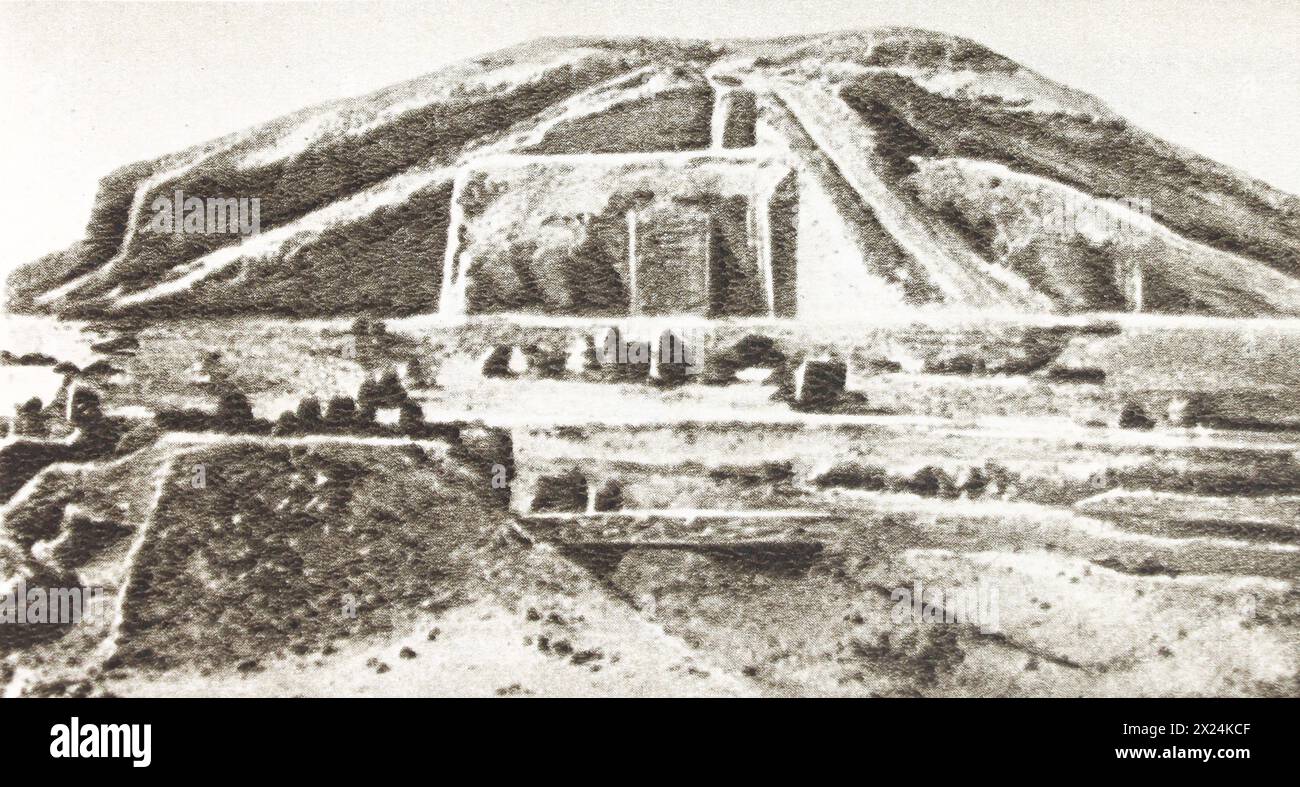 Excavation of a temple (ziggurat) of the ancient Sumerian city of Ur. Stock Photohttps://www.alamy.com/image-license-details/?v=1https://www.alamy.com/excavation-of-a-temple-ziggurat-of-the-ancient-sumerian-city-of-ur-image603695247.html
Excavation of a temple (ziggurat) of the ancient Sumerian city of Ur. Stock Photohttps://www.alamy.com/image-license-details/?v=1https://www.alamy.com/excavation-of-a-temple-ziggurat-of-the-ancient-sumerian-city-of-ur-image603695247.htmlRM2X24KCF–Excavation of a temple (ziggurat) of the ancient Sumerian city of Ur.
 The Great Ziggurat of Ur was built by the Neo-Sumerians in the reign of King Nabonidus 556-539 BC on the rubble of an older Stock Photohttps://www.alamy.com/image-license-details/?v=1https://www.alamy.com/stock-photo-the-great-ziggurat-of-ur-was-built-by-the-neo-sumerians-in-the-reign-50054428.html
The Great Ziggurat of Ur was built by the Neo-Sumerians in the reign of King Nabonidus 556-539 BC on the rubble of an older Stock Photohttps://www.alamy.com/image-license-details/?v=1https://www.alamy.com/stock-photo-the-great-ziggurat-of-ur-was-built-by-the-neo-sumerians-in-the-reign-50054428.htmlRMCWC4X4–The Great Ziggurat of Ur was built by the Neo-Sumerians in the reign of King Nabonidus 556-539 BC on the rubble of an older
 Ur-Engure inspecting the construction of The Ziggurat or Great Ziggurat of Ur. Ur-Nammu aka Ur-Namma, Ur-Engur, or Ur-Gur, ca. 2047-2030 BC. Founder of the Sumerian 3rd dynasty of Ur, in southern Mesopotamia. After the painting by Margaret Dovaston (1884-1954). From Hutchinson's History of the Nations, published 1915. Stock Photohttps://www.alamy.com/image-license-details/?v=1https://www.alamy.com/ur-engure-inspecting-the-construction-of-the-ziggurat-or-great-ziggurat-image155053108.html
Ur-Engure inspecting the construction of The Ziggurat or Great Ziggurat of Ur. Ur-Nammu aka Ur-Namma, Ur-Engur, or Ur-Gur, ca. 2047-2030 BC. Founder of the Sumerian 3rd dynasty of Ur, in southern Mesopotamia. After the painting by Margaret Dovaston (1884-1954). From Hutchinson's History of the Nations, published 1915. Stock Photohttps://www.alamy.com/image-license-details/?v=1https://www.alamy.com/ur-engure-inspecting-the-construction-of-the-ziggurat-or-great-ziggurat-image155053108.htmlRMK077R0–Ur-Engure inspecting the construction of The Ziggurat or Great Ziggurat of Ur. Ur-Nammu aka Ur-Namma, Ur-Engur, or Ur-Gur, ca. 2047-2030 BC. Founder of the Sumerian 3rd dynasty of Ur, in southern Mesopotamia. After the painting by Margaret Dovaston (1884-1954). From Hutchinson's History of the Nations, published 1915.
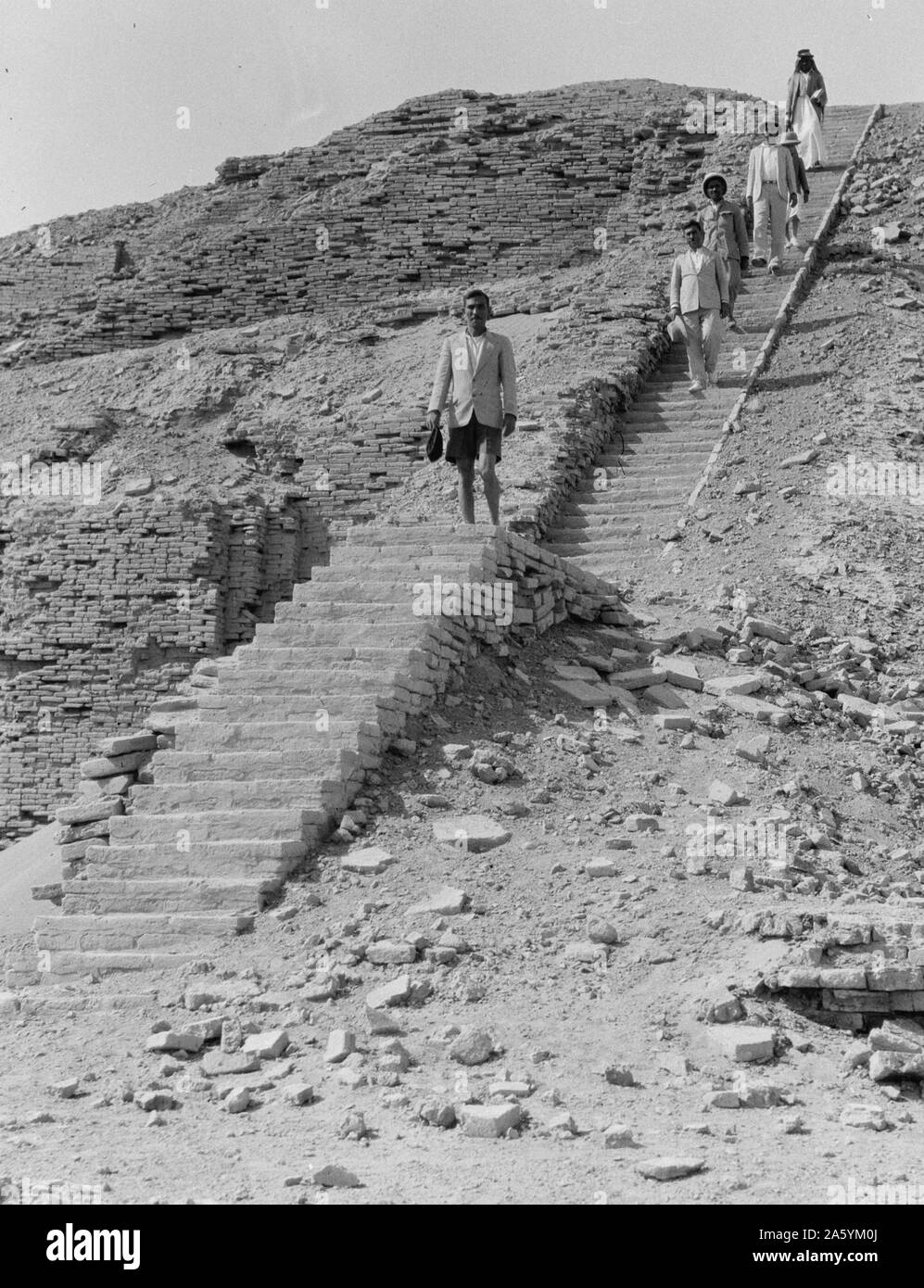 The reconstructed staircase of the Neo-Sumerian Great Ziggurat of Ur, near Nasiriya, Iraq. Ziggurats were built by the Sumerians, Babylonians, Elamites, Acadians, and Assyrians for local religions. Each ziggurat was part of a temple complex which included other buildings. The precursors of the ziggurat were raised platforms that date from the Ubaid period, during the fourth millennium BC. Stock Photohttps://www.alamy.com/image-license-details/?v=1https://www.alamy.com/the-reconstructed-staircase-of-the-neo-sumerian-great-ziggurat-of-ur-near-nasiriya-iraq-ziggurats-were-built-by-the-sumerians-babylonians-elamites-acadians-and-assyrians-for-local-religions-each-ziggurat-was-part-of-a-temple-complex-which-included-other-buildings-the-precursors-of-the-ziggurat-were-raised-platforms-that-date-from-the-ubaid-period-during-the-fourth-millennium-bc-image330678674.html
The reconstructed staircase of the Neo-Sumerian Great Ziggurat of Ur, near Nasiriya, Iraq. Ziggurats were built by the Sumerians, Babylonians, Elamites, Acadians, and Assyrians for local religions. Each ziggurat was part of a temple complex which included other buildings. The precursors of the ziggurat were raised platforms that date from the Ubaid period, during the fourth millennium BC. Stock Photohttps://www.alamy.com/image-license-details/?v=1https://www.alamy.com/the-reconstructed-staircase-of-the-neo-sumerian-great-ziggurat-of-ur-near-nasiriya-iraq-ziggurats-were-built-by-the-sumerians-babylonians-elamites-acadians-and-assyrians-for-local-religions-each-ziggurat-was-part-of-a-temple-complex-which-included-other-buildings-the-precursors-of-the-ziggurat-were-raised-platforms-that-date-from-the-ubaid-period-during-the-fourth-millennium-bc-image330678674.htmlRM2A5YM0J–The reconstructed staircase of the Neo-Sumerian Great Ziggurat of Ur, near Nasiriya, Iraq. Ziggurats were built by the Sumerians, Babylonians, Elamites, Acadians, and Assyrians for local religions. Each ziggurat was part of a temple complex which included other buildings. The precursors of the ziggurat were raised platforms that date from the Ubaid period, during the fourth millennium BC.
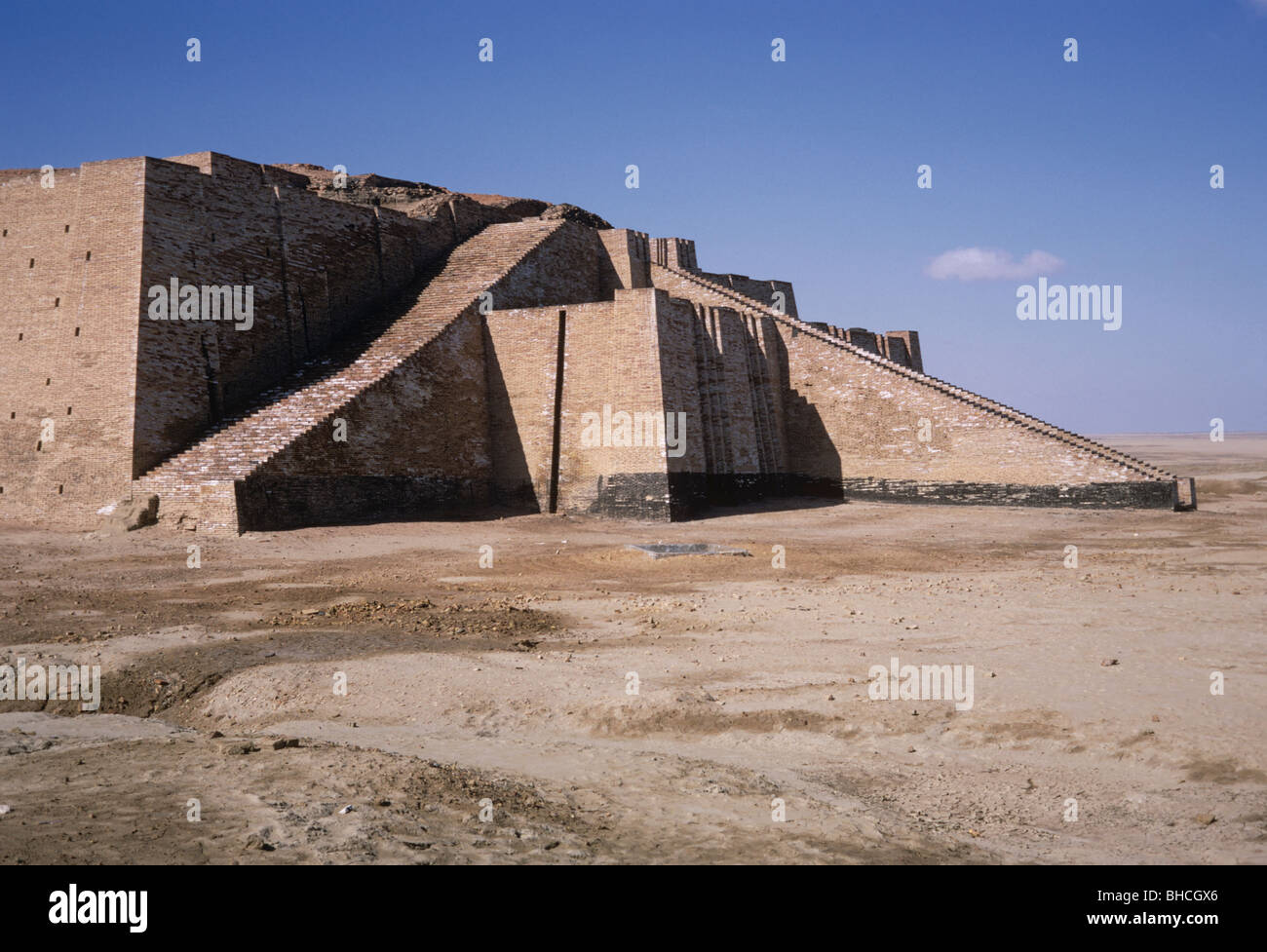 The Ziggurat of Ur-Nammu, Iraq 690131 006 Stock Photohttps://www.alamy.com/image-license-details/?v=1https://www.alamy.com/stock-photo-the-ziggurat-of-ur-nammu-iraq-690131-006-27936222.html
The Ziggurat of Ur-Nammu, Iraq 690131 006 Stock Photohttps://www.alamy.com/image-license-details/?v=1https://www.alamy.com/stock-photo-the-ziggurat-of-ur-nammu-iraq-690131-006-27936222.htmlRMBHCGX6–The Ziggurat of Ur-Nammu, Iraq 690131 006
 Mar 01, 2008 - Tallil, Iraq - The Ziggurat of Ur looms in the background of Sumerian ruins. The Ziggurat, an ancient temple that is more than 4,000 years old, was built by the Sumerians in honor of their moon god, Sin. About 95 percent of the city is still buried under the sand. (Credit Image: © A Stock Photohttps://www.alamy.com/image-license-details/?v=1https://www.alamy.com/stock-photo-mar-01-2008-tallil-iraq-the-ziggurat-of-ur-looms-in-the-background-42528952.html
Mar 01, 2008 - Tallil, Iraq - The Ziggurat of Ur looms in the background of Sumerian ruins. The Ziggurat, an ancient temple that is more than 4,000 years old, was built by the Sumerians in honor of their moon god, Sin. About 95 percent of the city is still buried under the sand. (Credit Image: © A Stock Photohttps://www.alamy.com/image-license-details/?v=1https://www.alamy.com/stock-photo-mar-01-2008-tallil-iraq-the-ziggurat-of-ur-looms-in-the-background-42528952.htmlRMCD5A34–Mar 01, 2008 - Tallil, Iraq - The Ziggurat of Ur looms in the background of Sumerian ruins. The Ziggurat, an ancient temple that is more than 4,000 years old, was built by the Sumerians in honor of their moon god, Sin. About 95 percent of the city is still buried under the sand. (Credit Image: © A
![The Great Ziggurat of Ur, near Nasiriya, Iraq. Ziggurats were built by the Sumerians, Babylonians, Elamites, Acadians, and Assyrians for local religions. Each ziggurat was part of a temple complex which included other buildings. The precursors of the ziggurat were raised platforms that date from the Ubaid period[1] during the fourth millennium BC. The earliest ziggurats began near the end of the Early Dynastic Period.[2] The latest Mesopotamian ziggurats date from the 6th century BC. Stock Photo The Great Ziggurat of Ur, near Nasiriya, Iraq. Ziggurats were built by the Sumerians, Babylonians, Elamites, Acadians, and Assyrians for local religions. Each ziggurat was part of a temple complex which included other buildings. The precursors of the ziggurat were raised platforms that date from the Ubaid period[1] during the fourth millennium BC. The earliest ziggurats began near the end of the Early Dynastic Period.[2] The latest Mesopotamian ziggurats date from the 6th century BC. Stock Photo](https://c8.alamy.com/comp/2A5YM14/the-great-ziggurat-of-ur-near-nasiriya-iraq-ziggurats-were-built-by-the-sumerians-babylonians-elamites-acadians-and-assyrians-for-local-religions-each-ziggurat-was-part-of-a-temple-complex-which-included-other-buildings-the-precursors-of-the-ziggurat-were-raised-platforms-that-date-from-the-ubaid-period-1-during-the-fourth-millennium-bc-the-earliest-ziggurats-began-near-the-end-of-the-early-dynastic-period-2-the-latest-mesopotamian-ziggurats-date-from-the-6th-century-bc-2A5YM14.jpg) The Great Ziggurat of Ur, near Nasiriya, Iraq. Ziggurats were built by the Sumerians, Babylonians, Elamites, Acadians, and Assyrians for local religions. Each ziggurat was part of a temple complex which included other buildings. The precursors of the ziggurat were raised platforms that date from the Ubaid period[1] during the fourth millennium BC. The earliest ziggurats began near the end of the Early Dynastic Period.[2] The latest Mesopotamian ziggurats date from the 6th century BC. Stock Photohttps://www.alamy.com/image-license-details/?v=1https://www.alamy.com/the-great-ziggurat-of-ur-near-nasiriya-iraq-ziggurats-were-built-by-the-sumerians-babylonians-elamites-acadians-and-assyrians-for-local-religions-each-ziggurat-was-part-of-a-temple-complex-which-included-other-buildings-the-precursors-of-the-ziggurat-were-raised-platforms-that-date-from-the-ubaid-period-1-during-the-fourth-millennium-bc-the-earliest-ziggurats-began-near-the-end-of-the-early-dynastic-period-2-the-latest-mesopotamian-ziggurats-date-from-the-6th-century-bc-image330678688.html
The Great Ziggurat of Ur, near Nasiriya, Iraq. Ziggurats were built by the Sumerians, Babylonians, Elamites, Acadians, and Assyrians for local religions. Each ziggurat was part of a temple complex which included other buildings. The precursors of the ziggurat were raised platforms that date from the Ubaid period[1] during the fourth millennium BC. The earliest ziggurats began near the end of the Early Dynastic Period.[2] The latest Mesopotamian ziggurats date from the 6th century BC. Stock Photohttps://www.alamy.com/image-license-details/?v=1https://www.alamy.com/the-great-ziggurat-of-ur-near-nasiriya-iraq-ziggurats-were-built-by-the-sumerians-babylonians-elamites-acadians-and-assyrians-for-local-religions-each-ziggurat-was-part-of-a-temple-complex-which-included-other-buildings-the-precursors-of-the-ziggurat-were-raised-platforms-that-date-from-the-ubaid-period-1-during-the-fourth-millennium-bc-the-earliest-ziggurats-began-near-the-end-of-the-early-dynastic-period-2-the-latest-mesopotamian-ziggurats-date-from-the-6th-century-bc-image330678688.htmlRM2A5YM14–The Great Ziggurat of Ur, near Nasiriya, Iraq. Ziggurats were built by the Sumerians, Babylonians, Elamites, Acadians, and Assyrians for local religions. Each ziggurat was part of a temple complex which included other buildings. The precursors of the ziggurat were raised platforms that date from the Ubaid period[1] during the fourth millennium BC. The earliest ziggurats began near the end of the Early Dynastic Period.[2] The latest Mesopotamian ziggurats date from the 6th century BC.
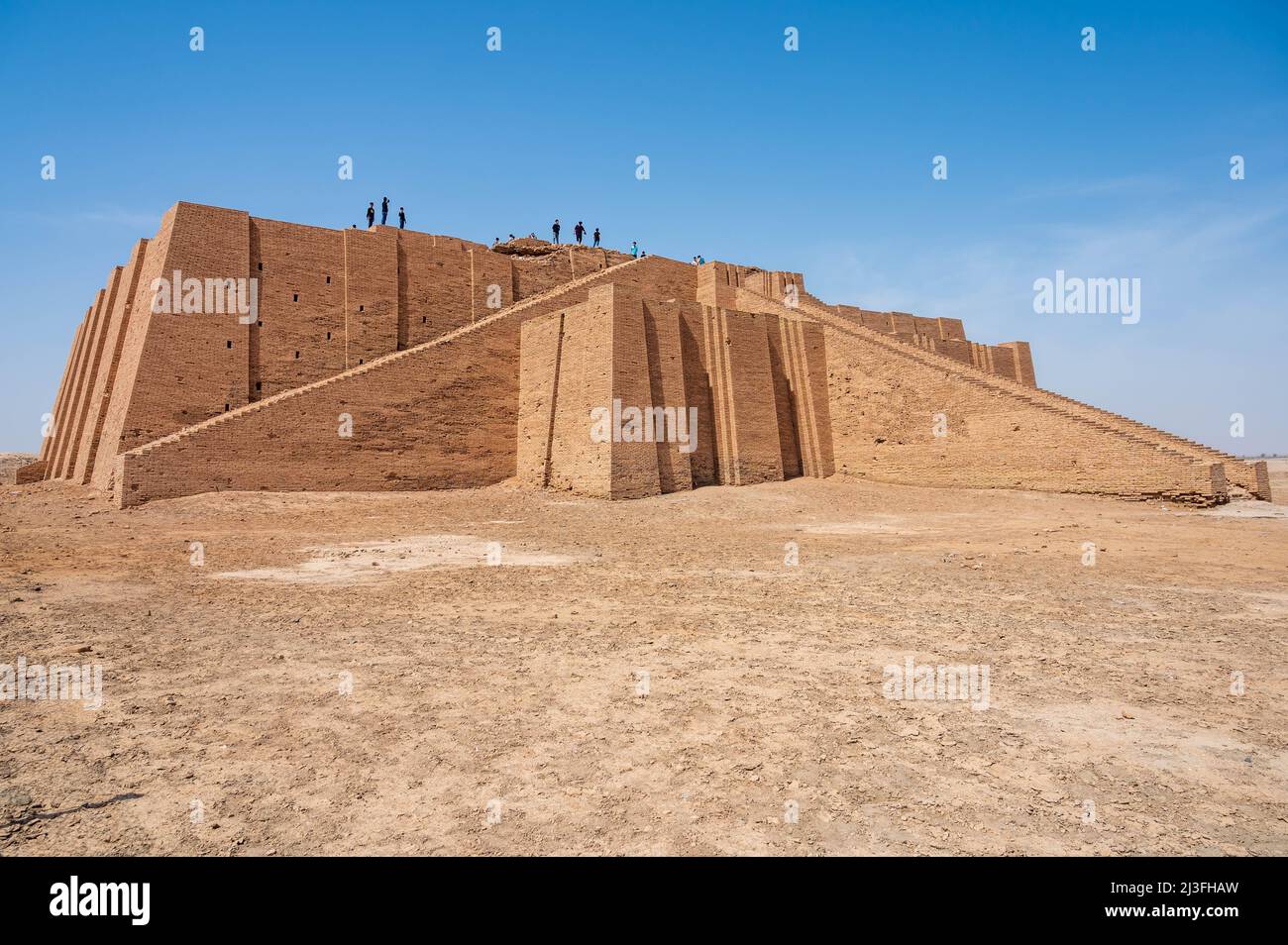 Ziggurat of Ur is a Neo-Sumerian ziggurat on the site of the ancient city of Ur near Nasiriyah, in present-day Dhi Qar Province, Iraq. The structure w Stock Photohttps://www.alamy.com/image-license-details/?v=1https://www.alamy.com/ziggurat-of-ur-is-a-neo-sumerian-ziggurat-on-the-site-of-the-ancient-city-of-ur-near-nasiriyah-in-present-day-dhi-qar-province-iraq-the-structure-w-image466866817.html
Ziggurat of Ur is a Neo-Sumerian ziggurat on the site of the ancient city of Ur near Nasiriyah, in present-day Dhi Qar Province, Iraq. The structure w Stock Photohttps://www.alamy.com/image-license-details/?v=1https://www.alamy.com/ziggurat-of-ur-is-a-neo-sumerian-ziggurat-on-the-site-of-the-ancient-city-of-ur-near-nasiriyah-in-present-day-dhi-qar-province-iraq-the-structure-w-image466866817.htmlRM2J3FHAW–Ziggurat of Ur is a Neo-Sumerian ziggurat on the site of the ancient city of Ur near Nasiriyah, in present-day Dhi Qar Province, Iraq. The structure w
 The ziggurat (tongue tower) at Birs Nimrud, known during the age of the Sumerian civilisation as Borsippa. Formerly taken to be Stock Photohttps://www.alamy.com/image-license-details/?v=1https://www.alamy.com/stock-photo-the-ziggurat-tongue-tower-at-birs-nimrud-known-during-the-age-of-the-131473498.html
The ziggurat (tongue tower) at Birs Nimrud, known during the age of the Sumerian civilisation as Borsippa. Formerly taken to be Stock Photohttps://www.alamy.com/image-license-details/?v=1https://www.alamy.com/stock-photo-the-ziggurat-tongue-tower-at-birs-nimrud-known-during-the-age-of-the-131473498.htmlRMHHW3P2–The ziggurat (tongue tower) at Birs Nimrud, known during the age of the Sumerian civilisation as Borsippa. Formerly taken to be
 The Ziggurat of Ur, located in the southeast of Iraq. Believed to be 4000 years old, it was built by the order of Ur-Nammu (c2047-2030 BC) as a temple to the moon god Nanna. Ancient Civilisation Sumerian Mesopotamia Stock Photohttps://www.alamy.com/image-license-details/?v=1https://www.alamy.com/stock-photo-the-ziggurat-of-ur-located-in-the-southeast-of-iraq-believed-to-be-57364467.html
The Ziggurat of Ur, located in the southeast of Iraq. Believed to be 4000 years old, it was built by the order of Ur-Nammu (c2047-2030 BC) as a temple to the moon god Nanna. Ancient Civilisation Sumerian Mesopotamia Stock Photohttps://www.alamy.com/image-license-details/?v=1https://www.alamy.com/stock-photo-the-ziggurat-of-ur-located-in-the-southeast-of-iraq-believed-to-be-57364467.htmlRMD994XY–The Ziggurat of Ur, located in the southeast of Iraq. Believed to be 4000 years old, it was built by the order of Ur-Nammu (c2047-2030 BC) as a temple to the moon god Nanna. Ancient Civilisation Sumerian Mesopotamia
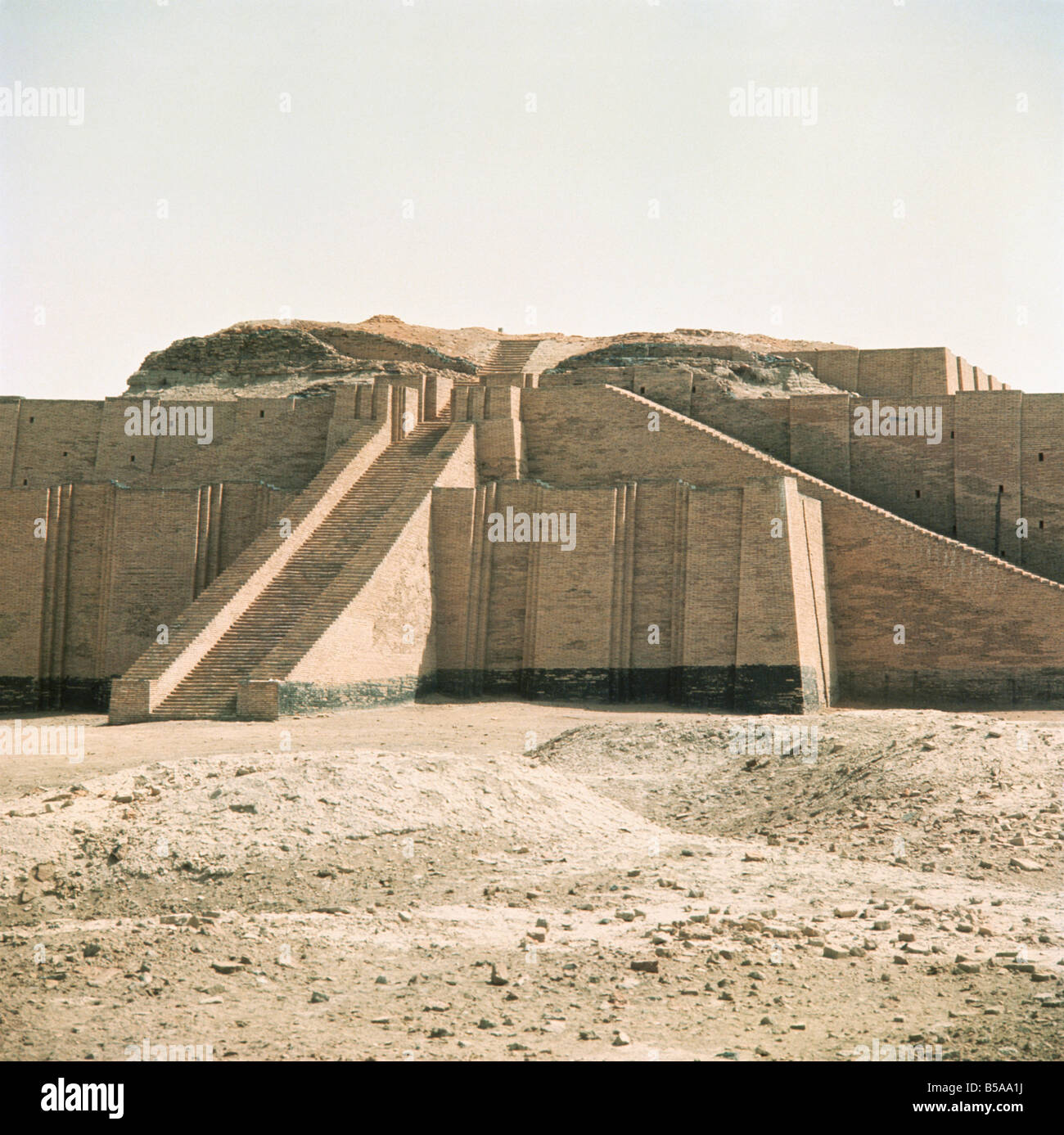 Ziggurat in Sumerian city dating from around 4500 400BC Ur Iraq Middle East Stock Photohttps://www.alamy.com/image-license-details/?v=1https://www.alamy.com/stock-photo-ziggurat-in-sumerian-city-dating-from-around-4500-400bc-ur-iraq-middle-20511054.html
Ziggurat in Sumerian city dating from around 4500 400BC Ur Iraq Middle East Stock Photohttps://www.alamy.com/image-license-details/?v=1https://www.alamy.com/stock-photo-ziggurat-in-sumerian-city-dating-from-around-4500-400bc-ur-iraq-middle-20511054.htmlRMB5AA1J–Ziggurat in Sumerian city dating from around 4500 400BC Ur Iraq Middle East
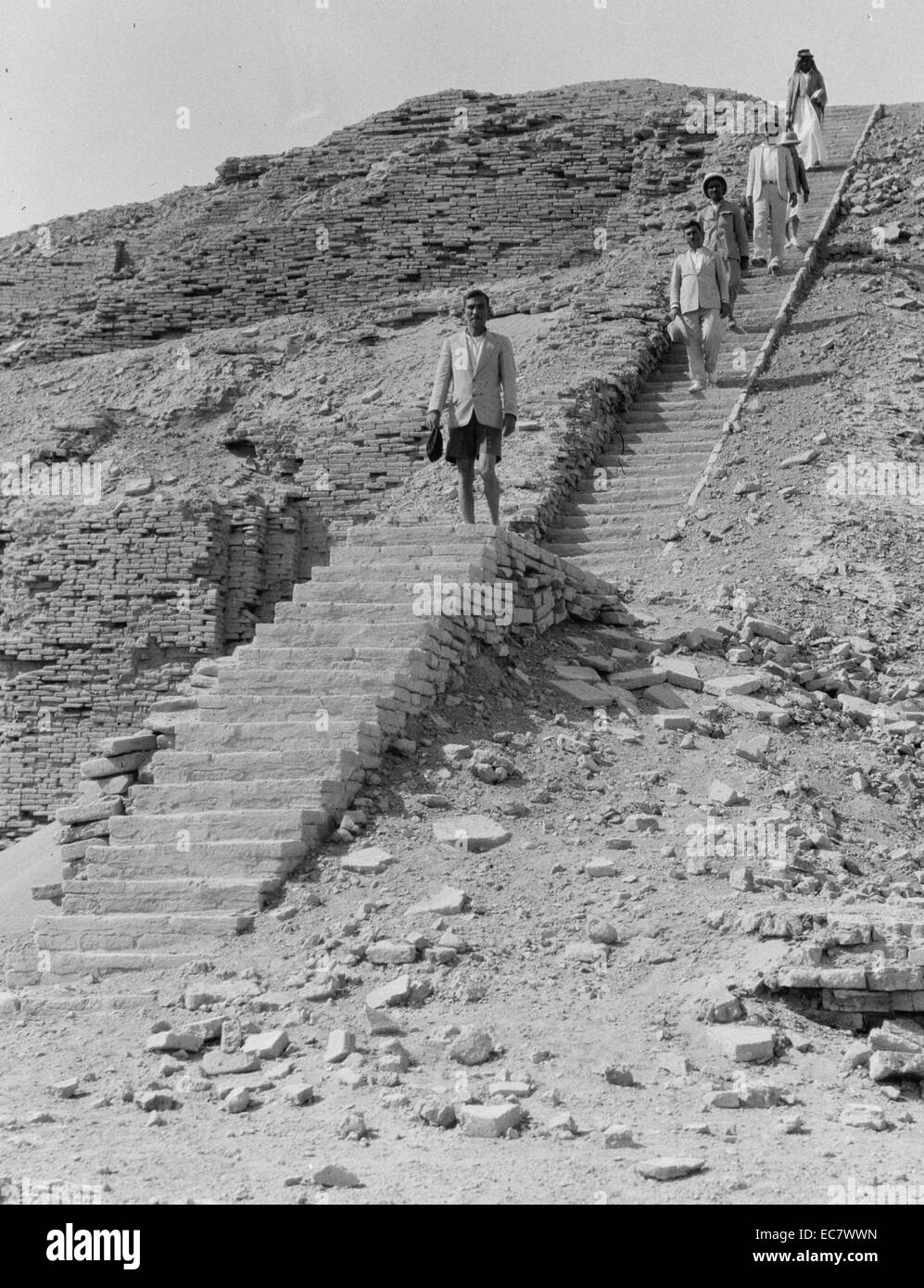 The reconstructed staircase of the Neo-Sumerian Great Ziggurat of Ur, near Nasiriya, Iraq. Ziggurats were built by the Sumerians, Babylonians, Elamites, Acadians, and Assyrians for local religions. Each ziggurat was part of a temple complex which included other buildings. The precursors of the ziggurat were raised platforms that date from the Ubaid period, during the fourth millennium BC. Stock Photohttps://www.alamy.com/image-license-details/?v=1https://www.alamy.com/stock-photo-the-reconstructed-staircase-of-the-neo-sumerian-great-ziggurat-of-76391329.html
The reconstructed staircase of the Neo-Sumerian Great Ziggurat of Ur, near Nasiriya, Iraq. Ziggurats were built by the Sumerians, Babylonians, Elamites, Acadians, and Assyrians for local religions. Each ziggurat was part of a temple complex which included other buildings. The precursors of the ziggurat were raised platforms that date from the Ubaid period, during the fourth millennium BC. Stock Photohttps://www.alamy.com/image-license-details/?v=1https://www.alamy.com/stock-photo-the-reconstructed-staircase-of-the-neo-sumerian-great-ziggurat-of-76391329.htmlRMEC7WWN–The reconstructed staircase of the Neo-Sumerian Great Ziggurat of Ur, near Nasiriya, Iraq. Ziggurats were built by the Sumerians, Babylonians, Elamites, Acadians, and Assyrians for local religions. Each ziggurat was part of a temple complex which included other buildings. The precursors of the ziggurat were raised platforms that date from the Ubaid period, during the fourth millennium BC.
 Marble antique wall arcade of the ancient world Stock Photohttps://www.alamy.com/image-license-details/?v=1https://www.alamy.com/marble-antique-wall-arcade-of-the-ancient-world-image558713639.html
Marble antique wall arcade of the ancient world Stock Photohttps://www.alamy.com/image-license-details/?v=1https://www.alamy.com/marble-antique-wall-arcade-of-the-ancient-world-image558713639.htmlRF2RCYGXF–Marble antique wall arcade of the ancient world
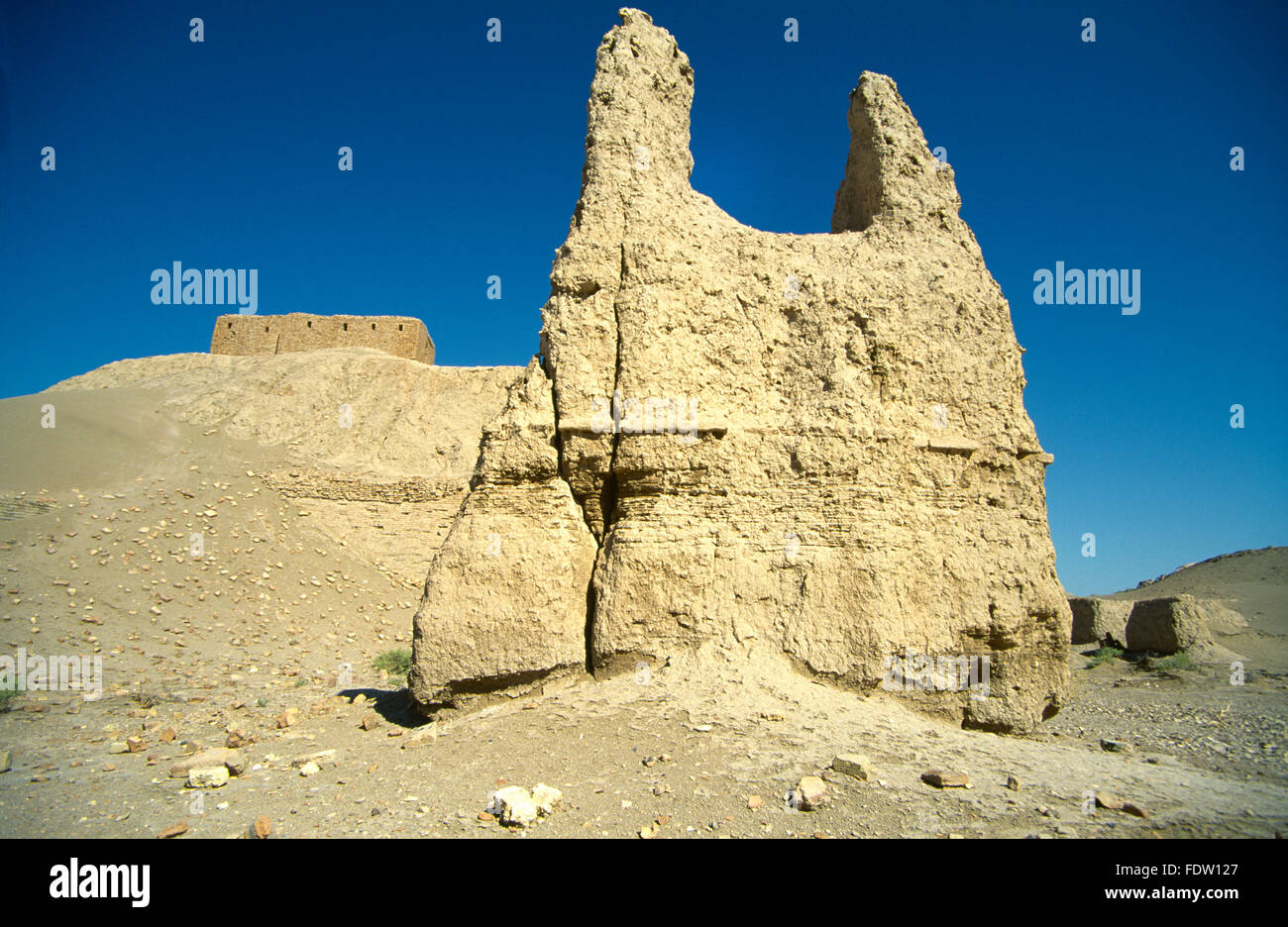 Nippur Iraq Square Ziggurat Dedicated God Enil Ancient Sumerian City Important Religious Capital From End Of The 4th Millennium Bc Stock Photohttps://www.alamy.com/image-license-details/?v=1https://www.alamy.com/stock-photo-nippur-iraq-square-ziggurat-dedicated-god-enil-ancient-sumerian-city-94592015.html
Nippur Iraq Square Ziggurat Dedicated God Enil Ancient Sumerian City Important Religious Capital From End Of The 4th Millennium Bc Stock Photohttps://www.alamy.com/image-license-details/?v=1https://www.alamy.com/stock-photo-nippur-iraq-square-ziggurat-dedicated-god-enil-ancient-sumerian-city-94592015.htmlRMFDW127–Nippur Iraq Square Ziggurat Dedicated God Enil Ancient Sumerian City Important Religious Capital From End Of The 4th Millennium Bc
 First Gulf War: 2nd April 1991 Coalition soldiers explore the ruins of the ancient Sumerian city of Ur in southern Iraq. In the background is the Great Ziggurat. Stock Photohttps://www.alamy.com/image-license-details/?v=1https://www.alamy.com/first-gulf-war-2nd-april-1991-coalition-soldiers-explore-the-ruins-of-the-ancient-sumerian-city-of-ur-in-southern-iraq-in-the-background-is-the-great-ziggurat-image605222701.html
First Gulf War: 2nd April 1991 Coalition soldiers explore the ruins of the ancient Sumerian city of Ur in southern Iraq. In the background is the Great Ziggurat. Stock Photohttps://www.alamy.com/image-license-details/?v=1https://www.alamy.com/first-gulf-war-2nd-april-1991-coalition-soldiers-explore-the-ruins-of-the-ancient-sumerian-city-of-ur-in-southern-iraq-in-the-background-is-the-great-ziggurat-image605222701.htmlRM2X4J7MD–First Gulf War: 2nd April 1991 Coalition soldiers explore the ruins of the ancient Sumerian city of Ur in southern Iraq. In the background is the Great Ziggurat.
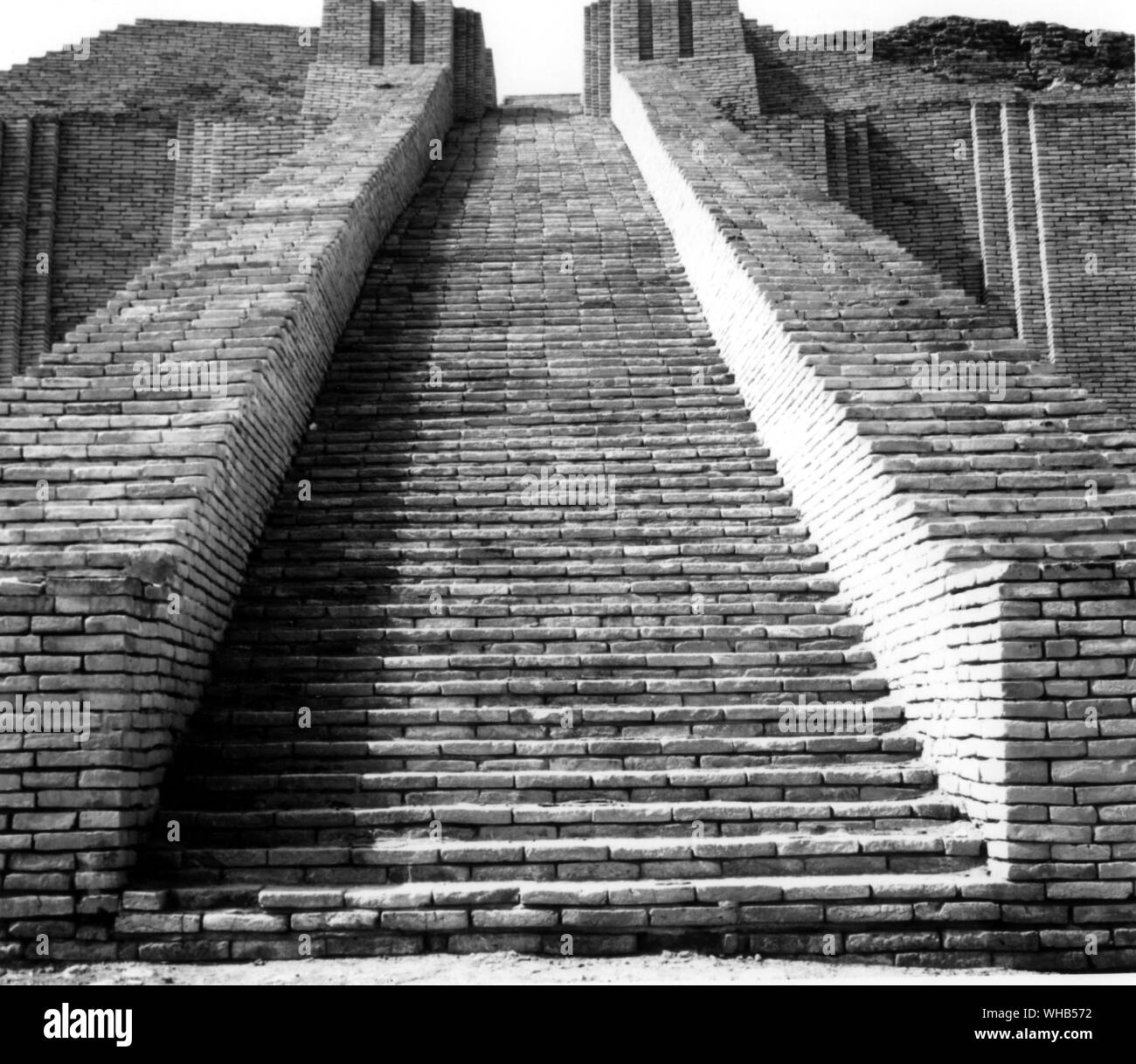 Ziggurat (a temple tower terraced pyramid of successively receding stories) steps in the ancient city of Ur, southern Mesopotamia, Iraq. Probably the Great Ziggurat, temple of Nanna, the moon deity in Sumerian mythology.. Stock Photohttps://www.alamy.com/image-license-details/?v=1https://www.alamy.com/ziggurat-a-temple-tower-terraced-pyramid-of-successively-receding-stories-steps-in-the-ancient-city-of-ur-southern-mesopotamia-iraq-probably-the-great-ziggurat-temple-of-nanna-the-moon-deity-in-sumerian-mythology-image268850262.html
Ziggurat (a temple tower terraced pyramid of successively receding stories) steps in the ancient city of Ur, southern Mesopotamia, Iraq. Probably the Great Ziggurat, temple of Nanna, the moon deity in Sumerian mythology.. Stock Photohttps://www.alamy.com/image-license-details/?v=1https://www.alamy.com/ziggurat-a-temple-tower-terraced-pyramid-of-successively-receding-stories-steps-in-the-ancient-city-of-ur-southern-mesopotamia-iraq-probably-the-great-ziggurat-temple-of-nanna-the-moon-deity-in-sumerian-mythology-image268850262.htmlRMWHB572–Ziggurat (a temple tower terraced pyramid of successively receding stories) steps in the ancient city of Ur, southern Mesopotamia, Iraq. Probably the Great Ziggurat, temple of Nanna, the moon deity in Sumerian mythology..
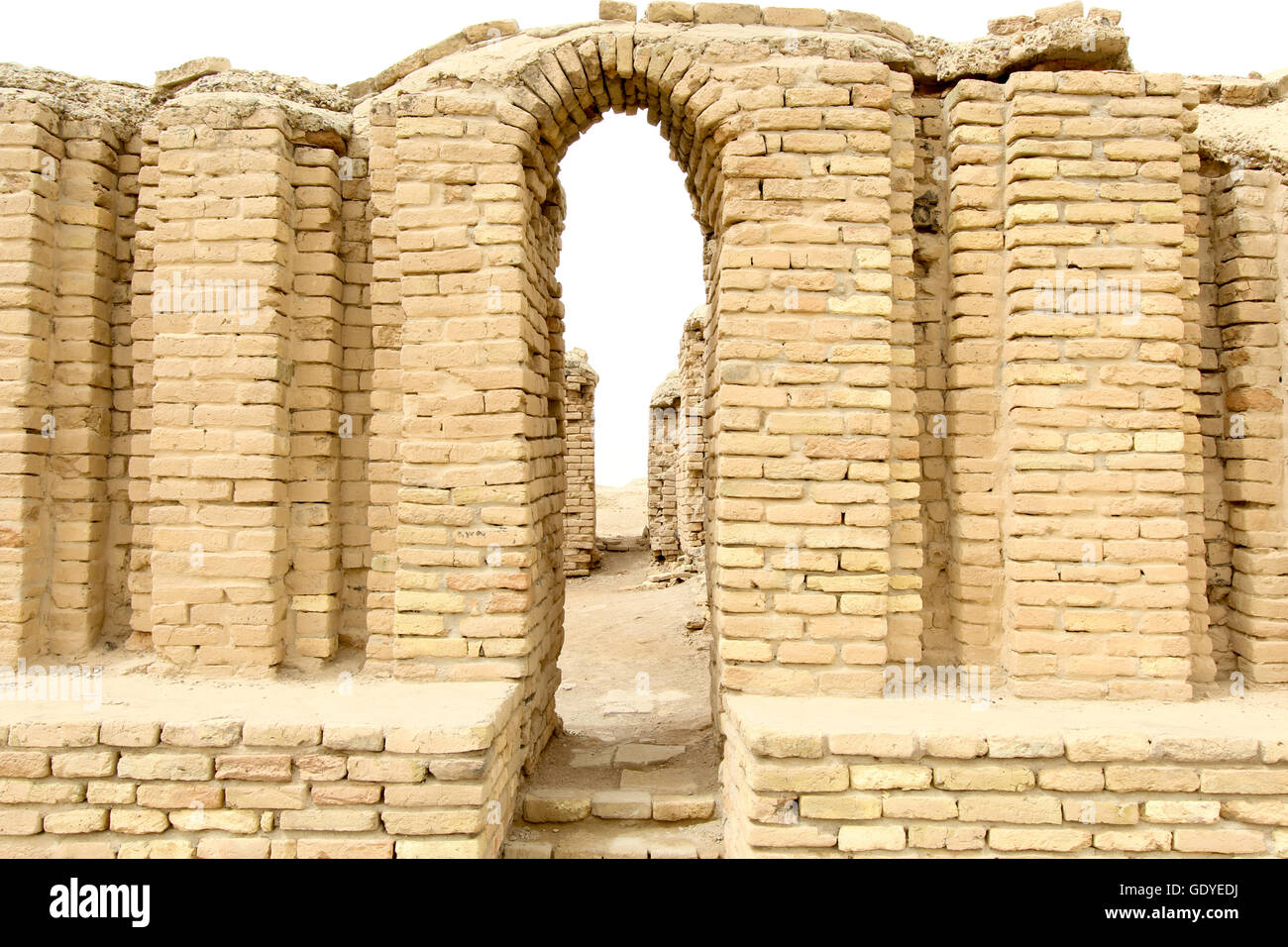 Picture of Ziggurat of Ur and one of the most important monuments in Iraq and that goes back to the Sumerian period which are located in the province of Dhi Qar in southern Iraq. Stock Photohttps://www.alamy.com/image-license-details/?v=1https://www.alamy.com/stock-photo-picture-of-ziggurat-of-ur-and-one-of-the-most-important-monuments-111856798.html
Picture of Ziggurat of Ur and one of the most important monuments in Iraq and that goes back to the Sumerian period which are located in the province of Dhi Qar in southern Iraq. Stock Photohttps://www.alamy.com/image-license-details/?v=1https://www.alamy.com/stock-photo-picture-of-ziggurat-of-ur-and-one-of-the-most-important-monuments-111856798.htmlRMGDYEDJ–Picture of Ziggurat of Ur and one of the most important monuments in Iraq and that goes back to the Sumerian period which are located in the province of Dhi Qar in southern Iraq.
 Restored ziggurat in ancient Ur, sumerian temple, Iraq Stock Photohttps://www.alamy.com/image-license-details/?v=1https://www.alamy.com/restored-ziggurat-in-ancient-ur-sumerian-temple-iraq-image183001951.html
Restored ziggurat in ancient Ur, sumerian temple, Iraq Stock Photohttps://www.alamy.com/image-license-details/?v=1https://www.alamy.com/restored-ziggurat-in-ancient-ur-sumerian-temple-iraq-image183001951.htmlRFMHMCRY–Restored ziggurat in ancient Ur, sumerian temple, Iraq
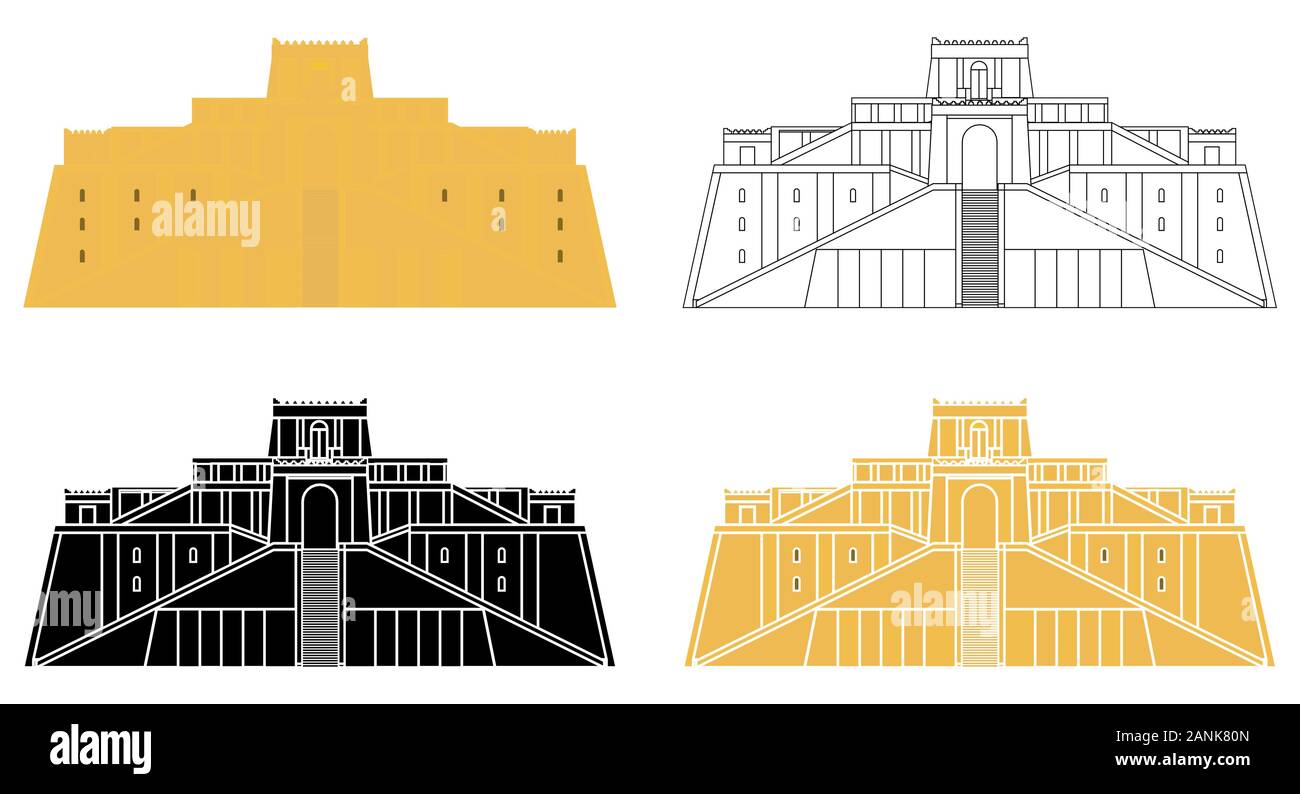 The great Ziggurat at Ur in front view Stock Vectorhttps://www.alamy.com/image-license-details/?v=1https://www.alamy.com/the-great-ziggurat-at-ur-in-front-view-image340328149.html
The great Ziggurat at Ur in front view Stock Vectorhttps://www.alamy.com/image-license-details/?v=1https://www.alamy.com/the-great-ziggurat-at-ur-in-front-view-image340328149.htmlRF2ANK80N–The great Ziggurat at Ur in front view
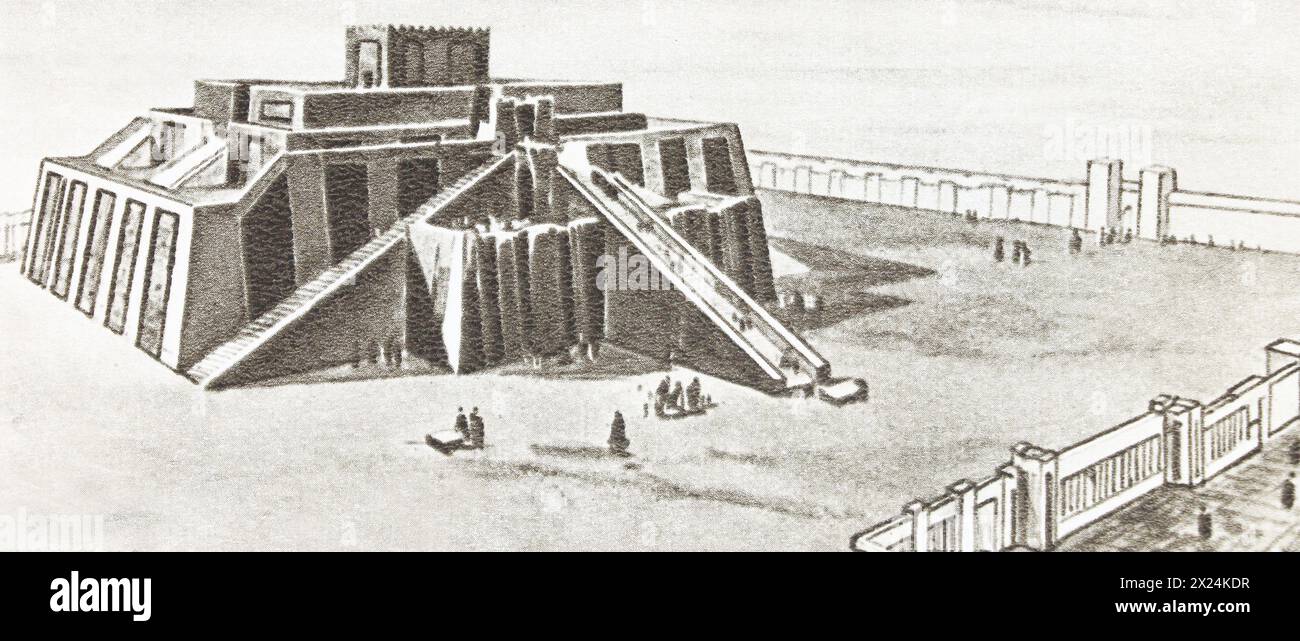 Temple (ziggurat) of the ancient Sumerian city of Ur. Reconstruction of the middle of the 20th century. Stock Photohttps://www.alamy.com/image-license-details/?v=1https://www.alamy.com/temple-ziggurat-of-the-ancient-sumerian-city-of-ur-reconstruction-of-the-middle-of-the-20th-century-image603695283.html
Temple (ziggurat) of the ancient Sumerian city of Ur. Reconstruction of the middle of the 20th century. Stock Photohttps://www.alamy.com/image-license-details/?v=1https://www.alamy.com/temple-ziggurat-of-the-ancient-sumerian-city-of-ur-reconstruction-of-the-middle-of-the-20th-century-image603695283.htmlRM2X24KDR–Temple (ziggurat) of the ancient Sumerian city of Ur. Reconstruction of the middle of the 20th century.
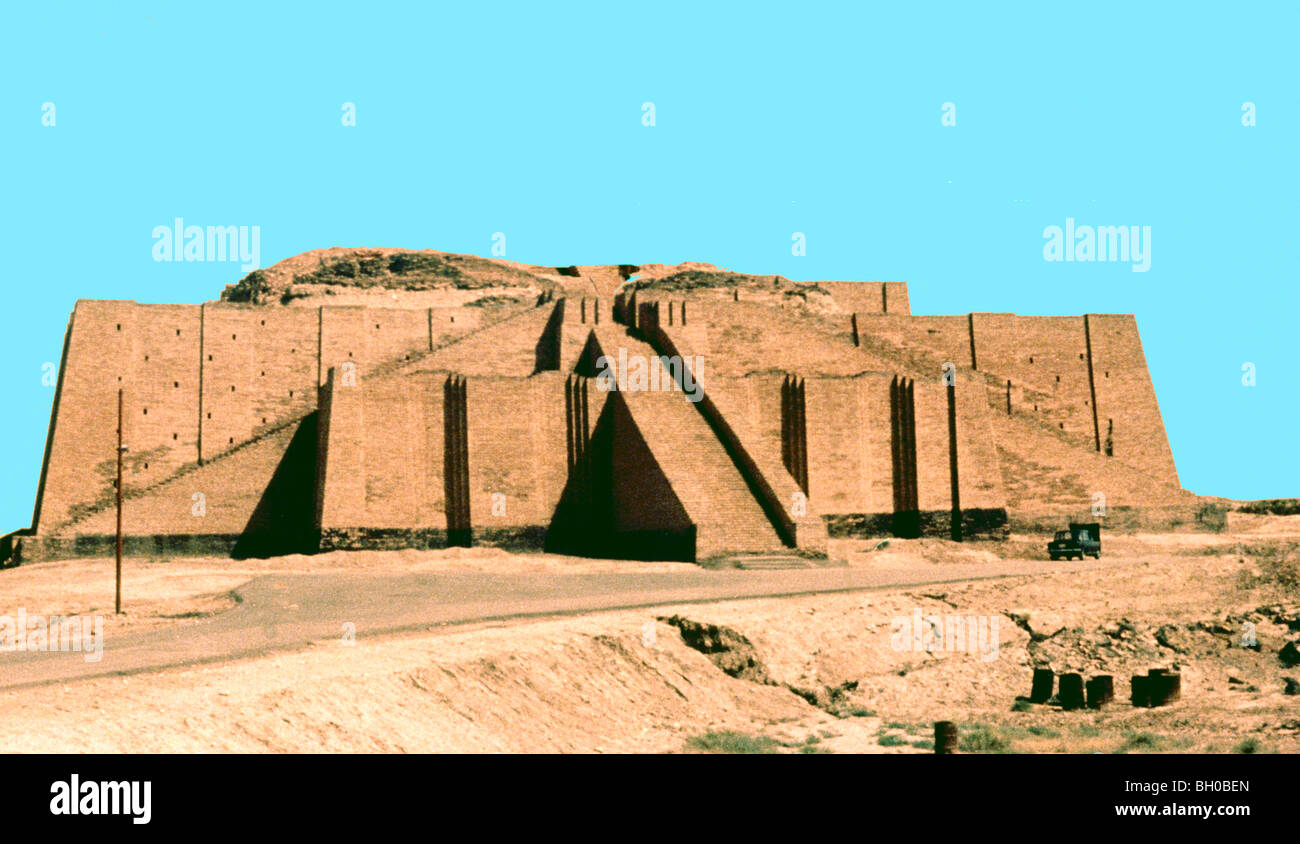 The famous ziggurat of Ur in Iraq Stock Photohttps://www.alamy.com/image-license-details/?v=1https://www.alamy.com/stock-photo-the-famous-ziggurat-of-ur-in-iraq-27668557.html
The famous ziggurat of Ur in Iraq Stock Photohttps://www.alamy.com/image-license-details/?v=1https://www.alamy.com/stock-photo-the-famous-ziggurat-of-ur-in-iraq-27668557.htmlRMBH0BEN–The famous ziggurat of Ur in Iraq
 Building a Ziggurat, the huge pyramidal temple towers which were first built in Sumerian City-States. After the painting by Margaret Dovaston (1884-1954). From Hutchinson's History of the Nations, published 1915. Stock Photohttps://www.alamy.com/image-license-details/?v=1https://www.alamy.com/building-a-ziggurat-the-huge-pyramidal-temple-towers-which-were-first-image155052900.html
Building a Ziggurat, the huge pyramidal temple towers which were first built in Sumerian City-States. After the painting by Margaret Dovaston (1884-1954). From Hutchinson's History of the Nations, published 1915. Stock Photohttps://www.alamy.com/image-license-details/?v=1https://www.alamy.com/building-a-ziggurat-the-huge-pyramidal-temple-towers-which-were-first-image155052900.htmlRMK077FG–Building a Ziggurat, the huge pyramidal temple towers which were first built in Sumerian City-States. After the painting by Margaret Dovaston (1884-1954). From Hutchinson's History of the Nations, published 1915.
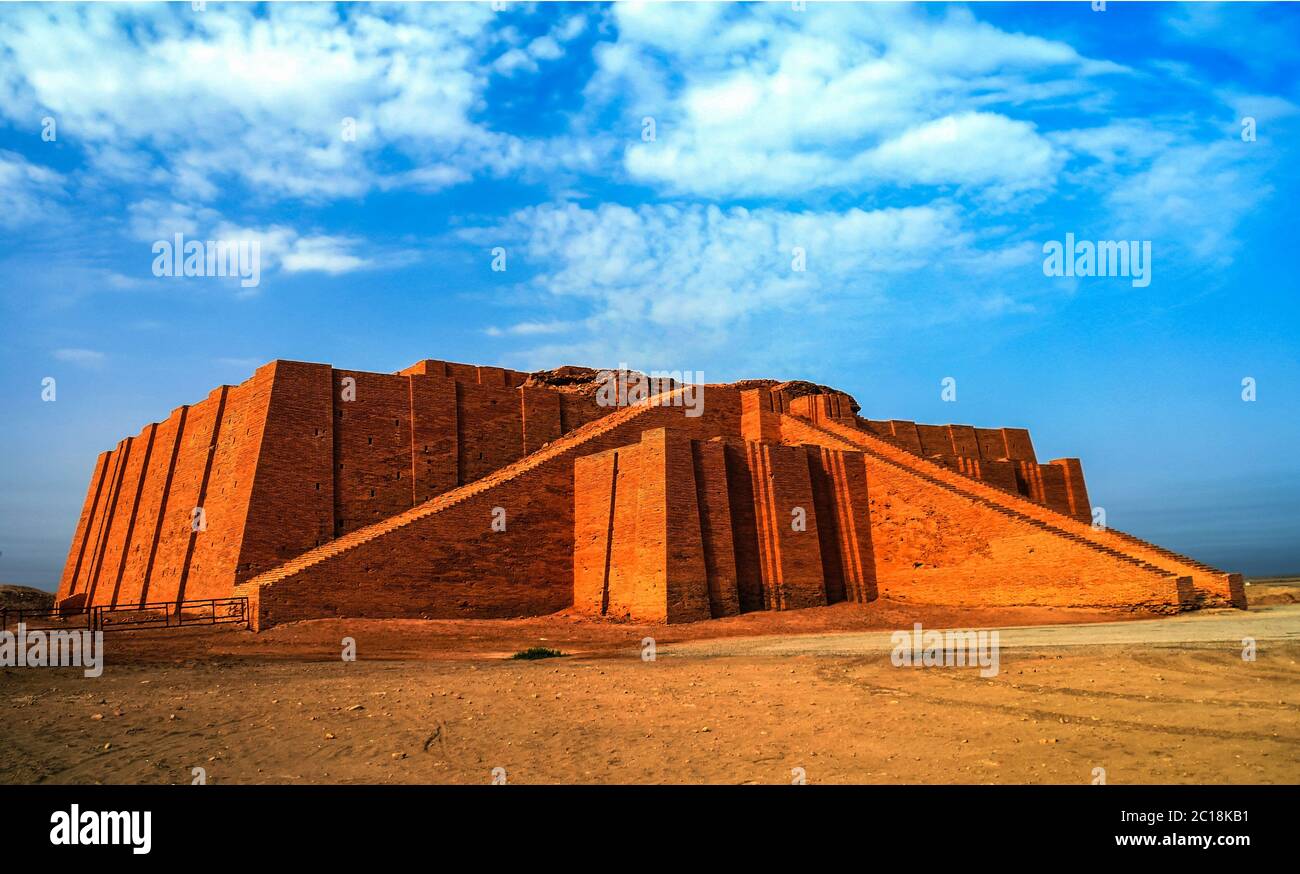 Restored ziggurat in ancient Ur, sumerian temple, Iraq Stock Photohttps://www.alamy.com/image-license-details/?v=1https://www.alamy.com/restored-ziggurat-in-ancient-ur-sumerian-temple-iraq-image362223205.html
Restored ziggurat in ancient Ur, sumerian temple, Iraq Stock Photohttps://www.alamy.com/image-license-details/?v=1https://www.alamy.com/restored-ziggurat-in-ancient-ur-sumerian-temple-iraq-image362223205.htmlRM2C18KB1–Restored ziggurat in ancient Ur, sumerian temple, Iraq
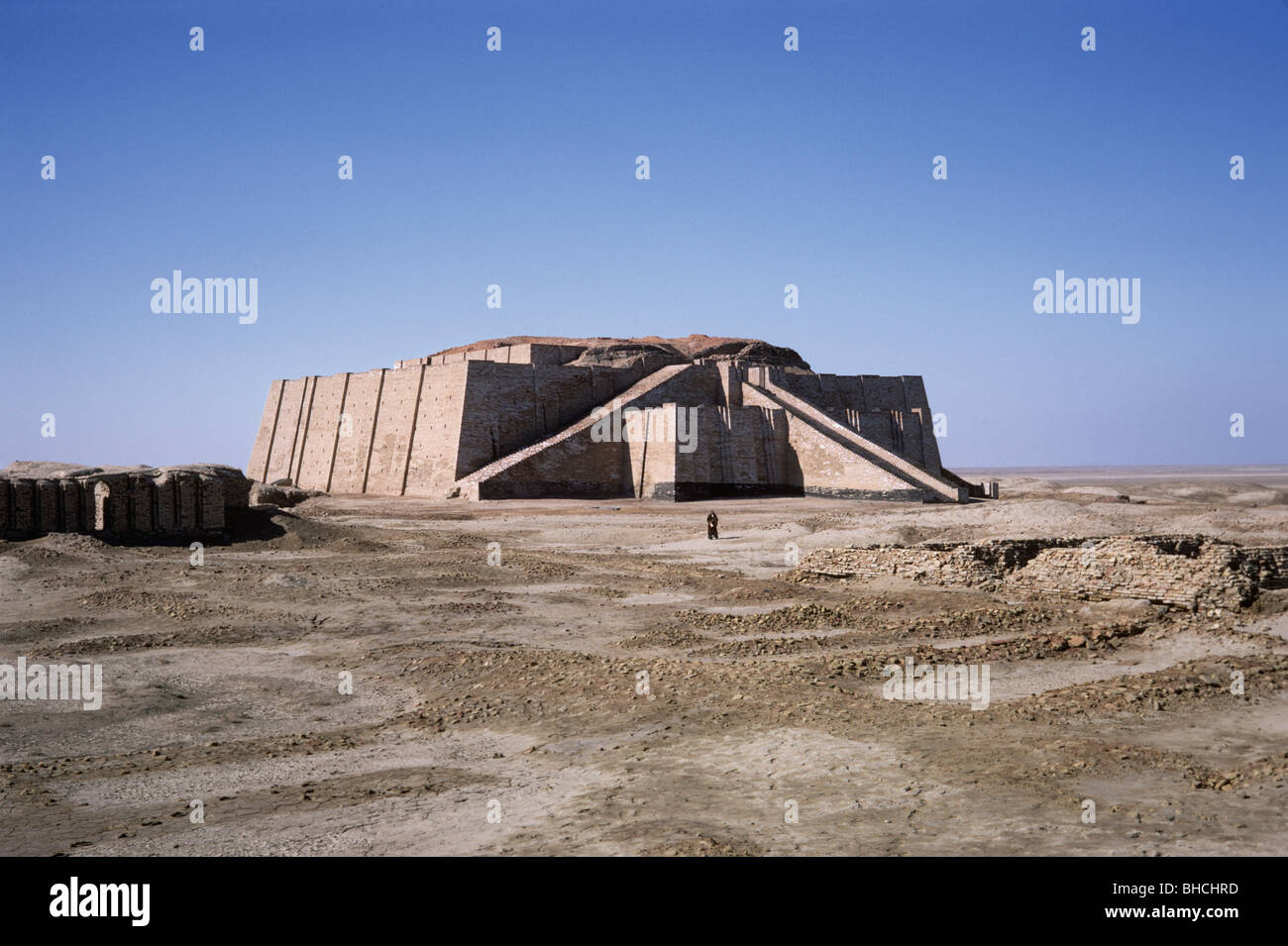 The guardian of the Ziggurat of Ur-Nammu, Iraq 690131 003 Stock Photohttps://www.alamy.com/image-license-details/?v=1https://www.alamy.com/stock-photo-the-guardian-of-the-ziggurat-of-ur-nammu-iraq-690131-003-27936929.html
The guardian of the Ziggurat of Ur-Nammu, Iraq 690131 003 Stock Photohttps://www.alamy.com/image-license-details/?v=1https://www.alamy.com/stock-photo-the-guardian-of-the-ziggurat-of-ur-nammu-iraq-690131-003-27936929.htmlRMBHCHRD–The guardian of the Ziggurat of Ur-Nammu, Iraq 690131 003
 (dpa files) - The Ziggurat of Ur, the former capital of Babylonia (undated). The site of Ur is known today as Tall al Muqayyar, in the south of Iraq. Ur means city in the Sumerian and Akkadian languages, and many cities were called by this name. Ur is mentioned in the bible as the home of Ibrahim (A Stock Photohttps://www.alamy.com/image-license-details/?v=1https://www.alamy.com/stock-photo-dpa-files-the-ziggurat-of-ur-the-former-capital-of-babylonia-undated-53733539.html
(dpa files) - The Ziggurat of Ur, the former capital of Babylonia (undated). The site of Ur is known today as Tall al Muqayyar, in the south of Iraq. Ur means city in the Sumerian and Akkadian languages, and many cities were called by this name. Ur is mentioned in the bible as the home of Ibrahim (A Stock Photohttps://www.alamy.com/image-license-details/?v=1https://www.alamy.com/stock-photo-dpa-files-the-ziggurat-of-ur-the-former-capital-of-babylonia-undated-53733539.htmlRMD3BNJY–(dpa files) - The Ziggurat of Ur, the former capital of Babylonia (undated). The site of Ur is known today as Tall al Muqayyar, in the south of Iraq. Ur means city in the Sumerian and Akkadian languages, and many cities were called by this name. Ur is mentioned in the bible as the home of Ibrahim (A
 Cuneiform tablet: Sumerian dedicatory(?) inscription from Ekur, the temple of the god Enlil, ca. 16th–15th century B.C Stock Photohttps://www.alamy.com/image-license-details/?v=1https://www.alamy.com/stock-image-cuneiform-tablet-sumerian-dedicatory-inscription-from-ekur-the-temple-162445156.html
Cuneiform tablet: Sumerian dedicatory(?) inscription from Ekur, the temple of the god Enlil, ca. 16th–15th century B.C Stock Photohttps://www.alamy.com/image-license-details/?v=1https://www.alamy.com/stock-image-cuneiform-tablet-sumerian-dedicatory-inscription-from-ekur-the-temple-162445156.htmlRMKC80CM–Cuneiform tablet: Sumerian dedicatory(?) inscription from Ekur, the temple of the god Enlil, ca. 16th–15th century B.C
 Ziggurat of Ur is a Neo-Sumerian ziggurat on the site of the ancient city of Ur near Nasiriyah, in present-day Dhi Qar Province, Iraq. The structure w Stock Photohttps://www.alamy.com/image-license-details/?v=1https://www.alamy.com/ziggurat-of-ur-is-a-neo-sumerian-ziggurat-on-the-site-of-the-ancient-city-of-ur-near-nasiriyah-in-present-day-dhi-qar-province-iraq-the-structure-w-image466866823.html
Ziggurat of Ur is a Neo-Sumerian ziggurat on the site of the ancient city of Ur near Nasiriyah, in present-day Dhi Qar Province, Iraq. The structure w Stock Photohttps://www.alamy.com/image-license-details/?v=1https://www.alamy.com/ziggurat-of-ur-is-a-neo-sumerian-ziggurat-on-the-site-of-the-ancient-city-of-ur-near-nasiriyah-in-present-day-dhi-qar-province-iraq-the-structure-w-image466866823.htmlRM2J3FHB3–Ziggurat of Ur is a Neo-Sumerian ziggurat on the site of the ancient city of Ur near Nasiriyah, in present-day Dhi Qar Province, Iraq. The structure w
 Art inspired by Cuneiform tablet: Sumerian dedicatory(?) inscription from Ekur, the temple of the god Enlil, Kassite, ca. 16th–15th century B.C., Mesopotamia, probably from Nippur, Kassite, Black marble, 8.25 x 9 x 1 in (20.96 x 22.86 x 2.55 cm), Stone-Tablets-Inscribed, The city of, Classic works modernized by Artotop with a splash of modernity. Shapes, color and value, eye-catching visual impact on art. Emotions through freedom of artworks in a contemporary way. A timeless message pursuing a wildly creative new direction. Artists turning to the digital medium and creating the Artotop NFT Stock Photohttps://www.alamy.com/image-license-details/?v=1https://www.alamy.com/art-inspired-by-cuneiform-tablet-sumerian-dedicatory-inscription-from-ekur-the-temple-of-the-god-enlil-kassite-ca-16th15th-century-bc-mesopotamia-probably-from-nippur-kassite-black-marble-825-x-9-x-1-in-2096-x-2286-x-255-cm-stone-tablets-inscribed-the-city-of-classic-works-modernized-by-artotop-with-a-splash-of-modernity-shapes-color-and-value-eye-catching-visual-impact-on-art-emotions-through-freedom-of-artworks-in-a-contemporary-way-a-timeless-message-pursuing-a-wildly-creative-new-direction-artists-turning-to-the-digital-medium-and-creating-the-artotop-nft-image462944649.html
Art inspired by Cuneiform tablet: Sumerian dedicatory(?) inscription from Ekur, the temple of the god Enlil, Kassite, ca. 16th–15th century B.C., Mesopotamia, probably from Nippur, Kassite, Black marble, 8.25 x 9 x 1 in (20.96 x 22.86 x 2.55 cm), Stone-Tablets-Inscribed, The city of, Classic works modernized by Artotop with a splash of modernity. Shapes, color and value, eye-catching visual impact on art. Emotions through freedom of artworks in a contemporary way. A timeless message pursuing a wildly creative new direction. Artists turning to the digital medium and creating the Artotop NFT Stock Photohttps://www.alamy.com/image-license-details/?v=1https://www.alamy.com/art-inspired-by-cuneiform-tablet-sumerian-dedicatory-inscription-from-ekur-the-temple-of-the-god-enlil-kassite-ca-16th15th-century-bc-mesopotamia-probably-from-nippur-kassite-black-marble-825-x-9-x-1-in-2096-x-2286-x-255-cm-stone-tablets-inscribed-the-city-of-classic-works-modernized-by-artotop-with-a-splash-of-modernity-shapes-color-and-value-eye-catching-visual-impact-on-art-emotions-through-freedom-of-artworks-in-a-contemporary-way-a-timeless-message-pursuing-a-wildly-creative-new-direction-artists-turning-to-the-digital-medium-and-creating-the-artotop-nft-image462944649.htmlRF2HW4XHD–Art inspired by Cuneiform tablet: Sumerian dedicatory(?) inscription from Ekur, the temple of the god Enlil, Kassite, ca. 16th–15th century B.C., Mesopotamia, probably from Nippur, Kassite, Black marble, 8.25 x 9 x 1 in (20.96 x 22.86 x 2.55 cm), Stone-Tablets-Inscribed, The city of, Classic works modernized by Artotop with a splash of modernity. Shapes, color and value, eye-catching visual impact on art. Emotions through freedom of artworks in a contemporary way. A timeless message pursuing a wildly creative new direction. Artists turning to the digital medium and creating the Artotop NFT
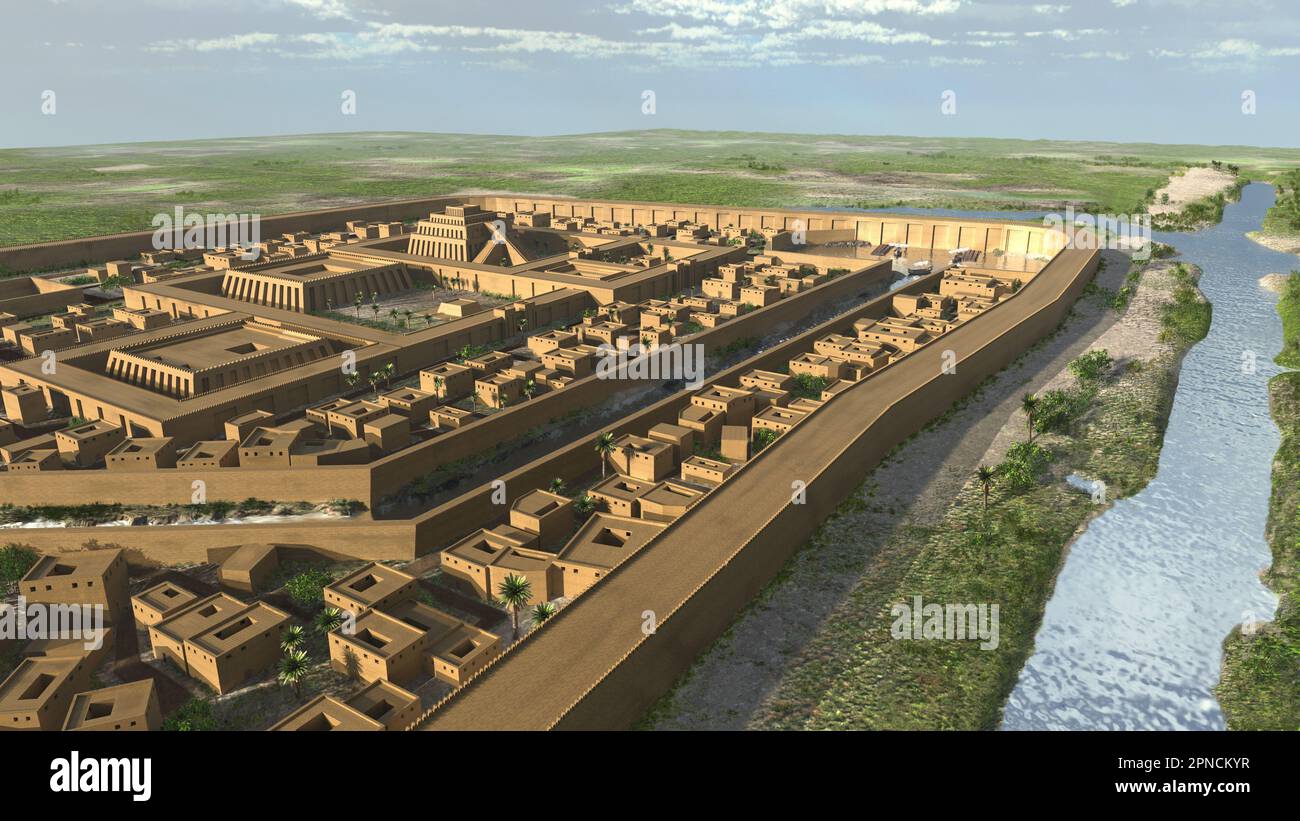 The ancient Sumerian city of Ur Stock Photohttps://www.alamy.com/image-license-details/?v=1https://www.alamy.com/the-ancient-sumerian-city-of-ur-image546708283.html
The ancient Sumerian city of Ur Stock Photohttps://www.alamy.com/image-license-details/?v=1https://www.alamy.com/the-ancient-sumerian-city-of-ur-image546708283.htmlRF2PNCKYR–The ancient Sumerian city of Ur
 Sumerian city dating from around 4500 400BC ziggurat and death pit Ur Iraq Middle East Stock Photohttps://www.alamy.com/image-license-details/?v=1https://www.alamy.com/stock-photo-sumerian-city-dating-from-around-4500-400bc-ziggurat-and-death-pit-20511051.html
Sumerian city dating from around 4500 400BC ziggurat and death pit Ur Iraq Middle East Stock Photohttps://www.alamy.com/image-license-details/?v=1https://www.alamy.com/stock-photo-sumerian-city-dating-from-around-4500-400bc-ziggurat-and-death-pit-20511051.htmlRMB5AA1F–Sumerian city dating from around 4500 400BC ziggurat and death pit Ur Iraq Middle East
![The Great Ziggurat of Ur, near Nasiriya, Iraq. Ziggurats were built by the Sumerians, Babylonians, Elamites, Acadians, and Assyrians for local religions. Each ziggurat was part of a temple complex which included other buildings. The precursors of the ziggurat were raised platforms that date from the Ubaid period[1] during the fourth millennium BC. The earliest ziggurats began near the end of the Early Dynastic Period.[2] The latest Mesopotamian ziggurats date from the 6th century BC. Stock Photo The Great Ziggurat of Ur, near Nasiriya, Iraq. Ziggurats were built by the Sumerians, Babylonians, Elamites, Acadians, and Assyrians for local religions. Each ziggurat was part of a temple complex which included other buildings. The precursors of the ziggurat were raised platforms that date from the Ubaid period[1] during the fourth millennium BC. The earliest ziggurats began near the end of the Early Dynastic Period.[2] The latest Mesopotamian ziggurats date from the 6th century BC. Stock Photo](https://c8.alamy.com/comp/EC7WX8/the-great-ziggurat-of-ur-near-nasiriya-iraq-ziggurats-were-built-by-EC7WX8.jpg) The Great Ziggurat of Ur, near Nasiriya, Iraq. Ziggurats were built by the Sumerians, Babylonians, Elamites, Acadians, and Assyrians for local religions. Each ziggurat was part of a temple complex which included other buildings. The precursors of the ziggurat were raised platforms that date from the Ubaid period[1] during the fourth millennium BC. The earliest ziggurats began near the end of the Early Dynastic Period.[2] The latest Mesopotamian ziggurats date from the 6th century BC. Stock Photohttps://www.alamy.com/image-license-details/?v=1https://www.alamy.com/stock-photo-the-great-ziggurat-of-ur-near-nasiriya-iraq-ziggurats-were-built-by-76391344.html
The Great Ziggurat of Ur, near Nasiriya, Iraq. Ziggurats were built by the Sumerians, Babylonians, Elamites, Acadians, and Assyrians for local religions. Each ziggurat was part of a temple complex which included other buildings. The precursors of the ziggurat were raised platforms that date from the Ubaid period[1] during the fourth millennium BC. The earliest ziggurats began near the end of the Early Dynastic Period.[2] The latest Mesopotamian ziggurats date from the 6th century BC. Stock Photohttps://www.alamy.com/image-license-details/?v=1https://www.alamy.com/stock-photo-the-great-ziggurat-of-ur-near-nasiriya-iraq-ziggurats-were-built-by-76391344.htmlRMEC7WX8–The Great Ziggurat of Ur, near Nasiriya, Iraq. Ziggurats were built by the Sumerians, Babylonians, Elamites, Acadians, and Assyrians for local religions. Each ziggurat was part of a temple complex which included other buildings. The precursors of the ziggurat were raised platforms that date from the Ubaid period[1] during the fourth millennium BC. The earliest ziggurats began near the end of the Early Dynastic Period.[2] The latest Mesopotamian ziggurats date from the 6th century BC.
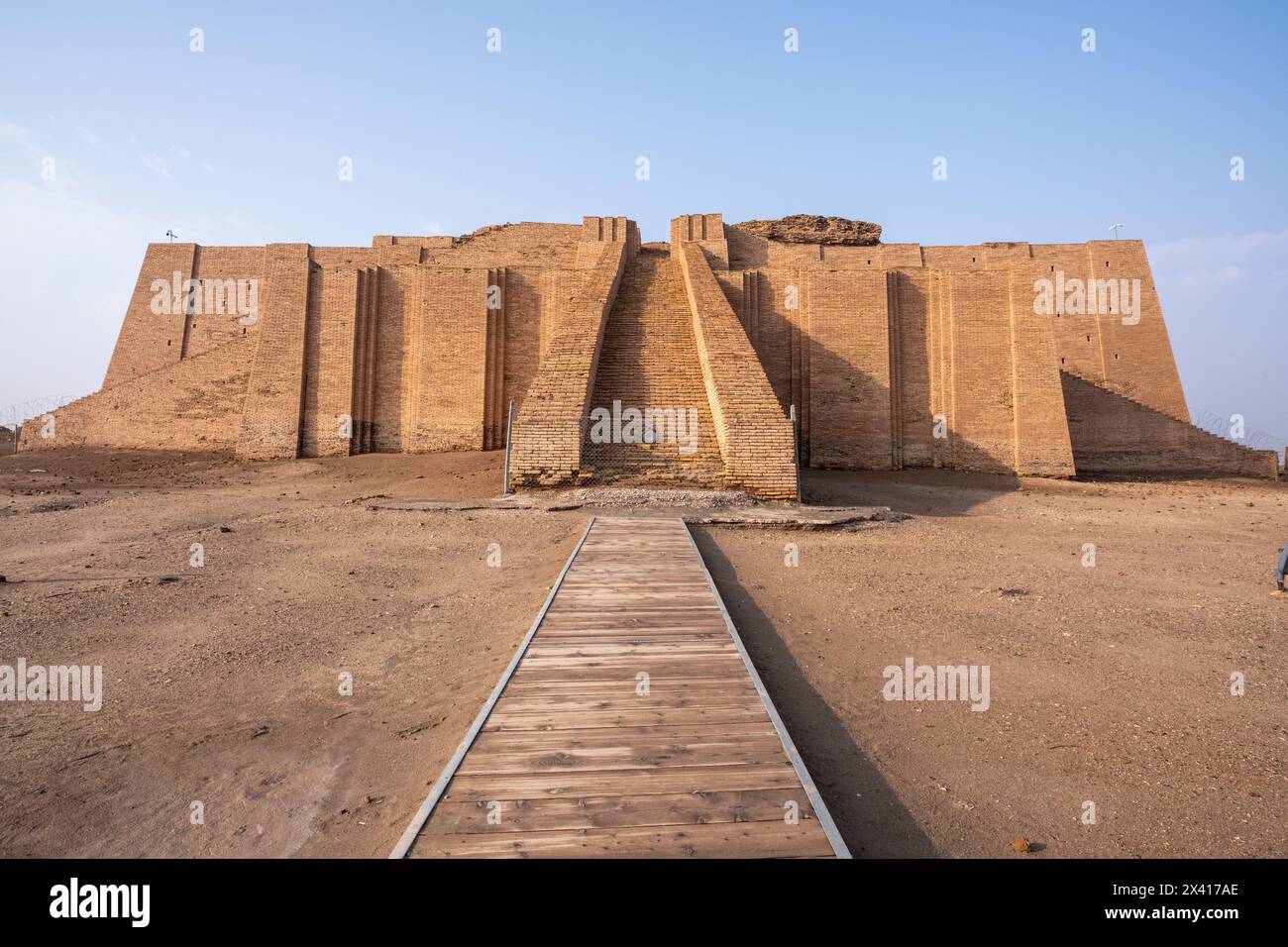 ziggurat of ur in iraq Stock Photohttps://www.alamy.com/image-license-details/?v=1https://www.alamy.com/ziggurat-of-ur-in-iraq-image604849238.html
ziggurat of ur in iraq Stock Photohttps://www.alamy.com/image-license-details/?v=1https://www.alamy.com/ziggurat-of-ur-in-iraq-image604849238.htmlRF2X417AE–ziggurat of ur in iraq
 Temple accounts dealing with receipts and expenditure of corn. 42nd year of Shulgi, 3rd Dynasty of Ur, Assyrian, Iraq. Shulgi of Ur was the second king of the 'Sumerian Renaissance' in the Third Dynasty of Ur. He reigned for 48 years, from 2029 BCE–1982 BCE. His accomplishments include the completion of construction of the Great Ziggurat of Ur. Stock Photohttps://www.alamy.com/image-license-details/?v=1https://www.alamy.com/stock-photo-temple-accounts-dealing-with-receipts-and-expenditure-of-corn-42nd-90828306.html
Temple accounts dealing with receipts and expenditure of corn. 42nd year of Shulgi, 3rd Dynasty of Ur, Assyrian, Iraq. Shulgi of Ur was the second king of the 'Sumerian Renaissance' in the Third Dynasty of Ur. He reigned for 48 years, from 2029 BCE–1982 BCE. His accomplishments include the completion of construction of the Great Ziggurat of Ur. Stock Photohttps://www.alamy.com/image-license-details/?v=1https://www.alamy.com/stock-photo-temple-accounts-dealing-with-receipts-and-expenditure-of-corn-42nd-90828306.htmlRMF7NGC2–Temple accounts dealing with receipts and expenditure of corn. 42nd year of Shulgi, 3rd Dynasty of Ur, Assyrian, Iraq. Shulgi of Ur was the second king of the 'Sumerian Renaissance' in the Third Dynasty of Ur. He reigned for 48 years, from 2029 BCE–1982 BCE. His accomplishments include the completion of construction of the Great Ziggurat of Ur.
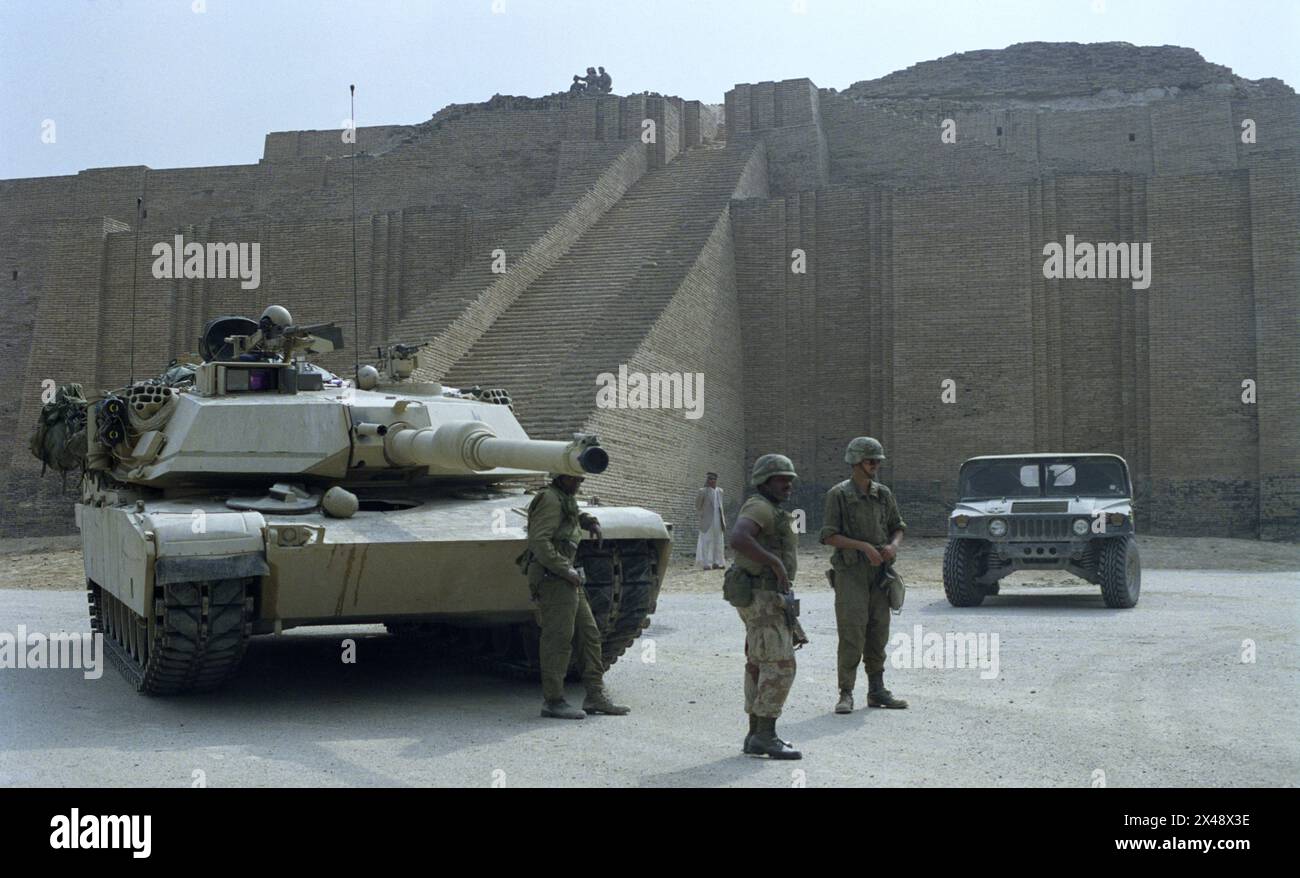 First Gulf War: 2nd April 1991 U.S. Army soldiers stand next to an M1A1 Abrams tank in front of the Great Ziggurat of Ur in southern Iraq. Stock Photohttps://www.alamy.com/image-license-details/?v=1https://www.alamy.com/first-gulf-war-2nd-april-1991-us-army-soldiers-stand-next-to-an-m1a1-abrams-tank-in-front-of-the-great-ziggurat-of-ur-in-southern-iraq-image605017602.html
First Gulf War: 2nd April 1991 U.S. Army soldiers stand next to an M1A1 Abrams tank in front of the Great Ziggurat of Ur in southern Iraq. Stock Photohttps://www.alamy.com/image-license-details/?v=1https://www.alamy.com/first-gulf-war-2nd-april-1991-us-army-soldiers-stand-next-to-an-m1a1-abrams-tank-in-front-of-the-great-ziggurat-of-ur-in-southern-iraq-image605017602.htmlRM2X48X3E–First Gulf War: 2nd April 1991 U.S. Army soldiers stand next to an M1A1 Abrams tank in front of the Great Ziggurat of Ur in southern Iraq.
 Great Ziggurat of Ur, Iraq, 1977. Stock Photohttps://www.alamy.com/image-license-details/?v=1https://www.alamy.com/stock-photo-great-ziggurat-of-ur-iraq-1977-74091107.html
Great Ziggurat of Ur, Iraq, 1977. Stock Photohttps://www.alamy.com/image-license-details/?v=1https://www.alamy.com/stock-photo-great-ziggurat-of-ur-iraq-1977-74091107.htmlRME8F3XY–Great Ziggurat of Ur, Iraq, 1977.
 Picture of Ziggurat of Ur and one of the most important monuments in Iraq and that goes back to the Sumerian period which are located in the province of Dhi Qar in southern Iraq. Stock Photohttps://www.alamy.com/image-license-details/?v=1https://www.alamy.com/stock-photo-picture-of-ziggurat-of-ur-and-one-of-the-most-important-monuments-111856772.html
Picture of Ziggurat of Ur and one of the most important monuments in Iraq and that goes back to the Sumerian period which are located in the province of Dhi Qar in southern Iraq. Stock Photohttps://www.alamy.com/image-license-details/?v=1https://www.alamy.com/stock-photo-picture-of-ziggurat-of-ur-and-one-of-the-most-important-monuments-111856772.htmlRMGDYECM–Picture of Ziggurat of Ur and one of the most important monuments in Iraq and that goes back to the Sumerian period which are located in the province of Dhi Qar in southern Iraq.
 The Ziggurat of Ur, located in the southeast of Iraq. Believed to be 4000 years old, it was built by the order of Ur-Nammu as a temple to the sumerian moon god Nanna Stock Photohttps://www.alamy.com/image-license-details/?v=1https://www.alamy.com/the-ziggurat-of-ur-located-in-the-southeast-of-iraq-believed-to-be-4000-years-old-it-was-built-by-the-order-of-ur-nammu-as-a-temple-to-the-sumerian-moon-god-nanna-image257285214.html
The Ziggurat of Ur, located in the southeast of Iraq. Believed to be 4000 years old, it was built by the order of Ur-Nammu as a temple to the sumerian moon god Nanna Stock Photohttps://www.alamy.com/image-license-details/?v=1https://www.alamy.com/the-ziggurat-of-ur-located-in-the-southeast-of-iraq-believed-to-be-4000-years-old-it-was-built-by-the-order-of-ur-nammu-as-a-temple-to-the-sumerian-moon-god-nanna-image257285214.htmlRMTXG9WJ–The Ziggurat of Ur, located in the southeast of Iraq. Believed to be 4000 years old, it was built by the order of Ur-Nammu as a temple to the sumerian moon god Nanna
 The great Ziggurat at Ur in perspective view Stock Vectorhttps://www.alamy.com/image-license-details/?v=1https://www.alamy.com/the-great-ziggurat-at-ur-in-perspective-view-image340328157.html
The great Ziggurat at Ur in perspective view Stock Vectorhttps://www.alamy.com/image-license-details/?v=1https://www.alamy.com/the-great-ziggurat-at-ur-in-perspective-view-image340328157.htmlRF2ANK811–The great Ziggurat at Ur in perspective view
 Fragment of the stela of kites - a monument to the victory of King Eannatum over the city of Umma. Photo from the middle of the 20th century. Stock Photohttps://www.alamy.com/image-license-details/?v=1https://www.alamy.com/fragment-of-the-stela-of-kites-a-monument-to-the-victory-of-king-eannatum-over-the-city-of-umma-photo-from-the-middle-of-the-20th-century-image603695250.html
Fragment of the stela of kites - a monument to the victory of King Eannatum over the city of Umma. Photo from the middle of the 20th century. Stock Photohttps://www.alamy.com/image-license-details/?v=1https://www.alamy.com/fragment-of-the-stela-of-kites-a-monument-to-the-victory-of-king-eannatum-over-the-city-of-umma-photo-from-the-middle-of-the-20th-century-image603695250.htmlRM2X24KCJ–Fragment of the stela of kites - a monument to the victory of King Eannatum over the city of Umma. Photo from the middle of the 20th century.
 The Great Ziggurat of Ur was built by the Neo-Sumerians built under King Nabonidus 556-539 BC on the rubble of an older Sumerian structure constructed by Sumerian King Ur-Nammu ca 2100 BC. In the foreground are ancient burial grounds. May 18 2010. (BSLOC 2011 12 398) Stock Photohttps://www.alamy.com/image-license-details/?v=1https://www.alamy.com/stock-photo-the-great-ziggurat-of-ur-was-built-by-the-neo-sumerians-built-under-38134946.html
The Great Ziggurat of Ur was built by the Neo-Sumerians built under King Nabonidus 556-539 BC on the rubble of an older Sumerian structure constructed by Sumerian King Ur-Nammu ca 2100 BC. In the foreground are ancient burial grounds. May 18 2010. (BSLOC 2011 12 398) Stock Photohttps://www.alamy.com/image-license-details/?v=1https://www.alamy.com/stock-photo-the-great-ziggurat-of-ur-was-built-by-the-neo-sumerians-built-under-38134946.htmlRMC615EA–The Great Ziggurat of Ur was built by the Neo-Sumerians built under King Nabonidus 556-539 BC on the rubble of an older Sumerian structure constructed by Sumerian King Ur-Nammu ca 2100 BC. In the foreground are ancient burial grounds. May 18 2010. (BSLOC 2011 12 398)
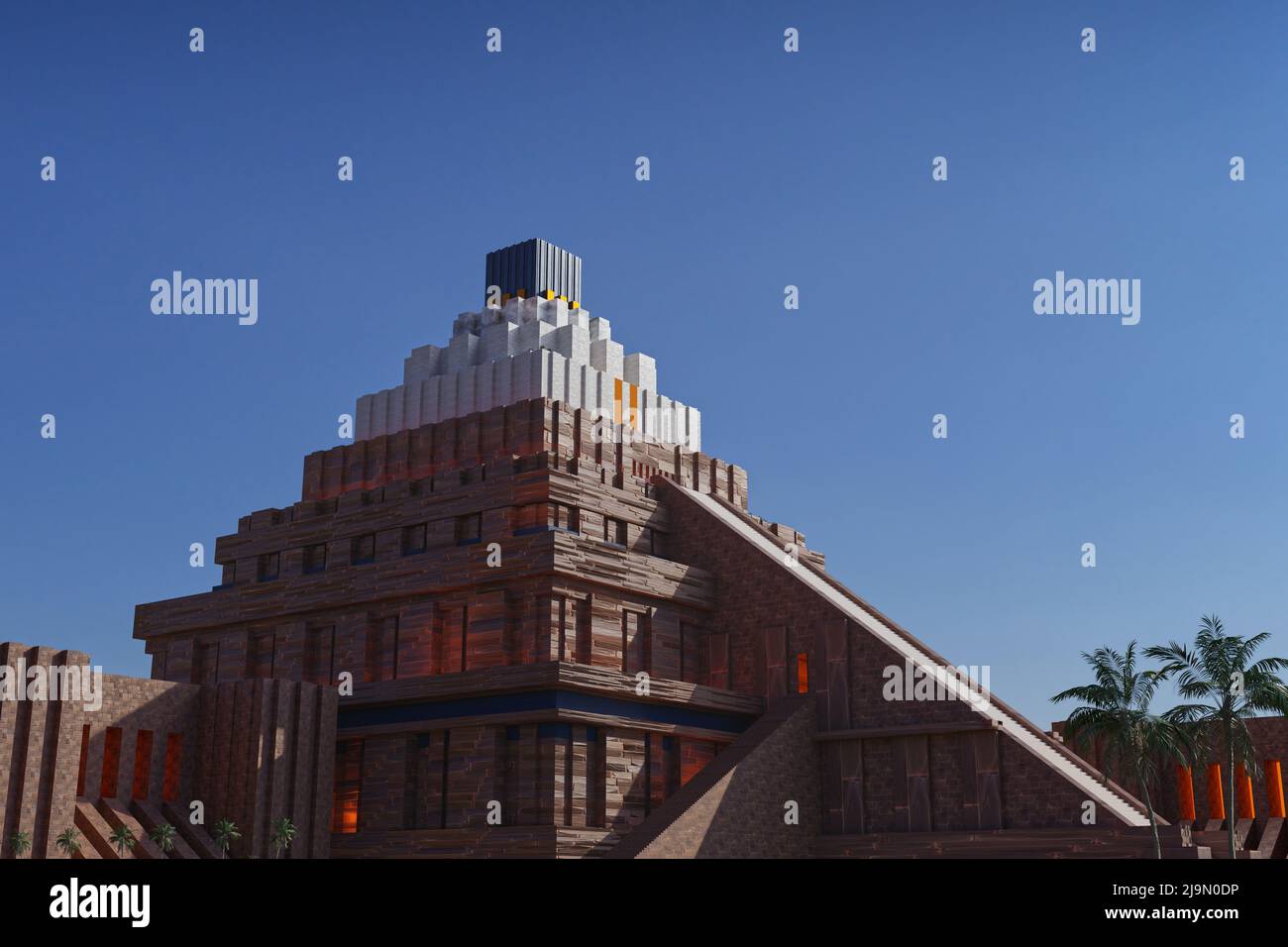 Tower of Babel as Ziggurat in Mesopotamia Stock Photohttps://www.alamy.com/image-license-details/?v=1https://www.alamy.com/tower-of-babel-as-ziggurat-in-mesopotamia-image470673218.html
Tower of Babel as Ziggurat in Mesopotamia Stock Photohttps://www.alamy.com/image-license-details/?v=1https://www.alamy.com/tower-of-babel-as-ziggurat-in-mesopotamia-image470673218.htmlRF2J9N0DP–Tower of Babel as Ziggurat in Mesopotamia
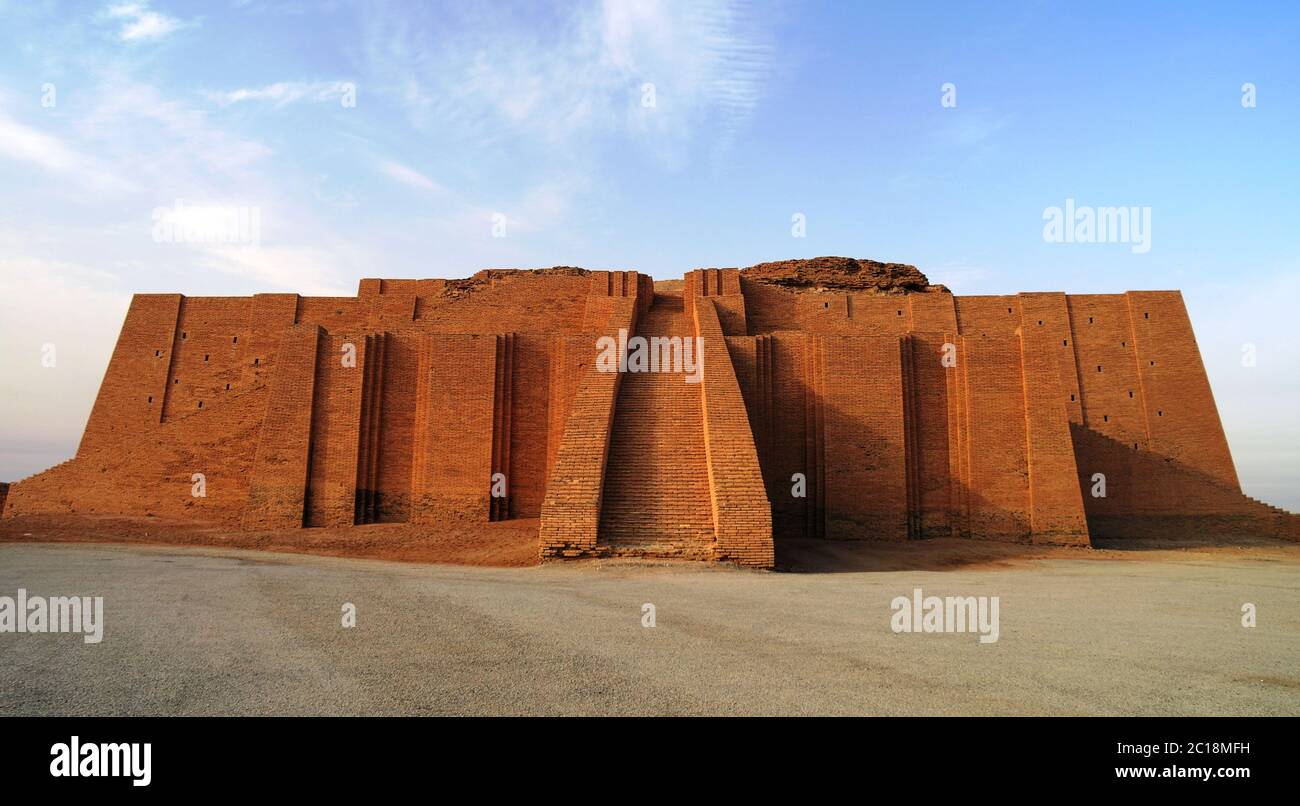 Restored ziggurat in ancient Ur, sumerian temple, Iraq Stock Photohttps://www.alamy.com/image-license-details/?v=1https://www.alamy.com/restored-ziggurat-in-ancient-ur-sumerian-temple-iraq-image362224117.html
Restored ziggurat in ancient Ur, sumerian temple, Iraq Stock Photohttps://www.alamy.com/image-license-details/?v=1https://www.alamy.com/restored-ziggurat-in-ancient-ur-sumerian-temple-iraq-image362224117.htmlRM2C18MFH–Restored ziggurat in ancient Ur, sumerian temple, Iraq
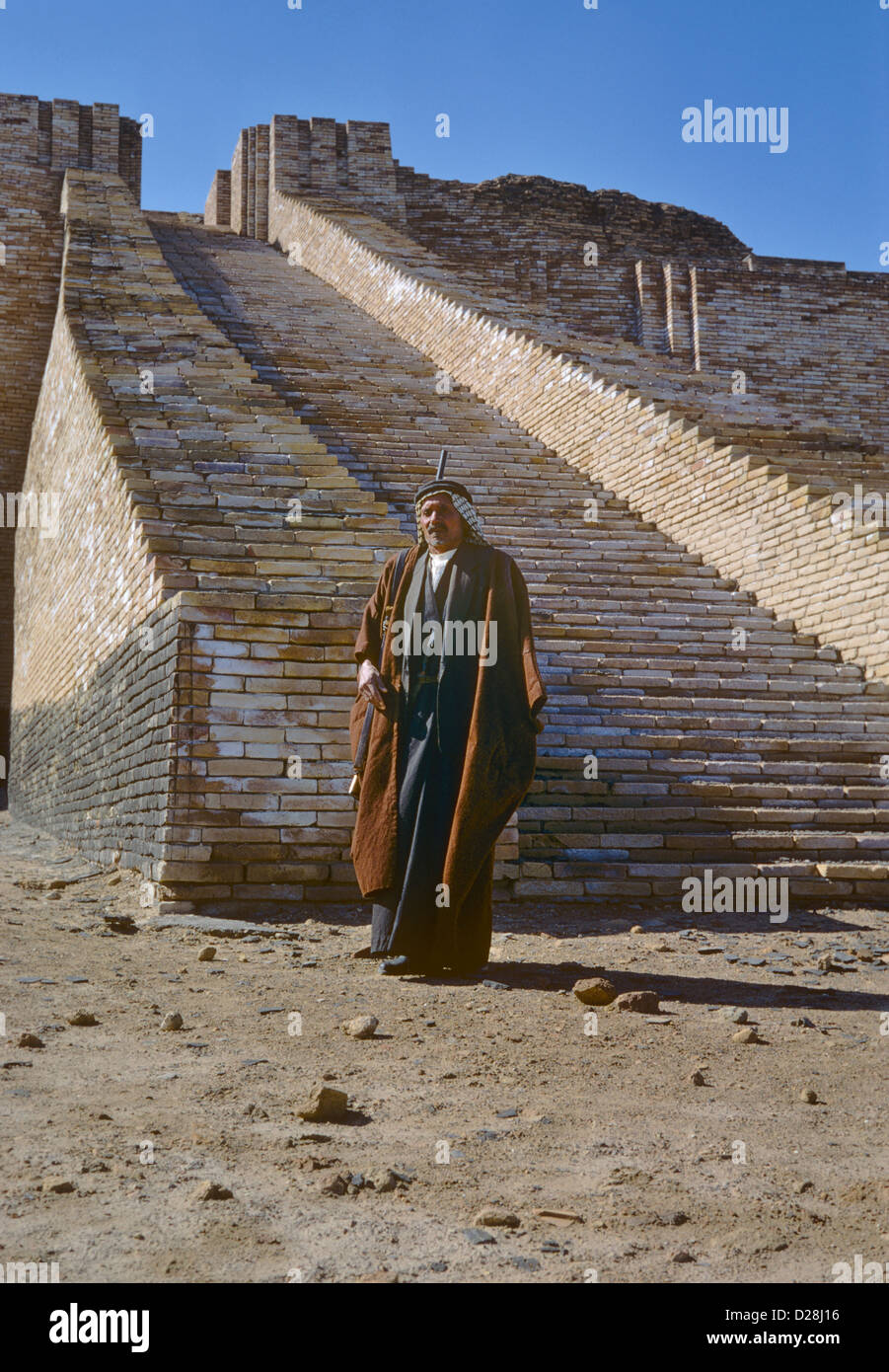 The guardian of the Ziggurat of Ur-Nammu, Iraq 690131 014 Stock Photohttps://www.alamy.com/image-license-details/?v=1https://www.alamy.com/stock-photo-the-guardian-of-the-ziggurat-of-ur-nammu-iraq-690131-014-53050178.html
The guardian of the Ziggurat of Ur-Nammu, Iraq 690131 014 Stock Photohttps://www.alamy.com/image-license-details/?v=1https://www.alamy.com/stock-photo-the-guardian-of-the-ziggurat-of-ur-nammu-iraq-690131-014-53050178.htmlRMD28J16–The guardian of the Ziggurat of Ur-Nammu, Iraq 690131 014
 Steps of the Ziggurat of Ur built by the Neo-Sumerians built in the reign of King Nabonidus 556-539 BC on the rubble of an older Sumerian structure constructed by Sumerian King Ur-Nammu ca. 2100 B.C. It received extensive restoration in the 1980s by the Iraq government of Saddam Hussein. May 19 2010. (BSLOC 2011 12 399) Stock Photohttps://www.alamy.com/image-license-details/?v=1https://www.alamy.com/stock-photo-steps-of-the-ziggurat-of-ur-built-by-the-neo-sumerians-built-in-the-38134947.html
Steps of the Ziggurat of Ur built by the Neo-Sumerians built in the reign of King Nabonidus 556-539 BC on the rubble of an older Sumerian structure constructed by Sumerian King Ur-Nammu ca. 2100 B.C. It received extensive restoration in the 1980s by the Iraq government of Saddam Hussein. May 19 2010. (BSLOC 2011 12 399) Stock Photohttps://www.alamy.com/image-license-details/?v=1https://www.alamy.com/stock-photo-steps-of-the-ziggurat-of-ur-built-by-the-neo-sumerians-built-in-the-38134947.htmlRMC615EB–Steps of the Ziggurat of Ur built by the Neo-Sumerians built in the reign of King Nabonidus 556-539 BC on the rubble of an older Sumerian structure constructed by Sumerian King Ur-Nammu ca. 2100 B.C. It received extensive restoration in the 1980s by the Iraq government of Saddam Hussein. May 19 2010. (BSLOC 2011 12 399)
 The three-stage tower Ziggurat - a belvedere beside the Lake of Waterfall presenting the beautiful view of Terrace of Celestial Worlds and all Quinta Stock Photohttps://www.alamy.com/image-license-details/?v=1https://www.alamy.com/stock-image-the-three-stage-tower-ziggurat-a-belvedere-beside-the-lake-of-waterfall-167212131.html
The three-stage tower Ziggurat - a belvedere beside the Lake of Waterfall presenting the beautiful view of Terrace of Celestial Worlds and all Quinta Stock Photohttps://www.alamy.com/image-license-details/?v=1https://www.alamy.com/stock-image-the-three-stage-tower-ziggurat-a-belvedere-beside-the-lake-of-waterfall-167212131.htmlRFKM14NR–The three-stage tower Ziggurat - a belvedere beside the Lake of Waterfall presenting the beautiful view of Terrace of Celestial Worlds and all Quinta
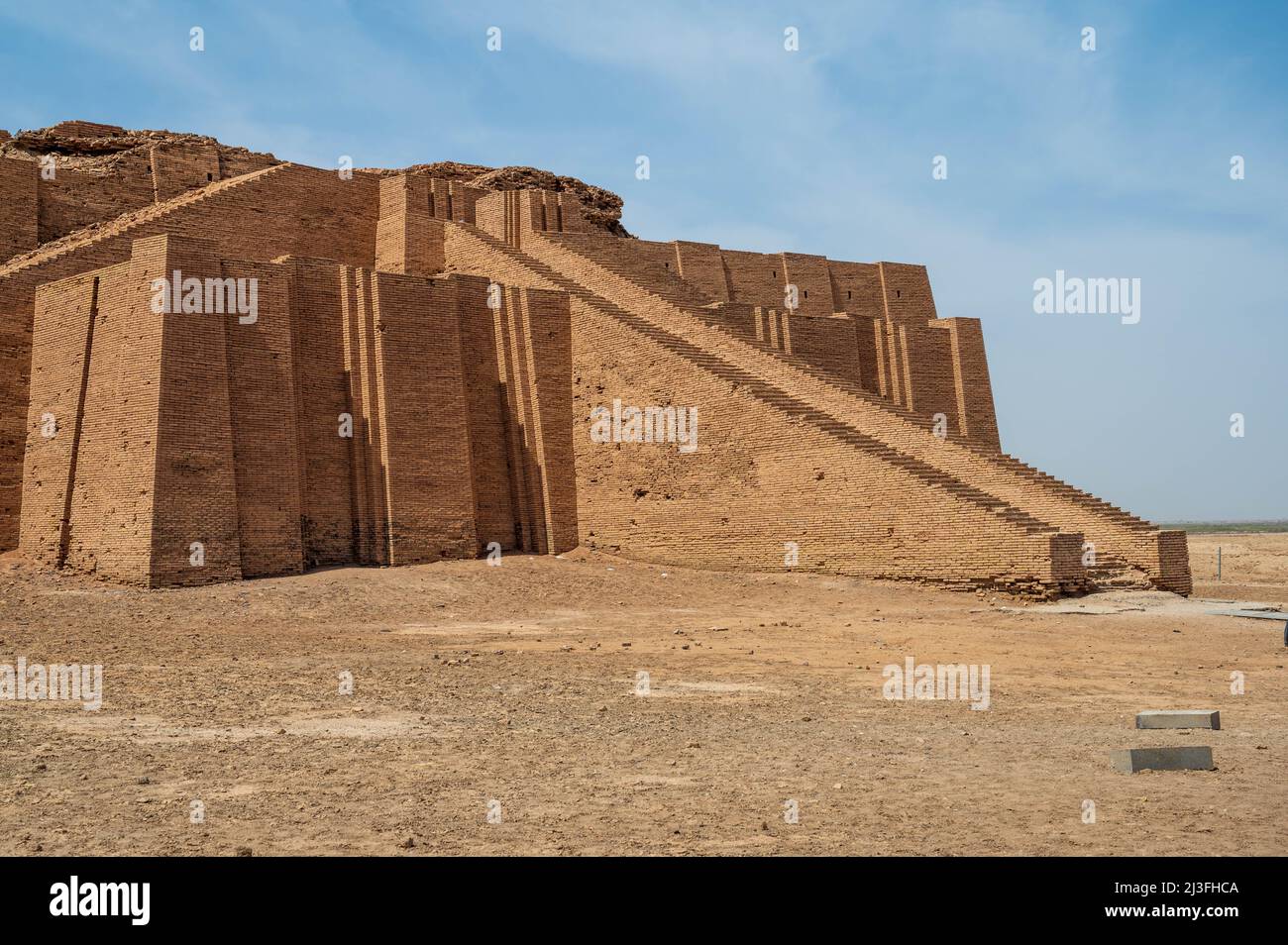 Ziggurat of Ur is a Neo-Sumerian ziggurat on the site of the ancient city of Ur near Nasiriyah, in present-day Dhi Qar Province, Iraq. The structure w Stock Photohttps://www.alamy.com/image-license-details/?v=1https://www.alamy.com/ziggurat-of-ur-is-a-neo-sumerian-ziggurat-on-the-site-of-the-ancient-city-of-ur-near-nasiriyah-in-present-day-dhi-qar-province-iraq-the-structure-w-image466866858.html
Ziggurat of Ur is a Neo-Sumerian ziggurat on the site of the ancient city of Ur near Nasiriyah, in present-day Dhi Qar Province, Iraq. The structure w Stock Photohttps://www.alamy.com/image-license-details/?v=1https://www.alamy.com/ziggurat-of-ur-is-a-neo-sumerian-ziggurat-on-the-site-of-the-ancient-city-of-ur-near-nasiriyah-in-present-day-dhi-qar-province-iraq-the-structure-w-image466866858.htmlRM2J3FHCA–Ziggurat of Ur is a Neo-Sumerian ziggurat on the site of the ancient city of Ur near Nasiriyah, in present-day Dhi Qar Province, Iraq. The structure w
 Chess on ziggurat Stock Photohttps://www.alamy.com/image-license-details/?v=1https://www.alamy.com/stock-photo-chess-on-ziggurat-86980545.html
Chess on ziggurat Stock Photohttps://www.alamy.com/image-license-details/?v=1https://www.alamy.com/stock-photo-chess-on-ziggurat-86980545.htmlRFF1E8G1–Chess on ziggurat
 The Great Ziggurat of Ur was built by the Neo-Sumerians built under King Nabonidus 556-539 BC on the rubble of an older Stock Photohttps://www.alamy.com/image-license-details/?v=1https://www.alamy.com/stock-photo-the-great-ziggurat-of-ur-was-built-by-the-neo-sumerians-built-under-50054425.html
The Great Ziggurat of Ur was built by the Neo-Sumerians built under King Nabonidus 556-539 BC on the rubble of an older Stock Photohttps://www.alamy.com/image-license-details/?v=1https://www.alamy.com/stock-photo-the-great-ziggurat-of-ur-was-built-by-the-neo-sumerians-built-under-50054425.htmlRMCWC4X1–The Great Ziggurat of Ur was built by the Neo-Sumerians built under King Nabonidus 556-539 BC on the rubble of an older
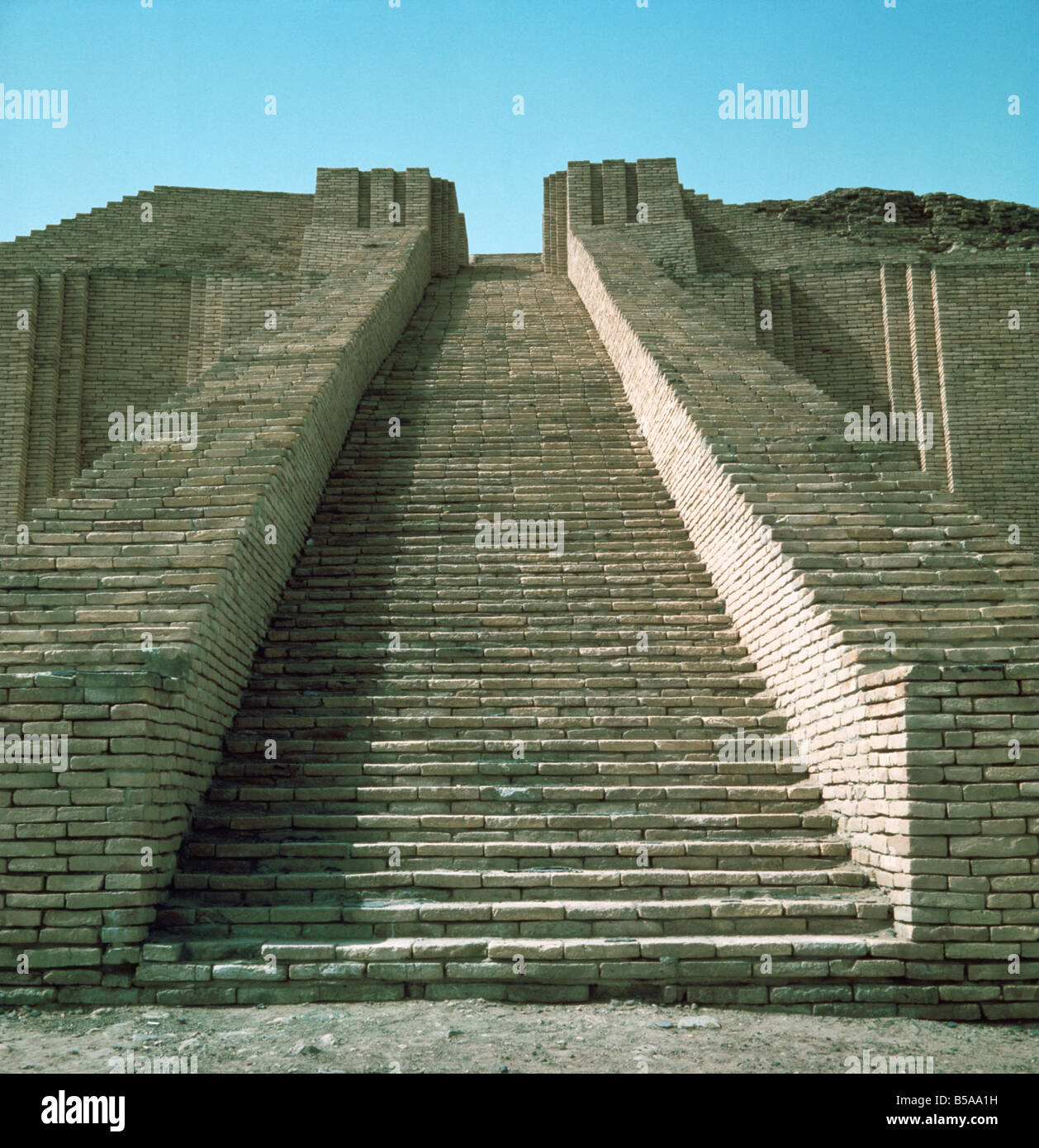 Staircase on ziggurat ruins of Ur Iraq Middle East Stock Photohttps://www.alamy.com/image-license-details/?v=1https://www.alamy.com/stock-photo-staircase-on-ziggurat-ruins-of-ur-iraq-middle-east-20511053.html
Staircase on ziggurat ruins of Ur Iraq Middle East Stock Photohttps://www.alamy.com/image-license-details/?v=1https://www.alamy.com/stock-photo-staircase-on-ziggurat-ruins-of-ur-iraq-middle-east-20511053.htmlRMB5AA1H–Staircase on ziggurat ruins of Ur Iraq Middle East
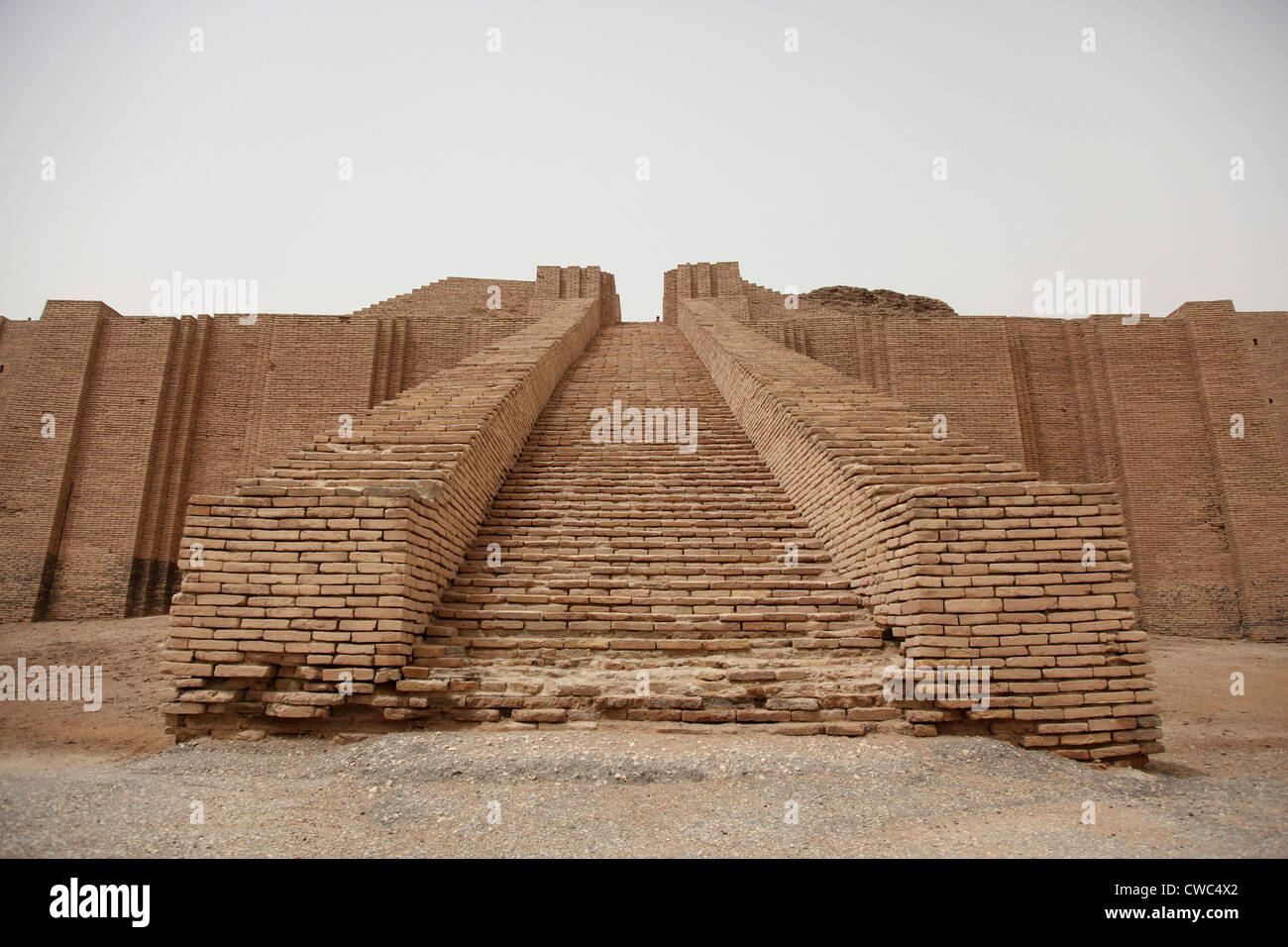 Steps of the Ziggurat of Ur built by the Neo-Sumerians built in the reign of King Nabonidus 556-539 BC on the rubble of an Stock Photohttps://www.alamy.com/image-license-details/?v=1https://www.alamy.com/stock-photo-steps-of-the-ziggurat-of-ur-built-by-the-neo-sumerians-built-in-the-50054426.html
Steps of the Ziggurat of Ur built by the Neo-Sumerians built in the reign of King Nabonidus 556-539 BC on the rubble of an Stock Photohttps://www.alamy.com/image-license-details/?v=1https://www.alamy.com/stock-photo-steps-of-the-ziggurat-of-ur-built-by-the-neo-sumerians-built-in-the-50054426.htmlRMCWC4X2–Steps of the Ziggurat of Ur built by the Neo-Sumerians built in the reign of King Nabonidus 556-539 BC on the rubble of an
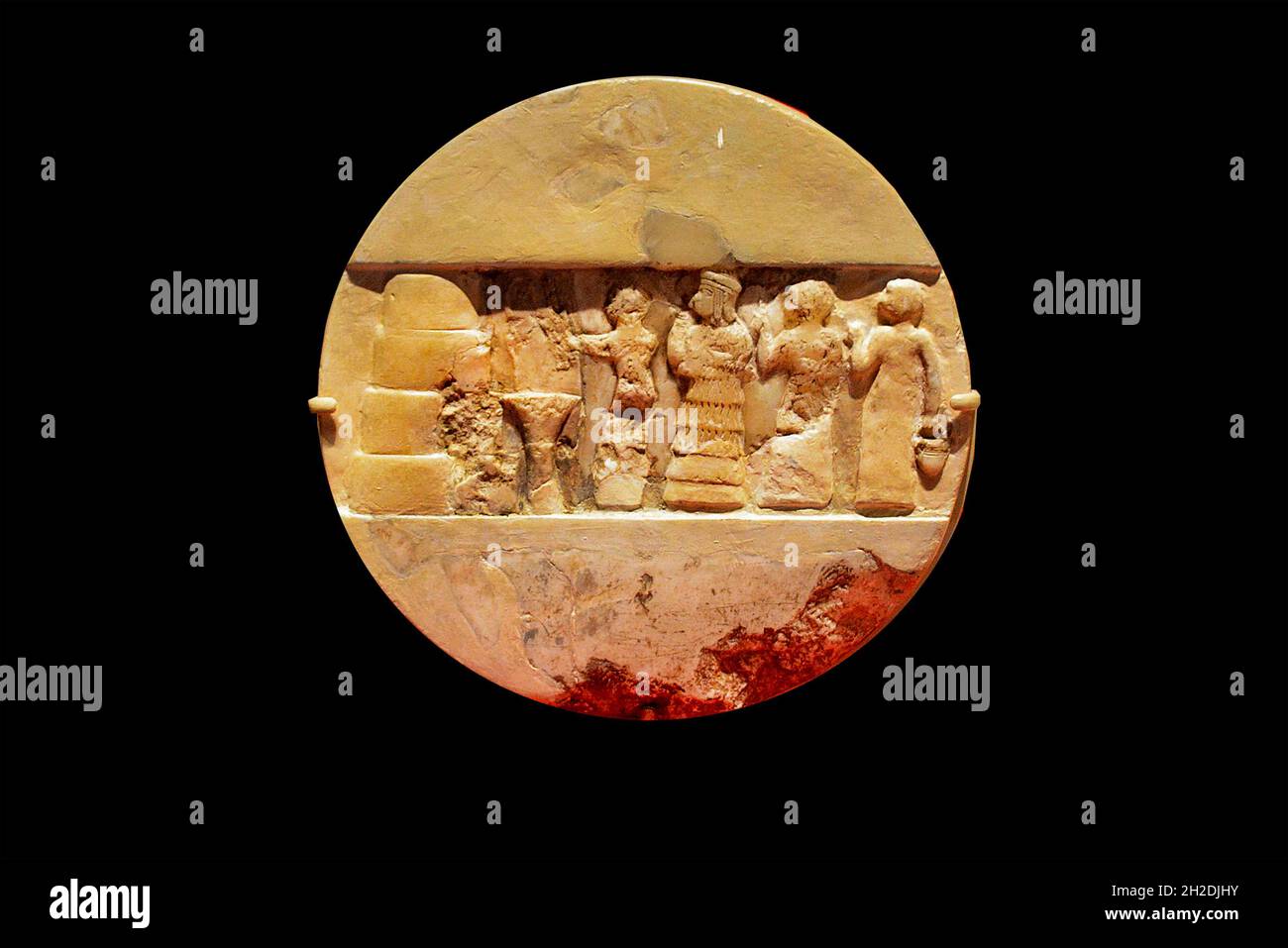 Disc of Enheduanna Stock Photohttps://www.alamy.com/image-license-details/?v=1https://www.alamy.com/disc-of-enheduanna-image448998871.html
Disc of Enheduanna Stock Photohttps://www.alamy.com/image-license-details/?v=1https://www.alamy.com/disc-of-enheduanna-image448998871.htmlRM2H2DJHY–Disc of Enheduanna
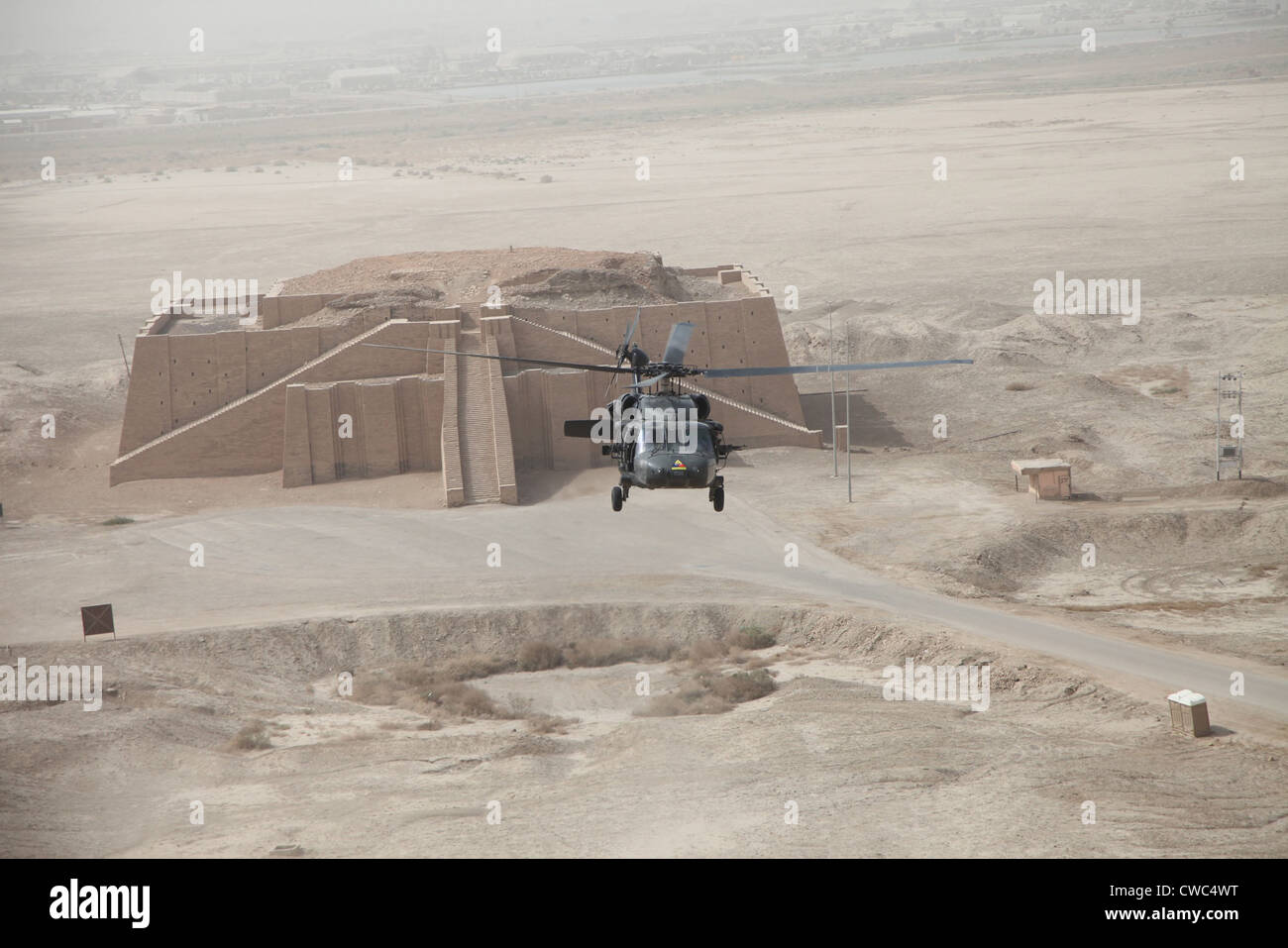 A US Army Black Hawk helicopter hovers above the ancient Ziggurat of Ur near Nasiriyah Iraq Oct. 11 2009. Aerial view shows the Stock Photohttps://www.alamy.com/image-license-details/?v=1https://www.alamy.com/stock-photo-a-us-army-black-hawk-helicopter-hovers-above-the-ancient-ziggurat-50054420.html
A US Army Black Hawk helicopter hovers above the ancient Ziggurat of Ur near Nasiriyah Iraq Oct. 11 2009. Aerial view shows the Stock Photohttps://www.alamy.com/image-license-details/?v=1https://www.alamy.com/stock-photo-a-us-army-black-hawk-helicopter-hovers-above-the-ancient-ziggurat-50054420.htmlRMCWC4WT–A US Army Black Hawk helicopter hovers above the ancient Ziggurat of Ur near Nasiriyah Iraq Oct. 11 2009. Aerial view shows the
![Iraq. Ur. Sand encroaching on excavated ruins. Scene from the top of the ziggurat. The earliest ziggurats began near the end of the Early Dynastic Period.[2] The latest Mesopotamian ziggurats date from the 6th century BC. Stock Photo Iraq. Ur. Sand encroaching on excavated ruins. Scene from the top of the ziggurat. The earliest ziggurats began near the end of the Early Dynastic Period.[2] The latest Mesopotamian ziggurats date from the 6th century BC. Stock Photo](https://c8.alamy.com/comp/EC7XA3/iraq-ur-sand-encroaching-on-excavated-ruins-scene-from-the-top-of-EC7XA3.jpg) Iraq. Ur. Sand encroaching on excavated ruins. Scene from the top of the ziggurat. The earliest ziggurats began near the end of the Early Dynastic Period.[2] The latest Mesopotamian ziggurats date from the 6th century BC. Stock Photohttps://www.alamy.com/image-license-details/?v=1https://www.alamy.com/stock-photo-iraq-ur-sand-encroaching-on-excavated-ruins-scene-from-the-top-of-76391675.html
Iraq. Ur. Sand encroaching on excavated ruins. Scene from the top of the ziggurat. The earliest ziggurats began near the end of the Early Dynastic Period.[2] The latest Mesopotamian ziggurats date from the 6th century BC. Stock Photohttps://www.alamy.com/image-license-details/?v=1https://www.alamy.com/stock-photo-iraq-ur-sand-encroaching-on-excavated-ruins-scene-from-the-top-of-76391675.htmlRMEC7XA3–Iraq. Ur. Sand encroaching on excavated ruins. Scene from the top of the ziggurat. The earliest ziggurats began near the end of the Early Dynastic Period.[2] The latest Mesopotamian ziggurats date from the 6th century BC.
 Restored ziggurat in ancient Ur, sumerian temple in Iraq Stock Photohttps://www.alamy.com/image-license-details/?v=1https://www.alamy.com/restored-ziggurat-in-ancient-ur-sumerian-temple-in-iraq-image183617300.html
Restored ziggurat in ancient Ur, sumerian temple in Iraq Stock Photohttps://www.alamy.com/image-license-details/?v=1https://www.alamy.com/restored-ziggurat-in-ancient-ur-sumerian-temple-in-iraq-image183617300.htmlRFMJMDMM–Restored ziggurat in ancient Ur, sumerian temple in Iraq
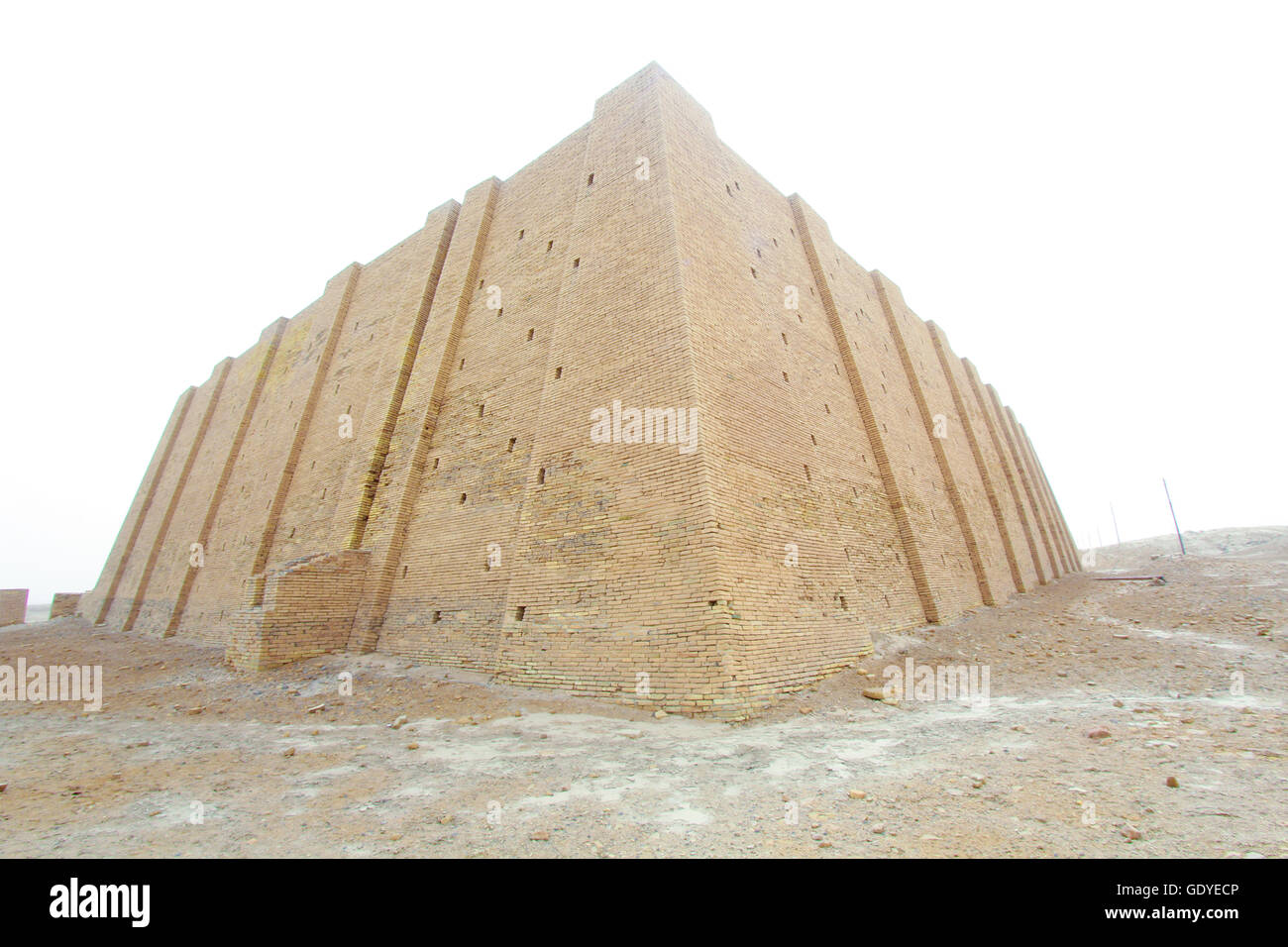 Picture of Ziggurat of Ur and one of the most important monuments in Iraq and that goes back to the Sumerian period which are located in the province of Dhi Qar in southern Iraq. Stock Photohttps://www.alamy.com/image-license-details/?v=1https://www.alamy.com/stock-photo-picture-of-ziggurat-of-ur-and-one-of-the-most-important-monuments-111856774.html
Picture of Ziggurat of Ur and one of the most important monuments in Iraq and that goes back to the Sumerian period which are located in the province of Dhi Qar in southern Iraq. Stock Photohttps://www.alamy.com/image-license-details/?v=1https://www.alamy.com/stock-photo-picture-of-ziggurat-of-ur-and-one-of-the-most-important-monuments-111856774.htmlRMGDYECP–Picture of Ziggurat of Ur and one of the most important monuments in Iraq and that goes back to the Sumerian period which are located in the province of Dhi Qar in southern Iraq.
 Great Ziggurat of Ur, Iraq, 1977. Stock Photohttps://www.alamy.com/image-license-details/?v=1https://www.alamy.com/stock-photo-great-ziggurat-of-ur-iraq-1977-28929585.html
Great Ziggurat of Ur, Iraq, 1977. Stock Photohttps://www.alamy.com/image-license-details/?v=1https://www.alamy.com/stock-photo-great-ziggurat-of-ur-iraq-1977-28929585.htmlRMBK1RYD–Great Ziggurat of Ur, Iraq, 1977.
 Remains of Ziggurat of Birs Nimrud, Borsippa, Babil Province, Iraq. Middle East. Drawing by Slom (1844 - 1909) Persia, Chaldea and Susiana 1881-1882 by Jane Dieulafoy (1851 - 1916) Le Tour du Monde 1886 Stock Photohttps://www.alamy.com/image-license-details/?v=1https://www.alamy.com/remains-of-ziggurat-of-birs-nimrud-borsippa-babil-province-iraq-middle-east-drawing-by-slom-1844-1909-persia-chaldea-and-susiana-1881-1882-by-jane-dieulafoy-1851-1916-le-tour-du-monde-1886-image603608675.html
Remains of Ziggurat of Birs Nimrud, Borsippa, Babil Province, Iraq. Middle East. Drawing by Slom (1844 - 1909) Persia, Chaldea and Susiana 1881-1882 by Jane Dieulafoy (1851 - 1916) Le Tour du Monde 1886 Stock Photohttps://www.alamy.com/image-license-details/?v=1https://www.alamy.com/remains-of-ziggurat-of-birs-nimrud-borsippa-babil-province-iraq-middle-east-drawing-by-slom-1844-1909-persia-chaldea-and-susiana-1881-1882-by-jane-dieulafoy-1851-1916-le-tour-du-monde-1886-image603608675.htmlRM2X20N0K–Remains of Ziggurat of Birs Nimrud, Borsippa, Babil Province, Iraq. Middle East. Drawing by Slom (1844 - 1909) Persia, Chaldea and Susiana 1881-1882 by Jane Dieulafoy (1851 - 1916) Le Tour du Monde 1886
 Golden helmet from the royal burial. The First Dynasty of Ur. The first half of the 3-rd millennium BC. Stock Photohttps://www.alamy.com/image-license-details/?v=1https://www.alamy.com/golden-helmet-from-the-royal-burial-the-first-dynasty-of-ur-the-first-half-of-the-3-rd-millennium-bc-image603695252.html
Golden helmet from the royal burial. The First Dynasty of Ur. The first half of the 3-rd millennium BC. Stock Photohttps://www.alamy.com/image-license-details/?v=1https://www.alamy.com/golden-helmet-from-the-royal-burial-the-first-dynasty-of-ur-the-first-half-of-the-3-rd-millennium-bc-image603695252.htmlRM2X24KCM–Golden helmet from the royal burial. The First Dynasty of Ur. The first half of the 3-rd millennium BC.
 (dpa files) - Tourists are standing on the steps of the Ziggurat of Ur, the former capital of Babylonia (undated). The site of Ur is known today as Tall al Muqayyar, in the south of Iraq. Ur means city in the Sumerian and Akkadian languages, and many cities were called by this name. Ur is mentioned Stock Photohttps://www.alamy.com/image-license-details/?v=1https://www.alamy.com/stock-photo-dpa-files-tourists-are-standing-on-the-steps-of-the-ziggurat-of-ur-53733592.html
(dpa files) - Tourists are standing on the steps of the Ziggurat of Ur, the former capital of Babylonia (undated). The site of Ur is known today as Tall al Muqayyar, in the south of Iraq. Ur means city in the Sumerian and Akkadian languages, and many cities were called by this name. Ur is mentioned Stock Photohttps://www.alamy.com/image-license-details/?v=1https://www.alamy.com/stock-photo-dpa-files-tourists-are-standing-on-the-steps-of-the-ziggurat-of-ur-53733592.htmlRMD3BNMT–(dpa files) - Tourists are standing on the steps of the Ziggurat of Ur, the former capital of Babylonia (undated). The site of Ur is known today as Tall al Muqayyar, in the south of Iraq. Ur means city in the Sumerian and Akkadian languages, and many cities were called by this name. Ur is mentioned
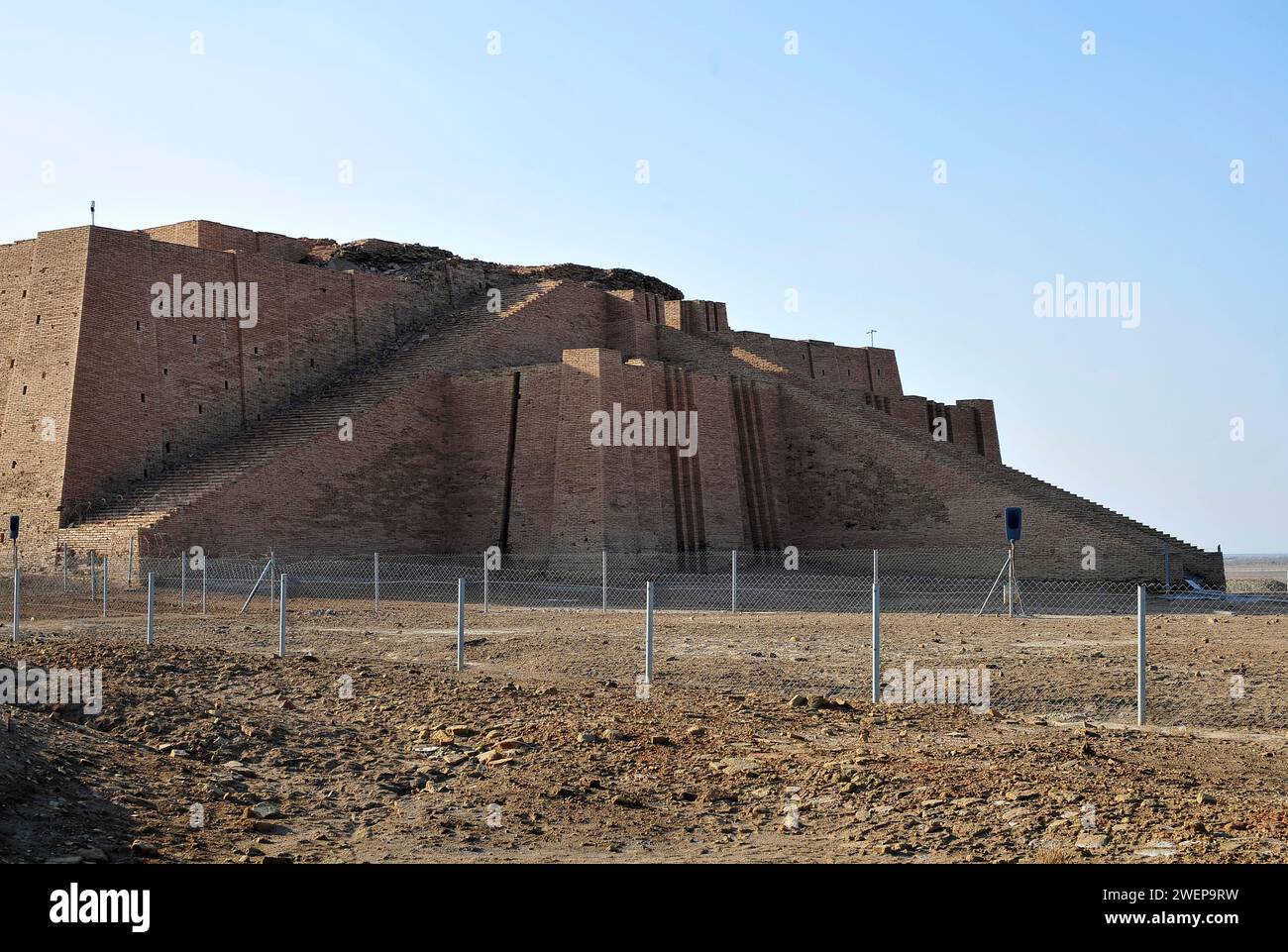 IRAQ-ARCHAEOLOGY-TOURISM. Ziggurat of Ur Stock Photohttps://www.alamy.com/image-license-details/?v=1https://www.alamy.com/iraq-archaeology-tourism-ziggurat-of-ur-image594248365.html
IRAQ-ARCHAEOLOGY-TOURISM. Ziggurat of Ur Stock Photohttps://www.alamy.com/image-license-details/?v=1https://www.alamy.com/iraq-archaeology-tourism-ziggurat-of-ur-image594248365.htmlRM2WEP9RW–IRAQ-ARCHAEOLOGY-TOURISM. Ziggurat of Ur
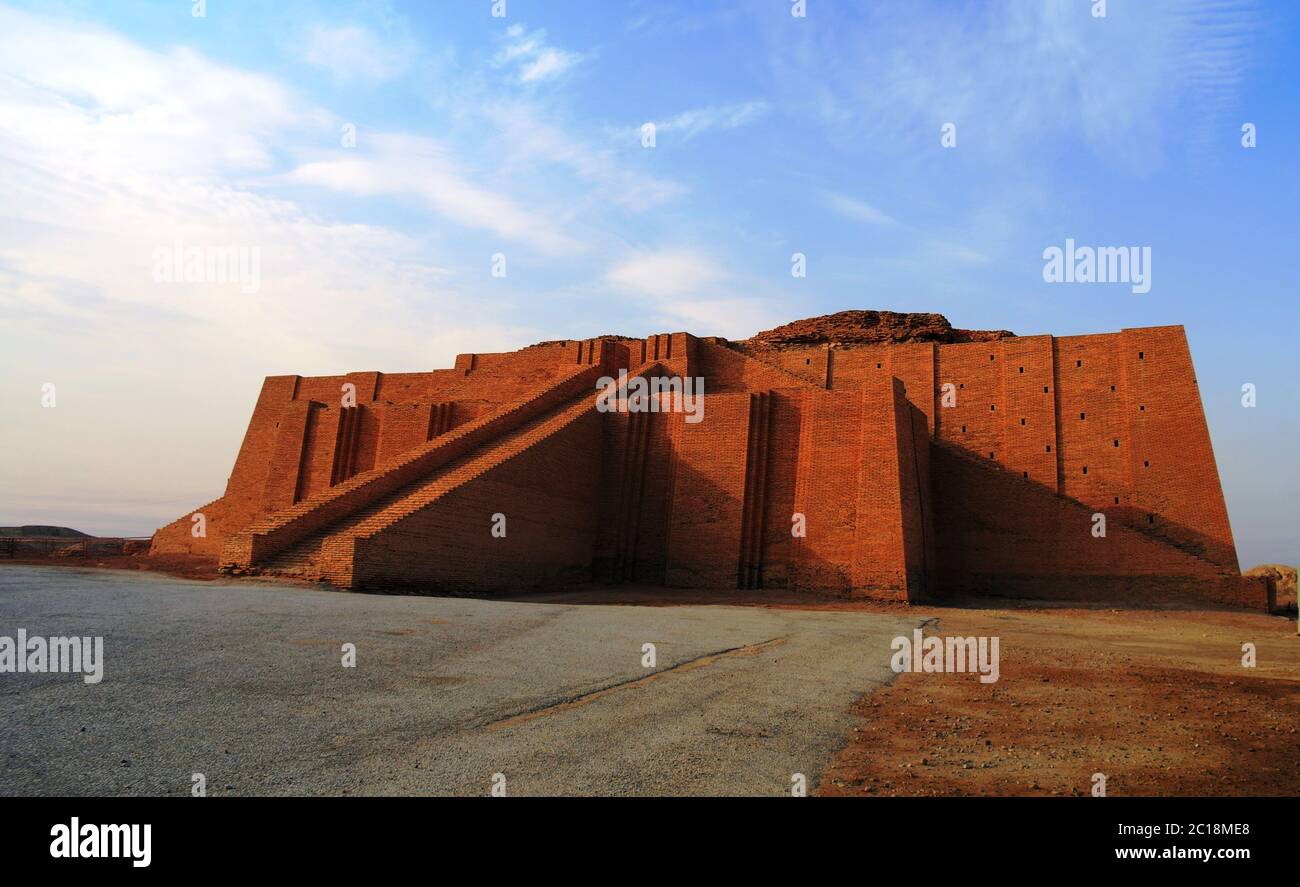 Restored ziggurat in ancient Ur Stock Photohttps://www.alamy.com/image-license-details/?v=1https://www.alamy.com/restored-ziggurat-in-ancient-ur-image362224080.html
Restored ziggurat in ancient Ur Stock Photohttps://www.alamy.com/image-license-details/?v=1https://www.alamy.com/restored-ziggurat-in-ancient-ur-image362224080.htmlRM2C18ME8–Restored ziggurat in ancient Ur
 The brickwork of the restored walls of the Ziggurat of Ur-Nammu, Iraq 690131 010 Stock Photohttps://www.alamy.com/image-license-details/?v=1https://www.alamy.com/stock-photo-the-brickwork-of-the-restored-walls-of-the-ziggurat-of-ur-nammu-iraq-27936957.html
The brickwork of the restored walls of the Ziggurat of Ur-Nammu, Iraq 690131 010 Stock Photohttps://www.alamy.com/image-license-details/?v=1https://www.alamy.com/stock-photo-the-brickwork-of-the-restored-walls-of-the-ziggurat-of-ur-nammu-iraq-27936957.htmlRMBHCHTD–The brickwork of the restored walls of the Ziggurat of Ur-Nammu, Iraq 690131 010
 Reconstructed facade of the ziggurat of Ur, Iraq Stock Photohttps://www.alamy.com/image-license-details/?v=1https://www.alamy.com/reconstructed-facade-of-the-ziggurat-of-ur-iraq-image362270148.html
Reconstructed facade of the ziggurat of Ur, Iraq Stock Photohttps://www.alamy.com/image-license-details/?v=1https://www.alamy.com/reconstructed-facade-of-the-ziggurat-of-ur-iraq-image362270148.htmlRM2C1AR7G–Reconstructed facade of the ziggurat of Ur, Iraq
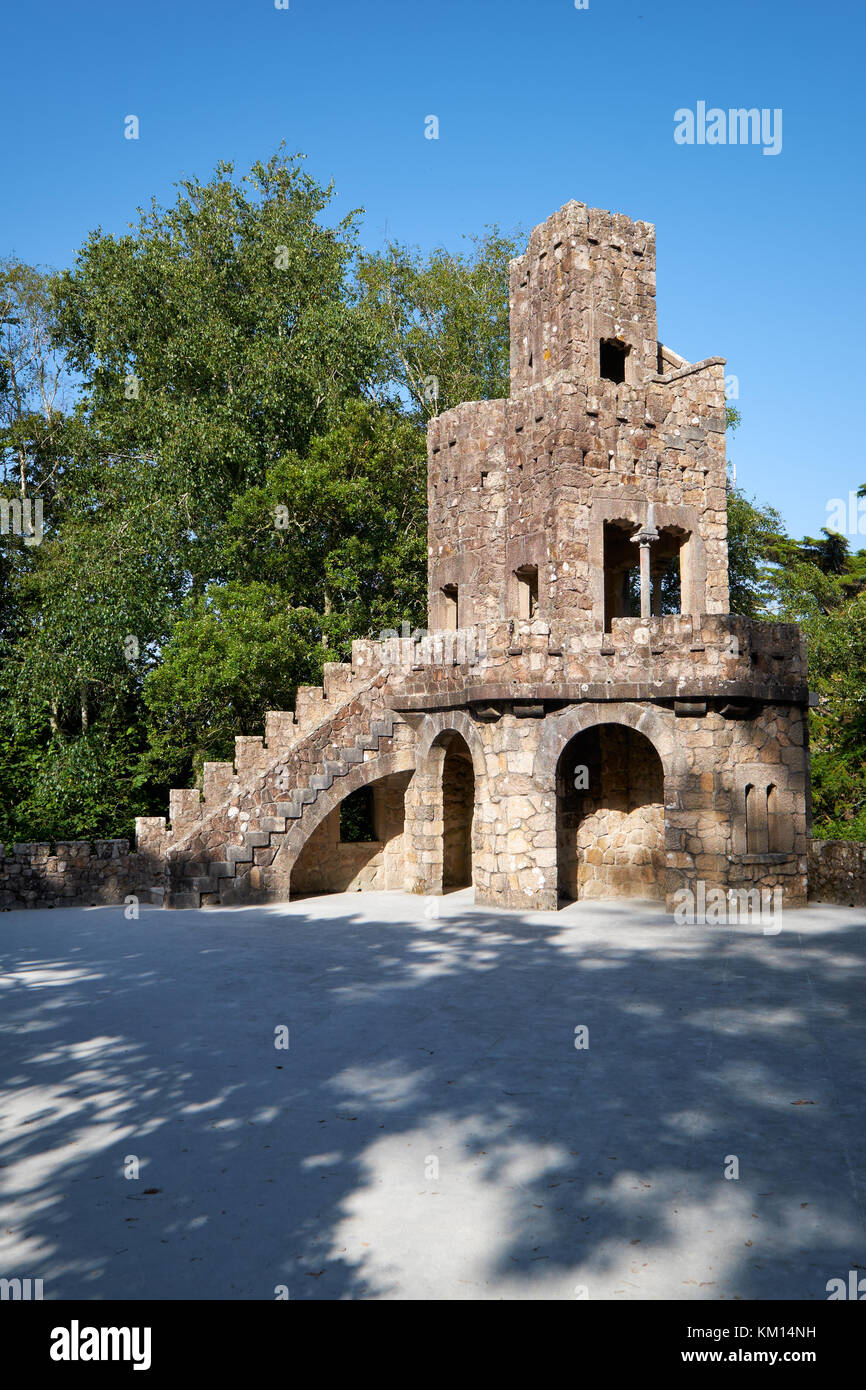 The three-stage tower Ziggurat - a belvedere beside the Lake of Waterfall presenting the beautiful view of Terrace of Celestial Worlds and all Quinta Stock Photohttps://www.alamy.com/image-license-details/?v=1https://www.alamy.com/stock-image-the-three-stage-tower-ziggurat-a-belvedere-beside-the-lake-of-waterfall-167212125.html
The three-stage tower Ziggurat - a belvedere beside the Lake of Waterfall presenting the beautiful view of Terrace of Celestial Worlds and all Quinta Stock Photohttps://www.alamy.com/image-license-details/?v=1https://www.alamy.com/stock-image-the-three-stage-tower-ziggurat-a-belvedere-beside-the-lake-of-waterfall-167212125.htmlRFKM14NH–The three-stage tower Ziggurat - a belvedere beside the Lake of Waterfall presenting the beautiful view of Terrace of Celestial Worlds and all Quinta
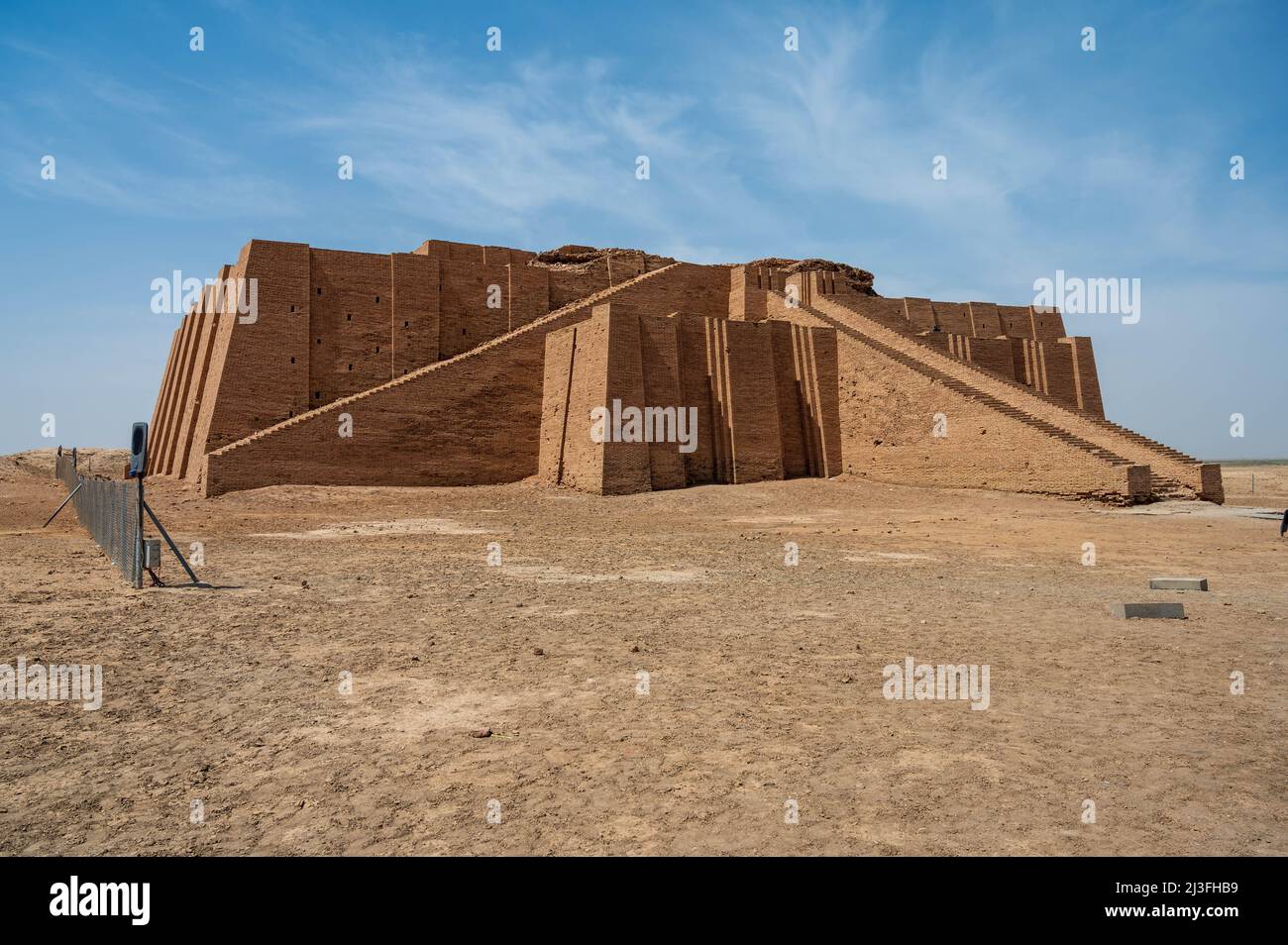 Ziggurat of Ur is a Neo-Sumerian ziggurat on the site of the ancient city of Ur near Nasiriyah, in present-day Dhi Qar Province, Iraq. The structure w Stock Photohttps://www.alamy.com/image-license-details/?v=1https://www.alamy.com/ziggurat-of-ur-is-a-neo-sumerian-ziggurat-on-the-site-of-the-ancient-city-of-ur-near-nasiriyah-in-present-day-dhi-qar-province-iraq-the-structure-w-image466866829.html
Ziggurat of Ur is a Neo-Sumerian ziggurat on the site of the ancient city of Ur near Nasiriyah, in present-day Dhi Qar Province, Iraq. The structure w Stock Photohttps://www.alamy.com/image-license-details/?v=1https://www.alamy.com/ziggurat-of-ur-is-a-neo-sumerian-ziggurat-on-the-site-of-the-ancient-city-of-ur-near-nasiriyah-in-present-day-dhi-qar-province-iraq-the-structure-w-image466866829.htmlRM2J3FHB9–Ziggurat of Ur is a Neo-Sumerian ziggurat on the site of the ancient city of Ur near Nasiriyah, in present-day Dhi Qar Province, Iraq. The structure w
 Babylonian temple of Etemenanki Stock Photohttps://www.alamy.com/image-license-details/?v=1https://www.alamy.com/babylonian-temple-of-etemenanki-image501314229.html
Babylonian temple of Etemenanki Stock Photohttps://www.alamy.com/image-license-details/?v=1https://www.alamy.com/babylonian-temple-of-etemenanki-image501314229.htmlRF2M3GRBH–Babylonian temple of Etemenanki
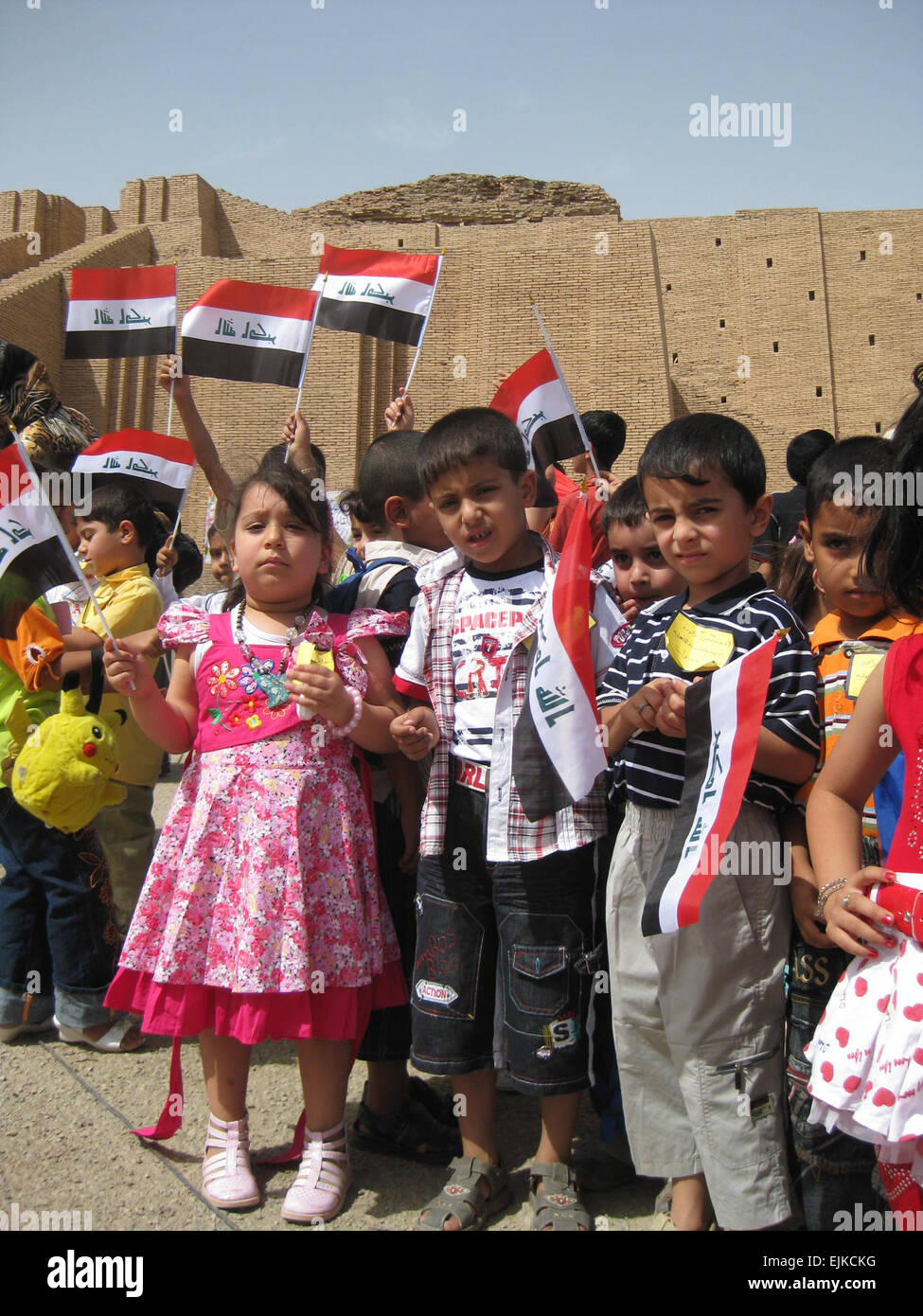 Kindergarten students from Mumsuna school in Nasiriyah, Iraq, attend a ceremony marking the transfer of the Ziggurat of Ur from U.S. to Iraqi control. The Ziggurat had been closed to the public since 2003. The Ziggurat was constructed in 2100 B.C. by Sumerian King Ur-Nammu. The ceremony was attended by Iraqi government leaders and military representatives from Multi-National Division - South. Maj. Myles Caggins Stock Photohttps://www.alamy.com/image-license-details/?v=1https://www.alamy.com/stock-photo-kindergarten-students-from-mumsuna-school-in-nasiriyah-iraq-attend-80332324.html
Kindergarten students from Mumsuna school in Nasiriyah, Iraq, attend a ceremony marking the transfer of the Ziggurat of Ur from U.S. to Iraqi control. The Ziggurat had been closed to the public since 2003. The Ziggurat was constructed in 2100 B.C. by Sumerian King Ur-Nammu. The ceremony was attended by Iraqi government leaders and military representatives from Multi-National Division - South. Maj. Myles Caggins Stock Photohttps://www.alamy.com/image-license-details/?v=1https://www.alamy.com/stock-photo-kindergarten-students-from-mumsuna-school-in-nasiriyah-iraq-attend-80332324.htmlRMEJKCKG–Kindergarten students from Mumsuna school in Nasiriyah, Iraq, attend a ceremony marking the transfer of the Ziggurat of Ur from U.S. to Iraqi control. The Ziggurat had been closed to the public since 2003. The Ziggurat was constructed in 2100 B.C. by Sumerian King Ur-Nammu. The ceremony was attended by Iraqi government leaders and military representatives from Multi-National Division - South. Maj. Myles Caggins
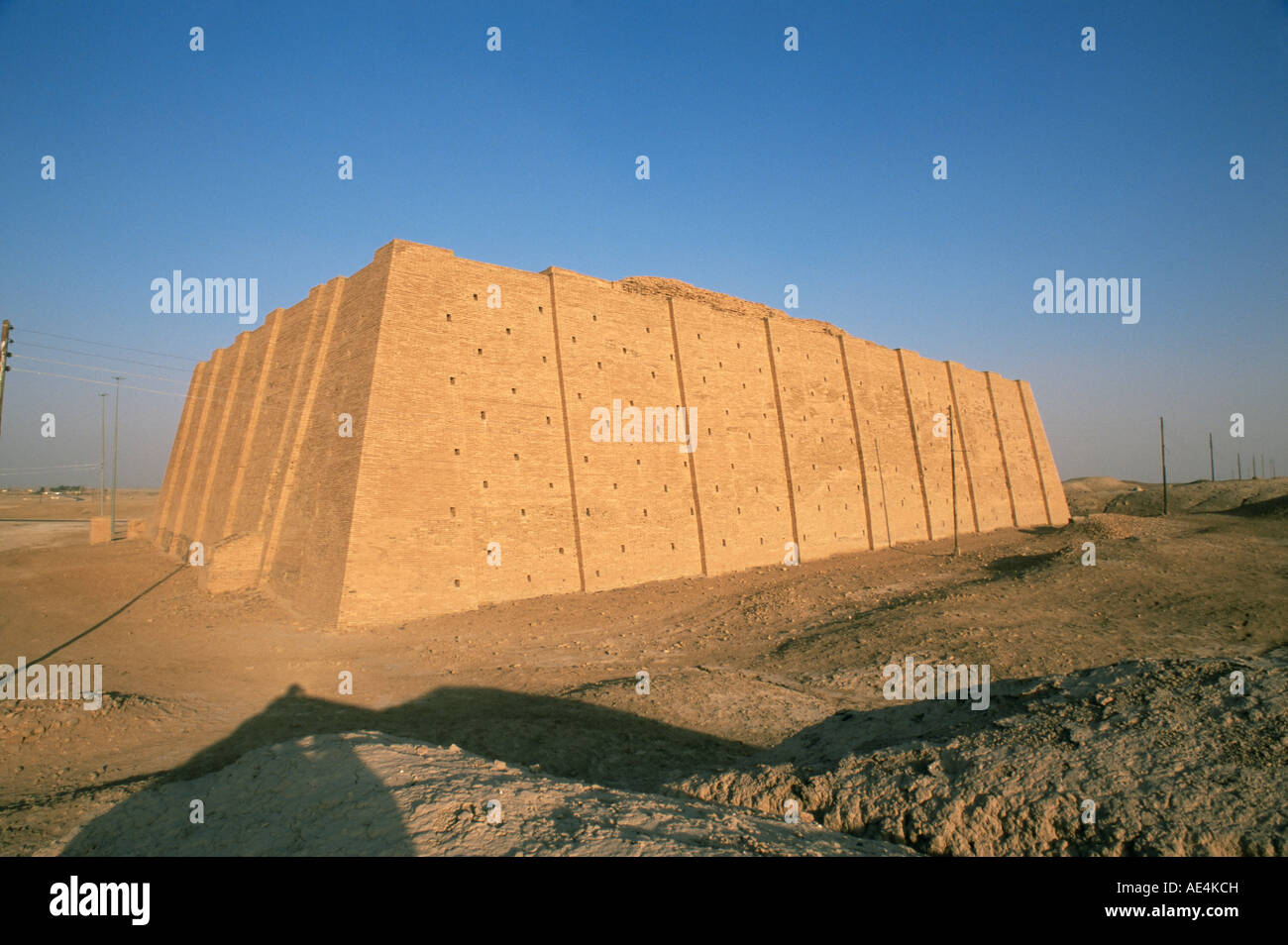 Ziggurat, Ur, Iraq, Middle East Stock Photohttps://www.alamy.com/image-license-details/?v=1https://www.alamy.com/stock-photo-ziggurat-ur-iraq-middle-east-13566592.html
Ziggurat, Ur, Iraq, Middle East Stock Photohttps://www.alamy.com/image-license-details/?v=1https://www.alamy.com/stock-photo-ziggurat-ur-iraq-middle-east-13566592.htmlRMAE4KCH–Ziggurat, Ur, Iraq, Middle East
 Cuneiform tablet: Sumerian dedicatory(?) inscription from Ekur, the temple of the god Enlil ca. 16th–15th century B.C. Kassite The city of Nippur, home to the chief god Enlil, was an important religious center in Mesopotamia. Rulers seeking the favor of Enlil visited the city to make offerings to the god, and contributed to the refurbishment of his temple and ziggurat, known as the Ekur (which means “mountain temple”). Bricks stamped with the inscriptions of different kings, buried during construction projects, give dates to the archaeologically -observable re-buildings of the temple from the Stock Photohttps://www.alamy.com/image-license-details/?v=1https://www.alamy.com/cuneiform-tablet-sumerian-dedicatory-inscription-from-ekur-the-temple-of-the-god-enlil-ca-16th15th-century-bc-kassite-the-city-of-nippur-home-to-the-chief-god-enlil-was-an-important-religious-center-in-mesopotamia-rulers-seeking-the-favor-of-enlil-visited-the-city-to-make-offerings-to-the-god-and-contributed-to-the-refurbishment-of-his-temple-and-ziggurat-known-as-the-ekur-which-means-mountain-temple-bricks-stamped-with-the-inscriptions-of-different-kings-buried-during-construction-projects-give-dates-to-the-archaeologically-observable-re-buildings-of-the-temple-from-the-image457804907.html
Cuneiform tablet: Sumerian dedicatory(?) inscription from Ekur, the temple of the god Enlil ca. 16th–15th century B.C. Kassite The city of Nippur, home to the chief god Enlil, was an important religious center in Mesopotamia. Rulers seeking the favor of Enlil visited the city to make offerings to the god, and contributed to the refurbishment of his temple and ziggurat, known as the Ekur (which means “mountain temple”). Bricks stamped with the inscriptions of different kings, buried during construction projects, give dates to the archaeologically -observable re-buildings of the temple from the Stock Photohttps://www.alamy.com/image-license-details/?v=1https://www.alamy.com/cuneiform-tablet-sumerian-dedicatory-inscription-from-ekur-the-temple-of-the-god-enlil-ca-16th15th-century-bc-kassite-the-city-of-nippur-home-to-the-chief-god-enlil-was-an-important-religious-center-in-mesopotamia-rulers-seeking-the-favor-of-enlil-visited-the-city-to-make-offerings-to-the-god-and-contributed-to-the-refurbishment-of-his-temple-and-ziggurat-known-as-the-ekur-which-means-mountain-temple-bricks-stamped-with-the-inscriptions-of-different-kings-buried-during-construction-projects-give-dates-to-the-archaeologically-observable-re-buildings-of-the-temple-from-the-image457804907.htmlRM2HGPPR7–Cuneiform tablet: Sumerian dedicatory(?) inscription from Ekur, the temple of the god Enlil ca. 16th–15th century B.C. Kassite The city of Nippur, home to the chief god Enlil, was an important religious center in Mesopotamia. Rulers seeking the favor of Enlil visited the city to make offerings to the god, and contributed to the refurbishment of his temple and ziggurat, known as the Ekur (which means “mountain temple”). Bricks stamped with the inscriptions of different kings, buried during construction projects, give dates to the archaeologically -observable re-buildings of the temple from the
 Mar 01, 2008 - Tallil, Iraq - Curator DIEF MOHSSEIN NAIIF AL-GIZZY stands under the oldest standing archway at the Sumerian ruins next to the Ziggurat of Ur. Al-Gizzy is the third generation in his family to care for the Ziggurat and the surrounding ruins. On the outskirts of Camp Adder, a logist Stock Photohttps://www.alamy.com/image-license-details/?v=1https://www.alamy.com/stock-photo-mar-01-2008-tallil-iraq-curator-dief-mohssein-naiif-al-gizzy-stands-42528946.html
Mar 01, 2008 - Tallil, Iraq - Curator DIEF MOHSSEIN NAIIF AL-GIZZY stands under the oldest standing archway at the Sumerian ruins next to the Ziggurat of Ur. Al-Gizzy is the third generation in his family to care for the Ziggurat and the surrounding ruins. On the outskirts of Camp Adder, a logist Stock Photohttps://www.alamy.com/image-license-details/?v=1https://www.alamy.com/stock-photo-mar-01-2008-tallil-iraq-curator-dief-mohssein-naiif-al-gizzy-stands-42528946.htmlRMCD5A2X–Mar 01, 2008 - Tallil, Iraq - Curator DIEF MOHSSEIN NAIIF AL-GIZZY stands under the oldest standing archway at the Sumerian ruins next to the Ziggurat of Ur. Al-Gizzy is the third generation in his family to care for the Ziggurat and the surrounding ruins. On the outskirts of Camp Adder, a logist
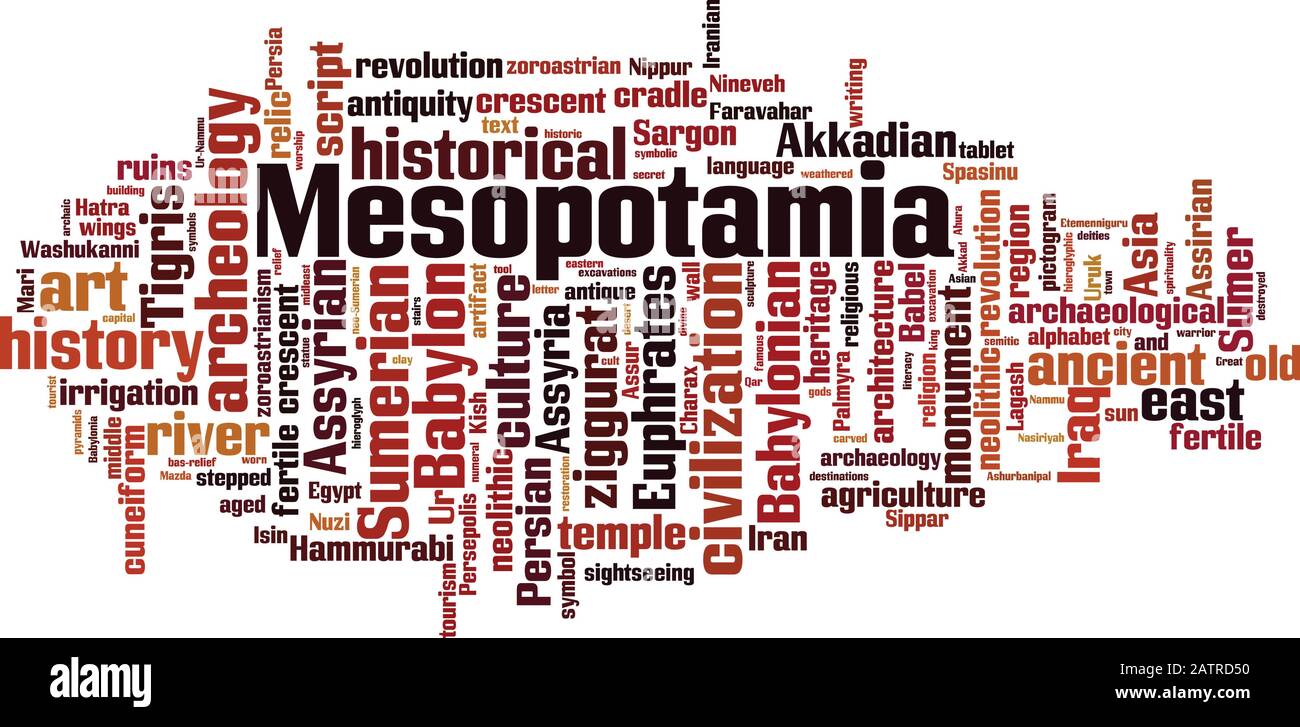 Mesopotamia word cloud concept. Collage made of words about Mesopotamia. Vector illustration Stock Vectorhttps://www.alamy.com/image-license-details/?v=1https://www.alamy.com/mesopotamia-word-cloud-concept-collage-made-of-words-about-mesopotamia-vector-illustration-image342263964.html
Mesopotamia word cloud concept. Collage made of words about Mesopotamia. Vector illustration Stock Vectorhttps://www.alamy.com/image-license-details/?v=1https://www.alamy.com/mesopotamia-word-cloud-concept-collage-made-of-words-about-mesopotamia-vector-illustration-image342263964.htmlRF2ATRD50–Mesopotamia word cloud concept. Collage made of words about Mesopotamia. Vector illustration
 An Iraqi soldier walks to the top of the buried ziggurat at Eridu reportedly the worlds oldest city Stock Photohttps://www.alamy.com/image-license-details/?v=1https://www.alamy.com/an-iraqi-soldier-walks-to-the-top-of-the-buried-ziggurat-at-eridu-image3576073.html
An Iraqi soldier walks to the top of the buried ziggurat at Eridu reportedly the worlds oldest city Stock Photohttps://www.alamy.com/image-license-details/?v=1https://www.alamy.com/an-iraqi-soldier-walks-to-the-top-of-the-buried-ziggurat-at-eridu-image3576073.htmlRMA46W0A–An Iraqi soldier walks to the top of the buried ziggurat at Eridu reportedly the worlds oldest city
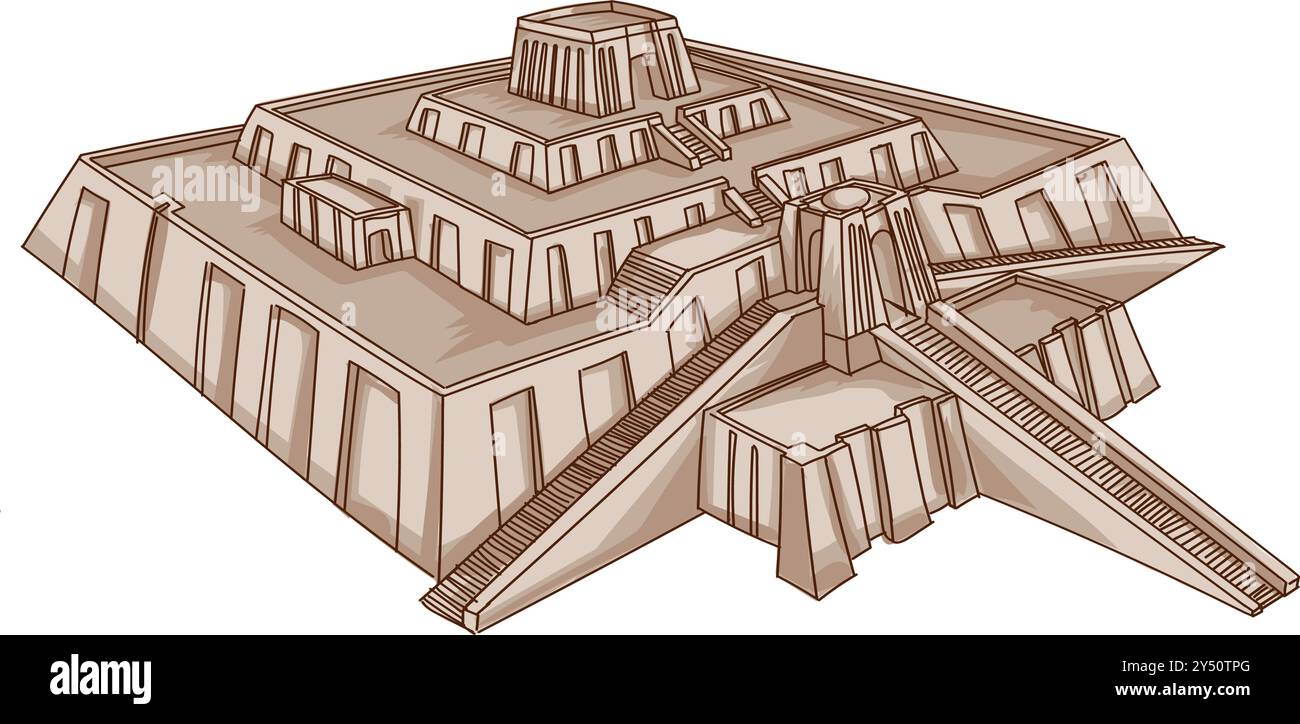 The great Ziggurat at Ur in perspective, Architecture of Babylon, Assyria, Mesopotamia. vector illustration Stock Vectorhttps://www.alamy.com/image-license-details/?v=1https://www.alamy.com/the-great-ziggurat-at-ur-in-perspective-architecture-of-babylon-assyria-mesopotamia-vector-illustration-image622665976.html
The great Ziggurat at Ur in perspective, Architecture of Babylon, Assyria, Mesopotamia. vector illustration Stock Vectorhttps://www.alamy.com/image-license-details/?v=1https://www.alamy.com/the-great-ziggurat-at-ur-in-perspective-architecture-of-babylon-assyria-mesopotamia-vector-illustration-image622665976.htmlRF2Y50TPG–The great Ziggurat at Ur in perspective, Architecture of Babylon, Assyria, Mesopotamia. vector illustration
 A US Army Black Hawk helicopter hovers above the ancient Ziggurat of Ur near Nasiriyah Iraq Oct. 11 2009. Aerial view shows the Stock Photohttps://www.alamy.com/image-license-details/?v=1https://www.alamy.com/stock-photo-a-us-army-black-hawk-helicopter-hovers-above-the-ancient-ziggurat-38134943.html
A US Army Black Hawk helicopter hovers above the ancient Ziggurat of Ur near Nasiriyah Iraq Oct. 11 2009. Aerial view shows the Stock Photohttps://www.alamy.com/image-license-details/?v=1https://www.alamy.com/stock-photo-a-us-army-black-hawk-helicopter-hovers-above-the-ancient-ziggurat-38134943.htmlRMC615E7–A US Army Black Hawk helicopter hovers above the ancient Ziggurat of Ur near Nasiriyah Iraq Oct. 11 2009. Aerial view shows the
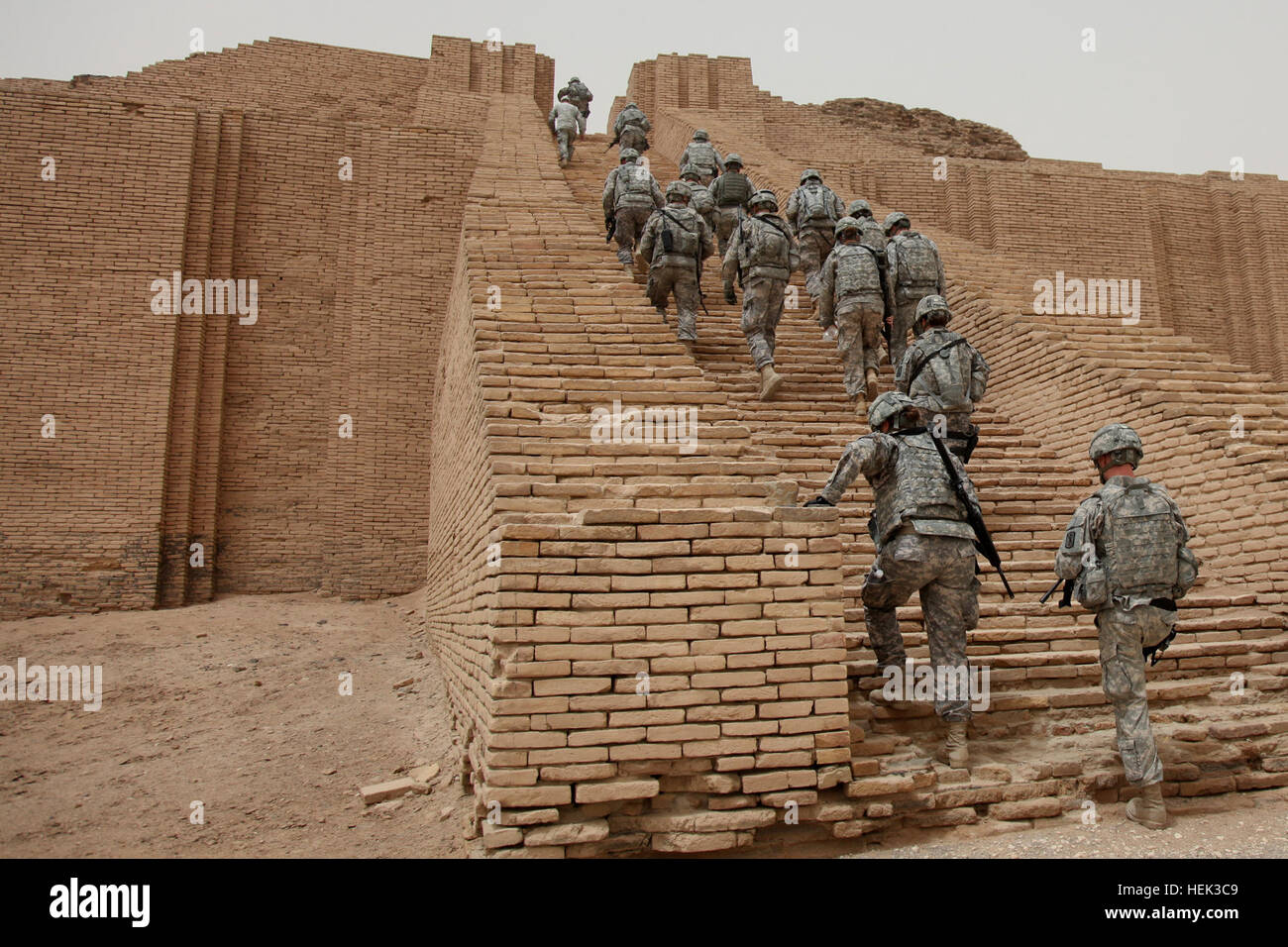 U.S. Soldiers from 17th Fires Brigade make their way up the Ziggurat of Ur, Iraq near Contingency Operating Base Adder, May 18. The Ziggurat was constructed as a place of worship in the 21st century B.C. and today after more than 4,000 years it is one of the most well-preserved structures of the Neo-Sumerian city of Ur. Operation Iraqi Freedom 284466 Stock Photohttps://www.alamy.com/image-license-details/?v=1https://www.alamy.com/stock-photo-us-soldiers-from-17th-fires-brigade-make-their-way-up-the-ziggurat-129497545.html
U.S. Soldiers from 17th Fires Brigade make their way up the Ziggurat of Ur, Iraq near Contingency Operating Base Adder, May 18. The Ziggurat was constructed as a place of worship in the 21st century B.C. and today after more than 4,000 years it is one of the most well-preserved structures of the Neo-Sumerian city of Ur. Operation Iraqi Freedom 284466 Stock Photohttps://www.alamy.com/image-license-details/?v=1https://www.alamy.com/stock-photo-us-soldiers-from-17th-fires-brigade-make-their-way-up-the-ziggurat-129497545.htmlRMHEK3C9–U.S. Soldiers from 17th Fires Brigade make their way up the Ziggurat of Ur, Iraq near Contingency Operating Base Adder, May 18. The Ziggurat was constructed as a place of worship in the 21st century B.C. and today after more than 4,000 years it is one of the most well-preserved structures of the Neo-Sumerian city of Ur. Operation Iraqi Freedom 284466
 A scenic view of Uruk City's famous Garius Temple Stock Photohttps://www.alamy.com/image-license-details/?v=1https://www.alamy.com/a-scenic-view-of-uruk-citys-famous-garius-temple-image608641269.html
A scenic view of Uruk City's famous Garius Temple Stock Photohttps://www.alamy.com/image-license-details/?v=1https://www.alamy.com/a-scenic-view-of-uruk-citys-famous-garius-temple-image608641269.htmlRF2XA6045–A scenic view of Uruk City's famous Garius Temple
 Reconstruction of the Temple of Esagila - the main sanctuary in Babylon. Reconstruction of the middle of the 20th century. Stock Photohttps://www.alamy.com/image-license-details/?v=1https://www.alamy.com/reconstruction-of-the-temple-of-esagila-the-main-sanctuary-in-babylon-reconstruction-of-the-middle-of-the-20th-century-image603695256.html
Reconstruction of the Temple of Esagila - the main sanctuary in Babylon. Reconstruction of the middle of the 20th century. Stock Photohttps://www.alamy.com/image-license-details/?v=1https://www.alamy.com/reconstruction-of-the-temple-of-esagila-the-main-sanctuary-in-babylon-reconstruction-of-the-middle-of-the-20th-century-image603695256.htmlRM2X24KCT–Reconstruction of the Temple of Esagila - the main sanctuary in Babylon. Reconstruction of the middle of the 20th century.
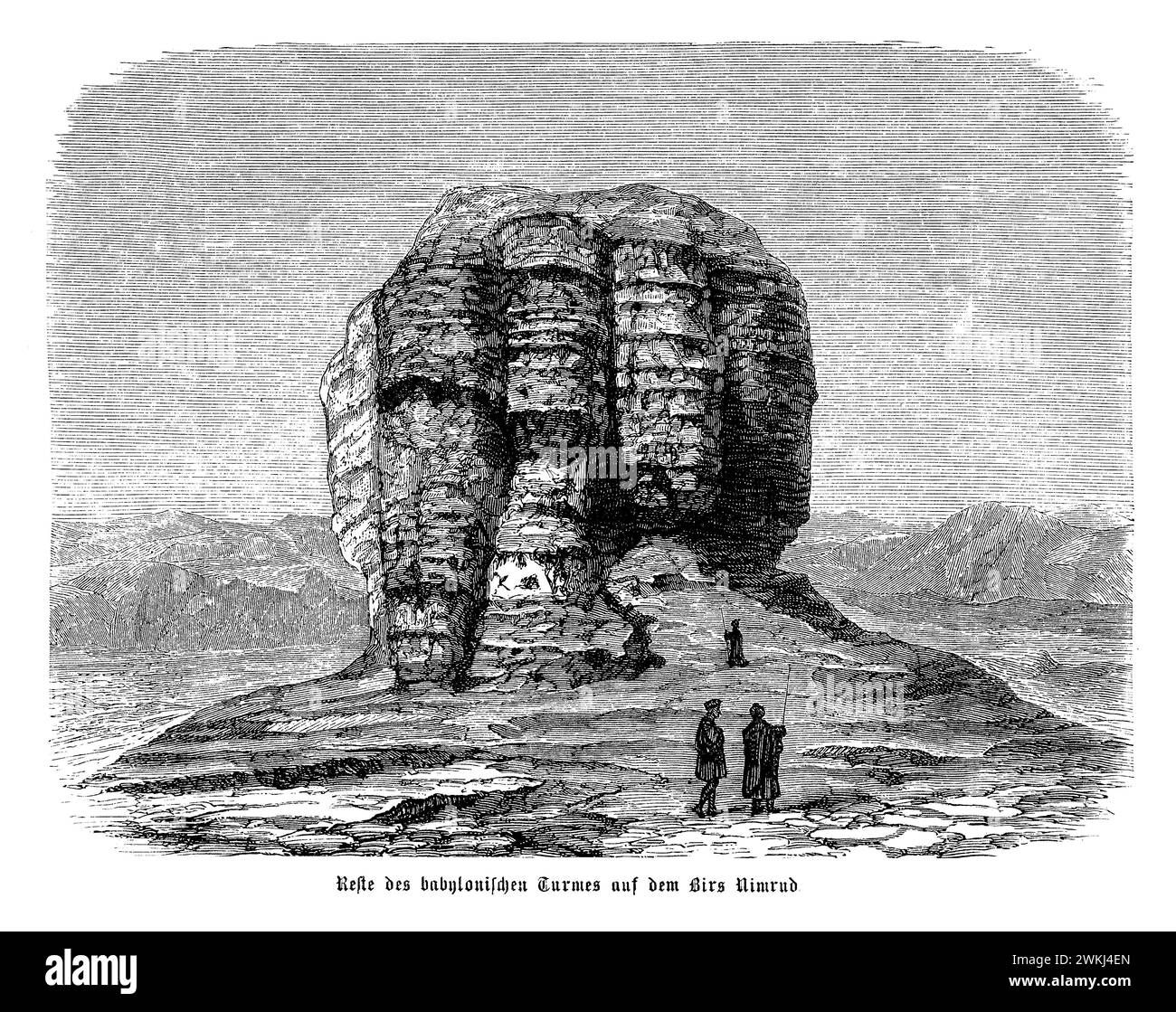 The remains of the Babylonian Tower at Birs Nimrud stand as a poignant testament to the ancient Mesopotamian civilization's architectural ambition and the enduring legend of the Tower of Babel. Located near the historical city of Babylon, these ruins are believed by some to be the site of the biblical Tower of Babel, a symbol of human aspiration and divine retribution. Although primarily a mound of rubble and remnants today, the site captures the imagination, offering insights into ancient engineering, religious practices, and the mythological narratives that have shaped human culture Stock Photohttps://www.alamy.com/image-license-details/?v=1https://www.alamy.com/the-remains-of-the-babylonian-tower-at-birs-nimrud-stand-as-a-poignant-testament-to-the-ancient-mesopotamian-civilizations-architectural-ambition-and-the-enduring-legend-of-the-tower-of-babel-located-near-the-historical-city-of-babylon-these-ruins-are-believed-by-some-to-be-the-site-of-the-biblical-tower-of-babel-a-symbol-of-human-aspiration-and-divine-retribution-although-primarily-a-mound-of-rubble-and-remnants-today-the-site-captures-the-imagination-offering-insights-into-ancient-engineering-religious-practices-and-the-mythological-narratives-that-have-shaped-human-culture-image597229661.html
The remains of the Babylonian Tower at Birs Nimrud stand as a poignant testament to the ancient Mesopotamian civilization's architectural ambition and the enduring legend of the Tower of Babel. Located near the historical city of Babylon, these ruins are believed by some to be the site of the biblical Tower of Babel, a symbol of human aspiration and divine retribution. Although primarily a mound of rubble and remnants today, the site captures the imagination, offering insights into ancient engineering, religious practices, and the mythological narratives that have shaped human culture Stock Photohttps://www.alamy.com/image-license-details/?v=1https://www.alamy.com/the-remains-of-the-babylonian-tower-at-birs-nimrud-stand-as-a-poignant-testament-to-the-ancient-mesopotamian-civilizations-architectural-ambition-and-the-enduring-legend-of-the-tower-of-babel-located-near-the-historical-city-of-babylon-these-ruins-are-believed-by-some-to-be-the-site-of-the-biblical-tower-of-babel-a-symbol-of-human-aspiration-and-divine-retribution-although-primarily-a-mound-of-rubble-and-remnants-today-the-site-captures-the-imagination-offering-insights-into-ancient-engineering-religious-practices-and-the-mythological-narratives-that-have-shaped-human-culture-image597229661.htmlRM2WKJ4EN–The remains of the Babylonian Tower at Birs Nimrud stand as a poignant testament to the ancient Mesopotamian civilization's architectural ambition and the enduring legend of the Tower of Babel. Located near the historical city of Babylon, these ruins are believed by some to be the site of the biblical Tower of Babel, a symbol of human aspiration and divine retribution. Although primarily a mound of rubble and remnants today, the site captures the imagination, offering insights into ancient engineering, religious practices, and the mythological narratives that have shaped human culture
 Reconstructed facade of the ziggurat of Ur at Iraq Stock Photohttps://www.alamy.com/image-license-details/?v=1https://www.alamy.com/reconstructed-facade-of-the-ziggurat-of-ur-at-iraq-image188573055.html
Reconstructed facade of the ziggurat of Ur at Iraq Stock Photohttps://www.alamy.com/image-license-details/?v=1https://www.alamy.com/reconstructed-facade-of-the-ziggurat-of-ur-at-iraq-image188573055.htmlRFMXP6RY–Reconstructed facade of the ziggurat of Ur at Iraq
 The belvedere beside the Lake of Waterfall in Quinta da Regaleira estate. Sintra. Portugal Stock Photohttps://www.alamy.com/image-license-details/?v=1https://www.alamy.com/the-belvedere-beside-the-lake-of-waterfall-in-quinta-da-regaleira-estate-sintra-portugal-image274125774.html
The belvedere beside the Lake of Waterfall in Quinta da Regaleira estate. Sintra. Portugal Stock Photohttps://www.alamy.com/image-license-details/?v=1https://www.alamy.com/the-belvedere-beside-the-lake-of-waterfall-in-quinta-da-regaleira-estate-sintra-portugal-image274125774.htmlRMWWYE66–The belvedere beside the Lake of Waterfall in Quinta da Regaleira estate. Sintra. Portugal
 View from the top of the Ziggurat of Ur-Nammu, Iraq 690131 011 Stock Photohttps://www.alamy.com/image-license-details/?v=1https://www.alamy.com/stock-photo-view-from-the-top-of-the-ziggurat-of-ur-nammu-iraq-690131-011-27936961.html
View from the top of the Ziggurat of Ur-Nammu, Iraq 690131 011 Stock Photohttps://www.alamy.com/image-license-details/?v=1https://www.alamy.com/stock-photo-view-from-the-top-of-the-ziggurat-of-ur-nammu-iraq-690131-011-27936961.htmlRMBHCHTH–View from the top of the Ziggurat of Ur-Nammu, Iraq 690131 011
 Iraq, Baghdad, National Museum travel landmark vector illustration Stock Vectorhttps://www.alamy.com/image-license-details/?v=1https://www.alamy.com/iraq-baghdad-national-museum-travel-landmark-vector-illustration-image544511090.html
Iraq, Baghdad, National Museum travel landmark vector illustration Stock Vectorhttps://www.alamy.com/image-license-details/?v=1https://www.alamy.com/iraq-baghdad-national-museum-travel-landmark-vector-illustration-image544511090.htmlRF2PHTHCJ–Iraq, Baghdad, National Museum travel landmark vector illustration
 The Neo-Assyrian King Ashurnasirpal II (883-859 BC) built his magnificent Northwest Palace at Nimrud (now in northern Iraq). Its interior decoration featured a series of remarkable carved stone panels. On display at the British museum. Stock Photohttps://www.alamy.com/image-license-details/?v=1https://www.alamy.com/the-neo-assyrian-king-ashurnasirpal-ii-883-859-bc-built-his-magnificent-northwest-palace-at-nimrud-now-in-northern-iraq-its-interior-decoration-featured-a-series-of-remarkable-carved-stone-panels-on-display-at-the-british-museum-image240447405.html
The Neo-Assyrian King Ashurnasirpal II (883-859 BC) built his magnificent Northwest Palace at Nimrud (now in northern Iraq). Its interior decoration featured a series of remarkable carved stone panels. On display at the British museum. Stock Photohttps://www.alamy.com/image-license-details/?v=1https://www.alamy.com/the-neo-assyrian-king-ashurnasirpal-ii-883-859-bc-built-his-magnificent-northwest-palace-at-nimrud-now-in-northern-iraq-its-interior-decoration-featured-a-series-of-remarkable-carved-stone-panels-on-display-at-the-british-museum-image240447405.htmlRMRY5939–The Neo-Assyrian King Ashurnasirpal II (883-859 BC) built his magnificent Northwest Palace at Nimrud (now in northern Iraq). Its interior decoration featured a series of remarkable carved stone panels. On display at the British museum.
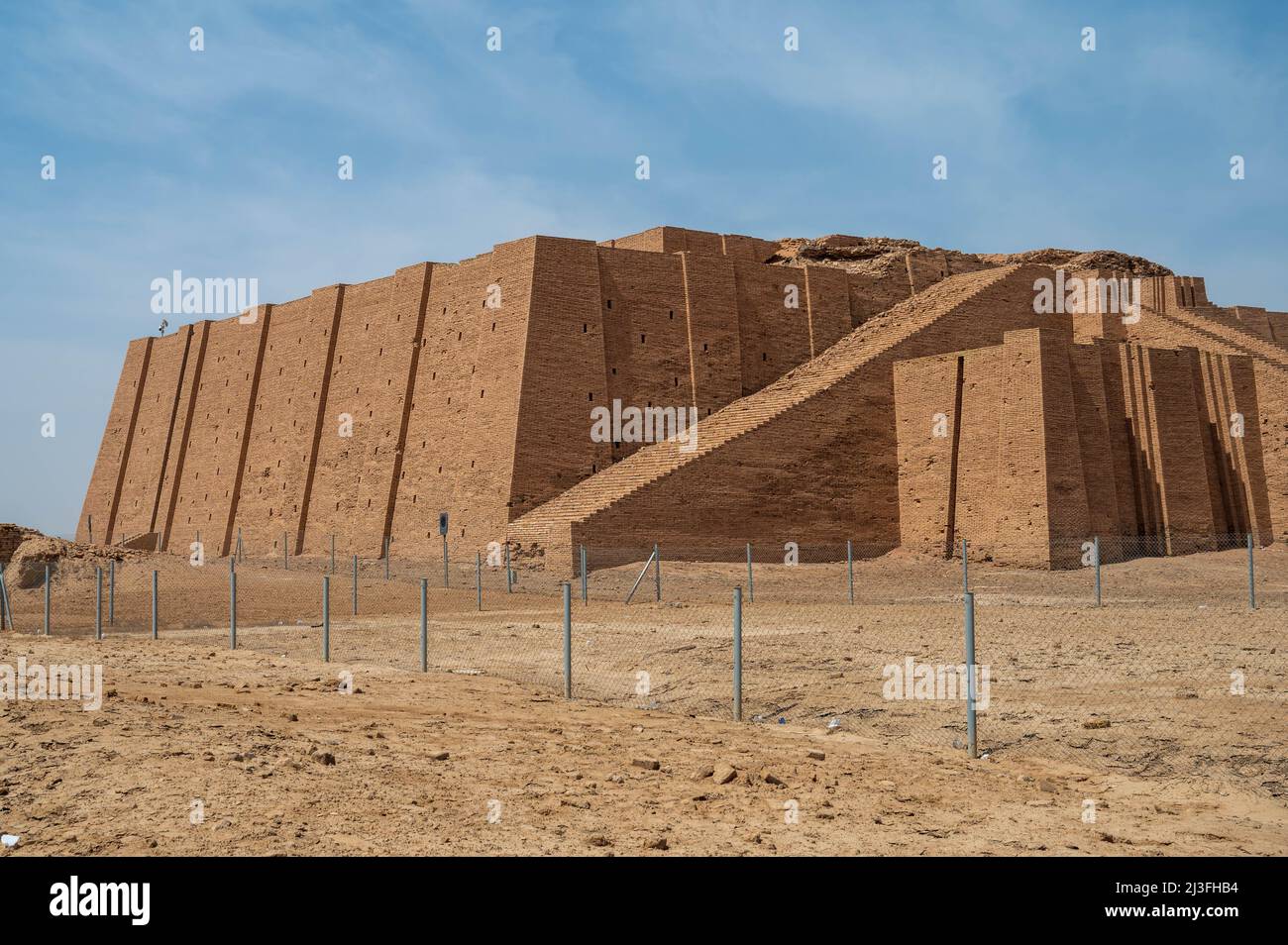 Ziggurat of Ur is a Neo-Sumerian ziggurat on the site of the ancient city of Ur near Nasiriyah, in present-day Dhi Qar Province, Iraq. The structure w Stock Photohttps://www.alamy.com/image-license-details/?v=1https://www.alamy.com/ziggurat-of-ur-is-a-neo-sumerian-ziggurat-on-the-site-of-the-ancient-city-of-ur-near-nasiriyah-in-present-day-dhi-qar-province-iraq-the-structure-w-image466866824.html
Ziggurat of Ur is a Neo-Sumerian ziggurat on the site of the ancient city of Ur near Nasiriyah, in present-day Dhi Qar Province, Iraq. The structure w Stock Photohttps://www.alamy.com/image-license-details/?v=1https://www.alamy.com/ziggurat-of-ur-is-a-neo-sumerian-ziggurat-on-the-site-of-the-ancient-city-of-ur-near-nasiriyah-in-present-day-dhi-qar-province-iraq-the-structure-w-image466866824.htmlRM2J3FHB4–Ziggurat of Ur is a Neo-Sumerian ziggurat on the site of the ancient city of Ur near Nasiriyah, in present-day Dhi Qar Province, Iraq. The structure w
 Digitally restored from a late 19th Century encyclopedia. Stock Photohttps://www.alamy.com/image-license-details/?v=1https://www.alamy.com/stock-photo-digitally-restored-from-a-late-19th-century-encyclopedia-175651471.html
Digitally restored from a late 19th Century encyclopedia. Stock Photohttps://www.alamy.com/image-license-details/?v=1https://www.alamy.com/stock-photo-digitally-restored-from-a-late-19th-century-encyclopedia-175651471.htmlRFM5NH6R–Digitally restored from a late 19th Century encyclopedia.
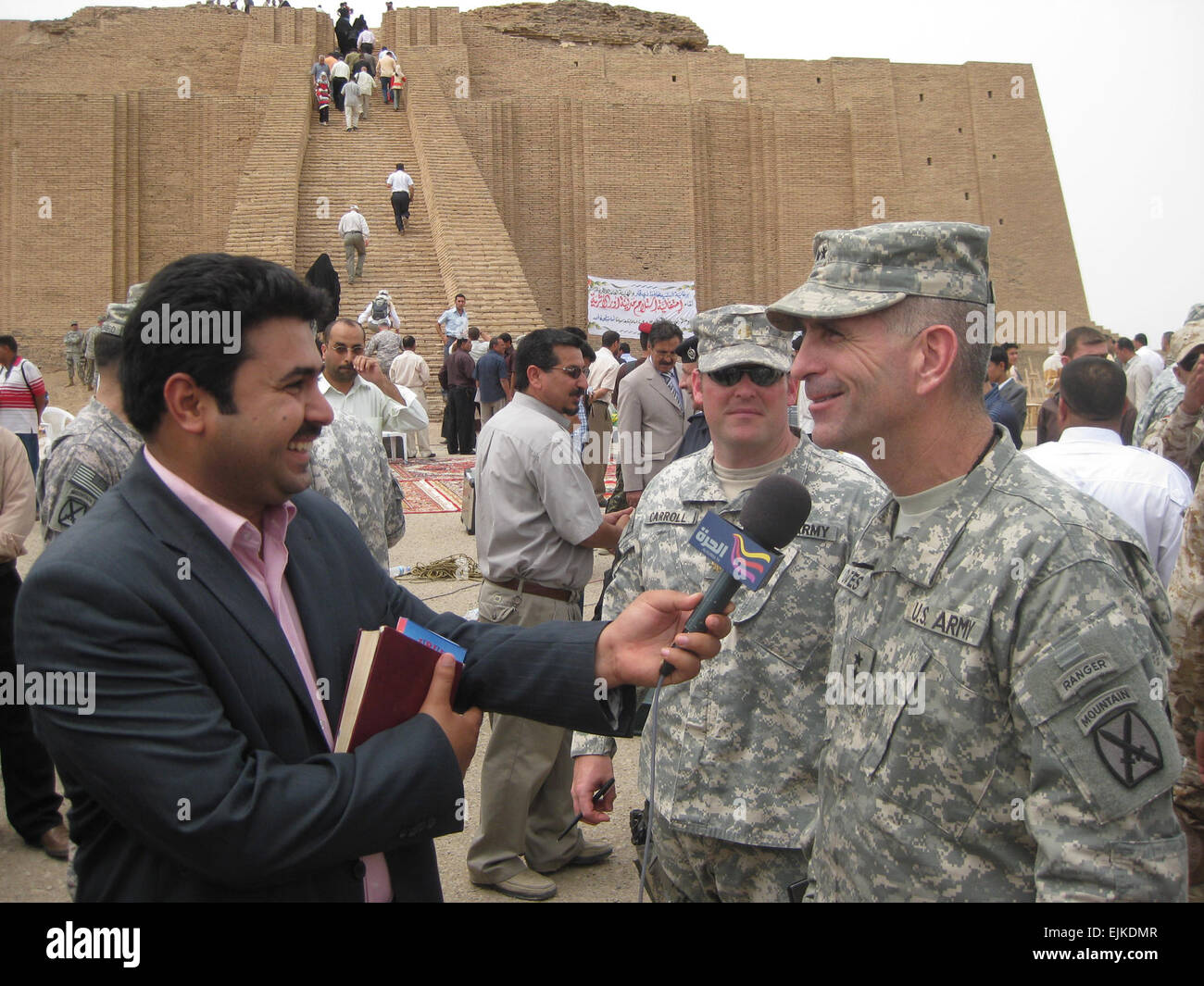 Maj. Gen. Michael Oates, commanding general, Multi-National Division - South, 10th Mountain Division, fields a question from an Iraqi reporter at a ceremony marking the transfer of the Zigguart of Ur from U.S. to Iraqi control as Maj. Chad Carroll, 4th Brigade Combat Team, 1st Cavalry Division public affairs officer from Cleburne, Texas, monitors the interview. The Ziggurat had been closed to the public since 2003. The Ziggurat was constructed in 2100 B.C. by Sumerian King Ur-Nammu. Maj. Myles Caggins Stock Photohttps://www.alamy.com/image-license-details/?v=1https://www.alamy.com/stock-photo-maj-gen-michael-oates-commanding-general-multi-national-division-south-80333143.html
Maj. Gen. Michael Oates, commanding general, Multi-National Division - South, 10th Mountain Division, fields a question from an Iraqi reporter at a ceremony marking the transfer of the Zigguart of Ur from U.S. to Iraqi control as Maj. Chad Carroll, 4th Brigade Combat Team, 1st Cavalry Division public affairs officer from Cleburne, Texas, monitors the interview. The Ziggurat had been closed to the public since 2003. The Ziggurat was constructed in 2100 B.C. by Sumerian King Ur-Nammu. Maj. Myles Caggins Stock Photohttps://www.alamy.com/image-license-details/?v=1https://www.alamy.com/stock-photo-maj-gen-michael-oates-commanding-general-multi-national-division-south-80333143.htmlRMEJKDMR–Maj. Gen. Michael Oates, commanding general, Multi-National Division - South, 10th Mountain Division, fields a question from an Iraqi reporter at a ceremony marking the transfer of the Zigguart of Ur from U.S. to Iraqi control as Maj. Chad Carroll, 4th Brigade Combat Team, 1st Cavalry Division public affairs officer from Cleburne, Texas, monitors the interview. The Ziggurat had been closed to the public since 2003. The Ziggurat was constructed in 2100 B.C. by Sumerian King Ur-Nammu. Maj. Myles Caggins
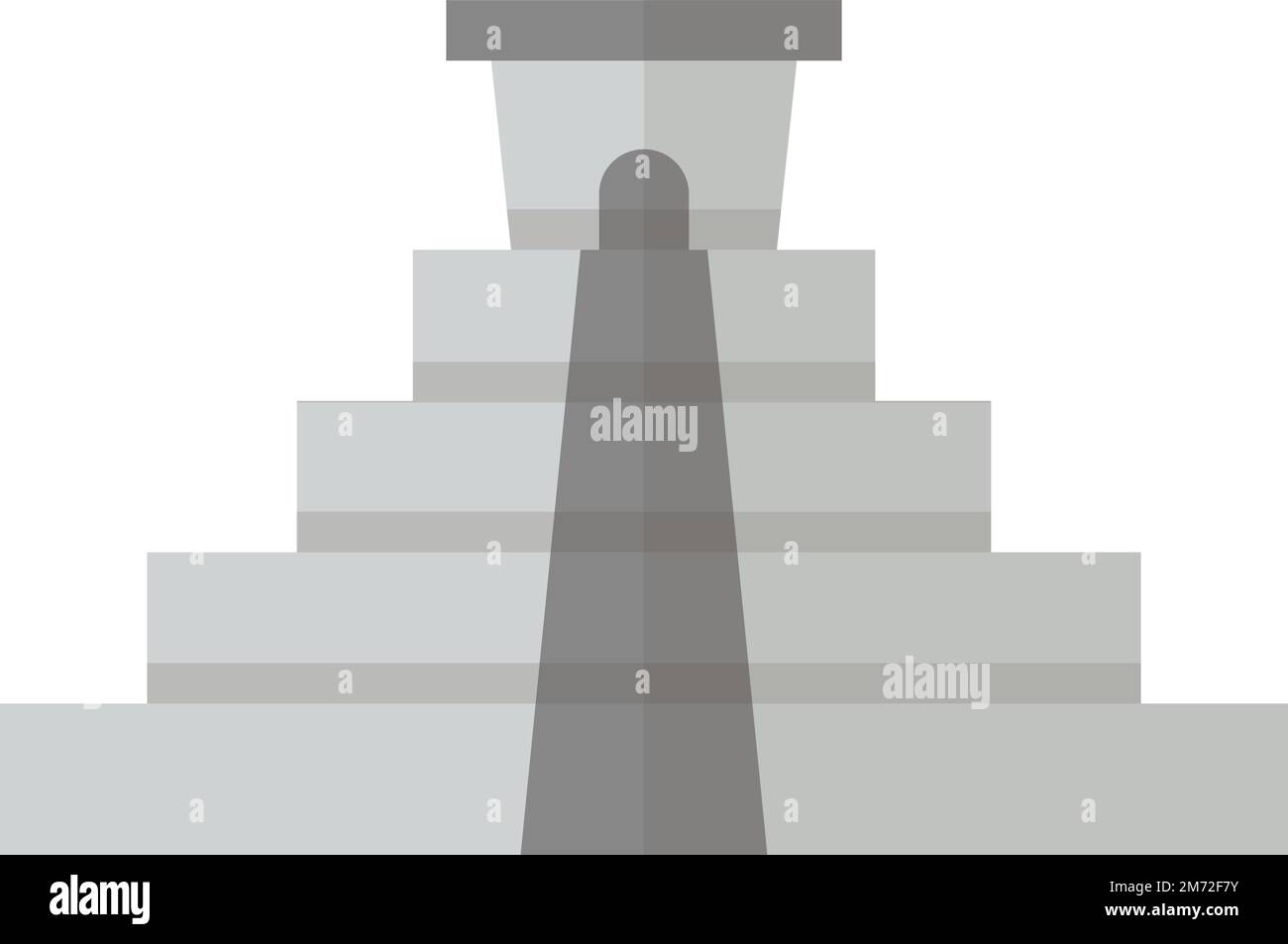 archaeological site illustration in minimal style isolated on background Stock Vectorhttps://www.alamy.com/image-license-details/?v=1https://www.alamy.com/archaeological-site-illustration-in-minimal-style-isolated-on-background-image503459151.html
archaeological site illustration in minimal style isolated on background Stock Vectorhttps://www.alamy.com/image-license-details/?v=1https://www.alamy.com/archaeological-site-illustration-in-minimal-style-isolated-on-background-image503459151.htmlRF2M72F7Y–archaeological site illustration in minimal style isolated on background
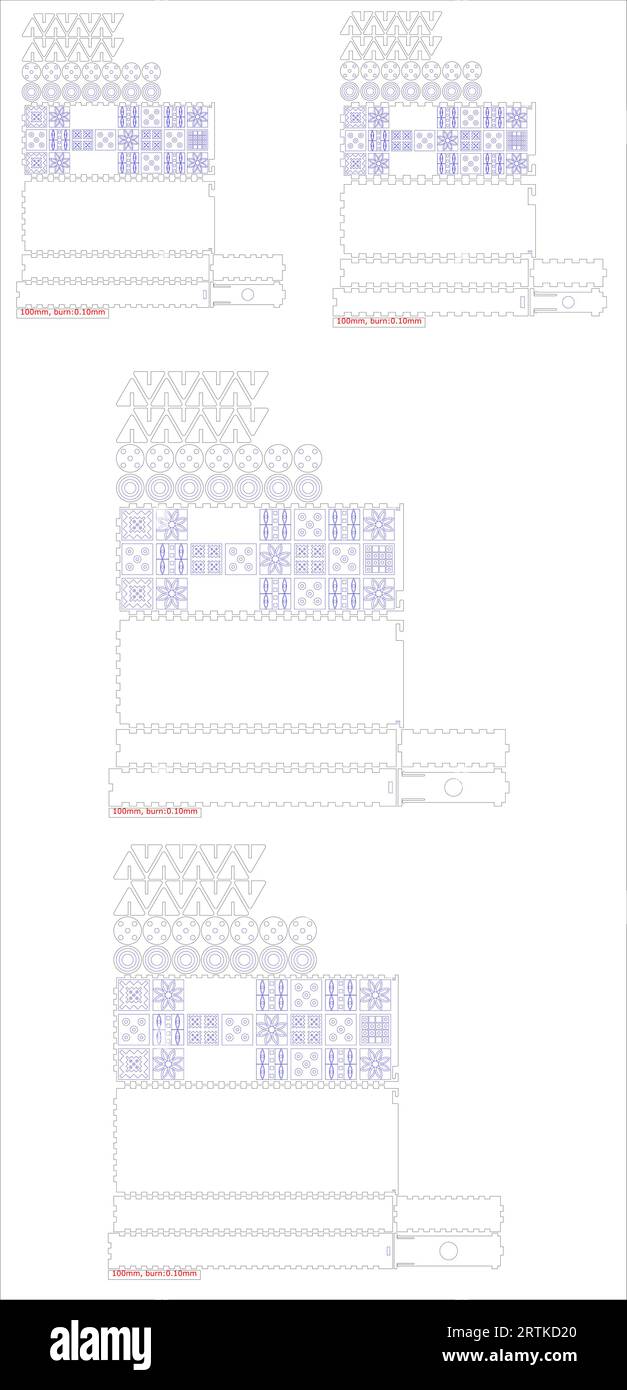 The Royal Game of Ur Cnc. laser cutting multi size collection No glue Vector illustration. Stock Vectorhttps://www.alamy.com/image-license-details/?v=1https://www.alamy.com/the-royal-game-of-ur-cnc-laser-cutting-multi-size-collection-no-glue-vector-illustration-image565910856.html
The Royal Game of Ur Cnc. laser cutting multi size collection No glue Vector illustration. Stock Vectorhttps://www.alamy.com/image-license-details/?v=1https://www.alamy.com/the-royal-game-of-ur-cnc-laser-cutting-multi-size-collection-no-glue-vector-illustration-image565910856.htmlRF2RTKD20–The Royal Game of Ur Cnc. laser cutting multi size collection No glue Vector illustration.
 Mar 01, 2008 - Tallil, Iraq - Curator DIEF MOHSSEIN NAIIF AL-GIZZY walks through the Sumerian ruins next to the Ziggurat of Ur. Al-Gizzy is the third generation in his family to care for the Ziggurat and the surrounding ruins. On the outskirts of Camp Adder, a logistics base in southern Iraq, is the Stock Photohttps://www.alamy.com/image-license-details/?v=1https://www.alamy.com/stock-photo-mar-01-2008-tallil-iraq-curator-dief-mohssein-naiif-al-gizzy-walks-42528949.html
Mar 01, 2008 - Tallil, Iraq - Curator DIEF MOHSSEIN NAIIF AL-GIZZY walks through the Sumerian ruins next to the Ziggurat of Ur. Al-Gizzy is the third generation in his family to care for the Ziggurat and the surrounding ruins. On the outskirts of Camp Adder, a logistics base in southern Iraq, is the Stock Photohttps://www.alamy.com/image-license-details/?v=1https://www.alamy.com/stock-photo-mar-01-2008-tallil-iraq-curator-dief-mohssein-naiif-al-gizzy-walks-42528949.htmlRMCD5A31–Mar 01, 2008 - Tallil, Iraq - Curator DIEF MOHSSEIN NAIIF AL-GIZZY walks through the Sumerian ruins next to the Ziggurat of Ur. Al-Gizzy is the third generation in his family to care for the Ziggurat and the surrounding ruins. On the outskirts of Camp Adder, a logistics base in southern Iraq, is the
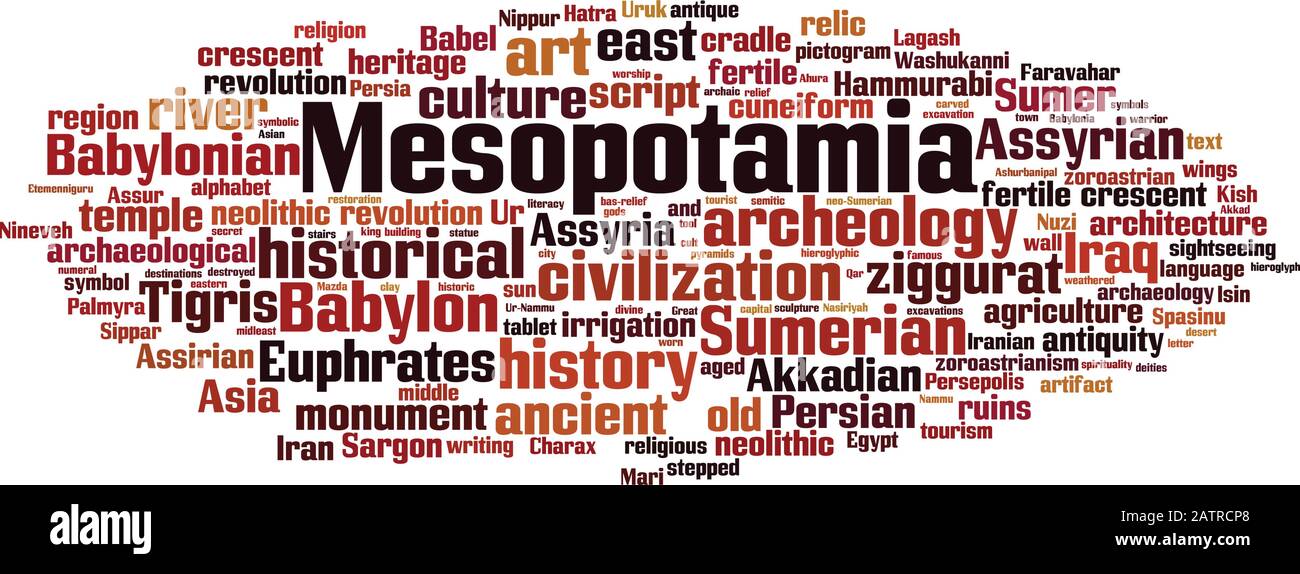 Mesopotamia word cloud concept. Collage made of words about Mesopotamia. Vector illustration Stock Vectorhttps://www.alamy.com/image-license-details/?v=1https://www.alamy.com/mesopotamia-word-cloud-concept-collage-made-of-words-about-mesopotamia-vector-illustration-image342263664.html
Mesopotamia word cloud concept. Collage made of words about Mesopotamia. Vector illustration Stock Vectorhttps://www.alamy.com/image-license-details/?v=1https://www.alamy.com/mesopotamia-word-cloud-concept-collage-made-of-words-about-mesopotamia-vector-illustration-image342263664.htmlRF2ATRCP8–Mesopotamia word cloud concept. Collage made of words about Mesopotamia. Vector illustration
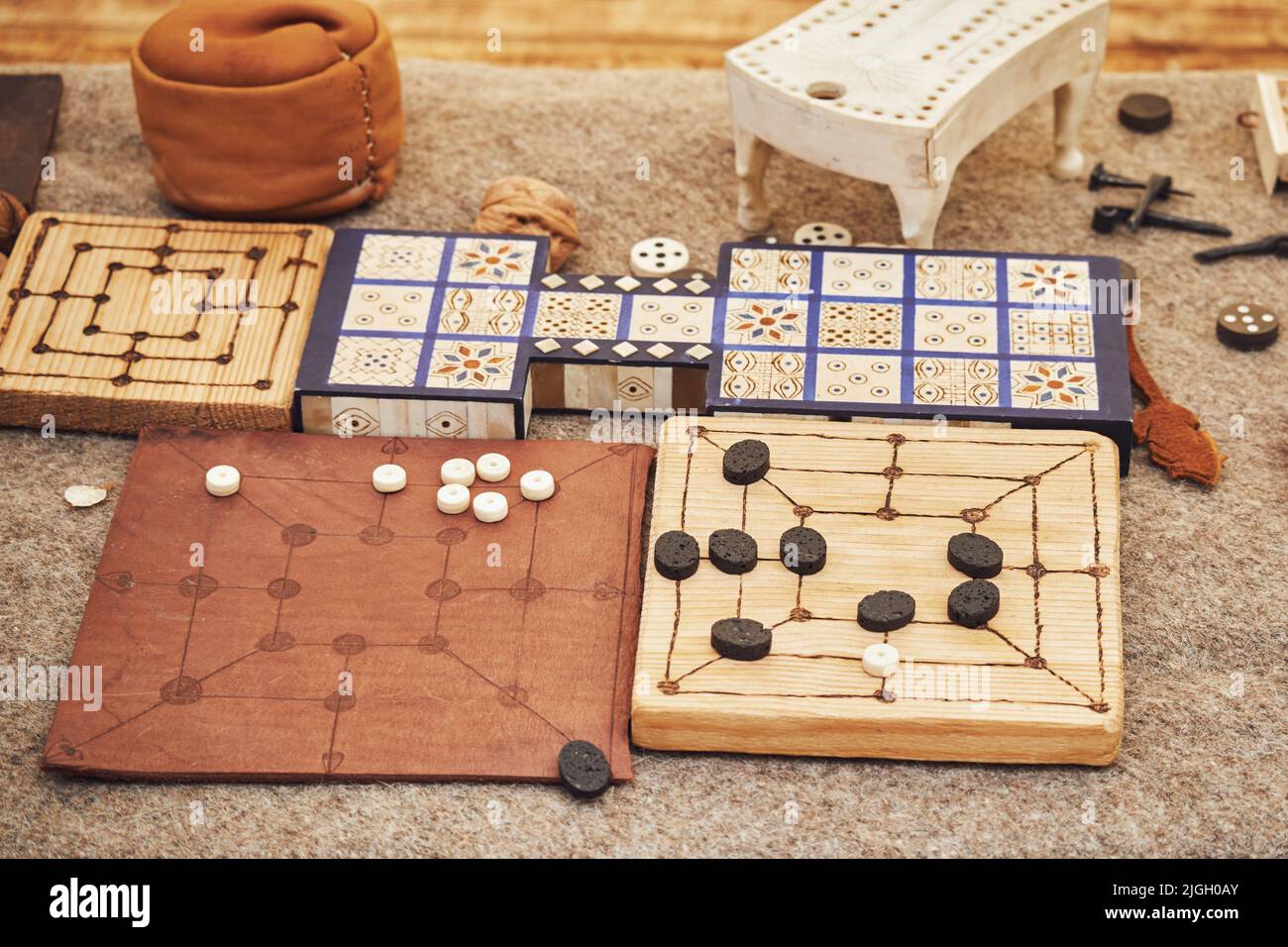 Mill and Royal Ur game, popular in ancient Roman. Reconstruction of board games from the Roman Empire Stock Photohttps://www.alamy.com/image-license-details/?v=1https://www.alamy.com/mill-and-royal-ur-game-popular-in-ancient-roman-reconstruction-of-board-games-from-the-roman-empire-image474887923.html
Mill and Royal Ur game, popular in ancient Roman. Reconstruction of board games from the Roman Empire Stock Photohttps://www.alamy.com/image-license-details/?v=1https://www.alamy.com/mill-and-royal-ur-game-popular-in-ancient-roman-reconstruction-of-board-games-from-the-roman-empire-image474887923.htmlRF2JGH0AY–Mill and Royal Ur game, popular in ancient Roman. Reconstruction of board games from the Roman Empire
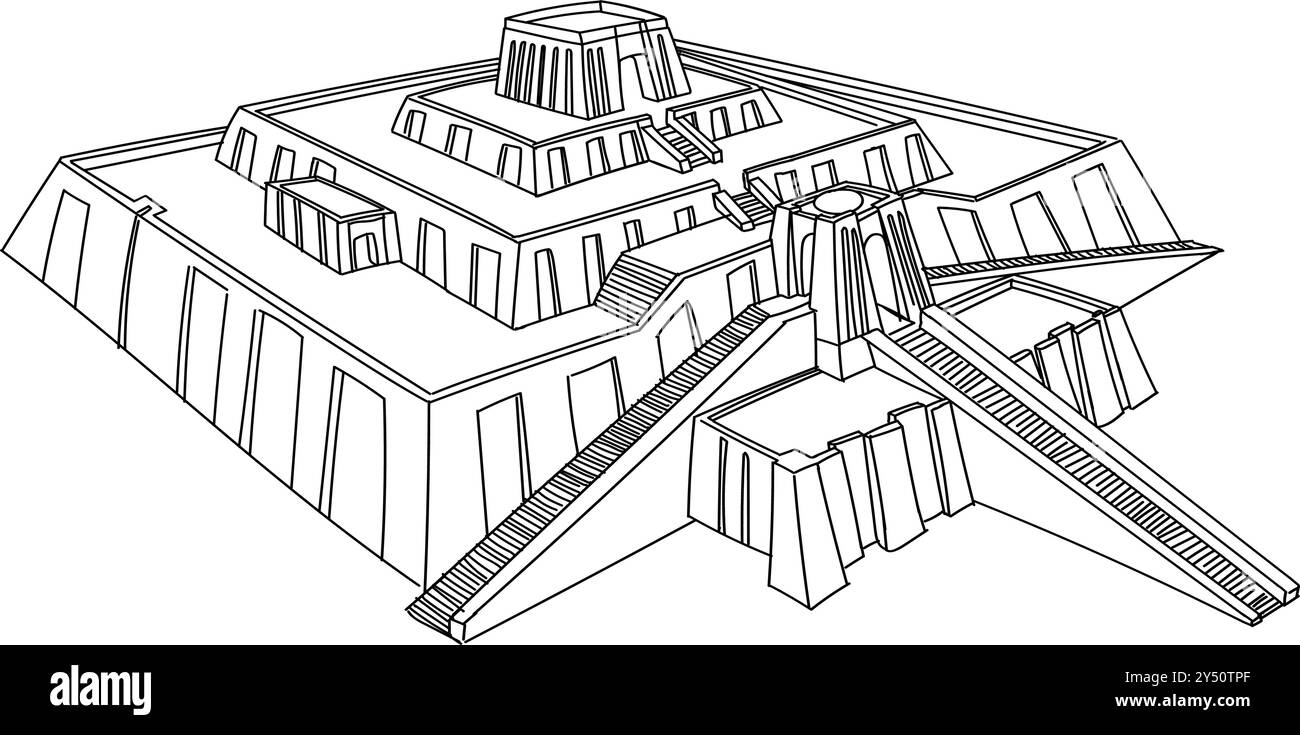 The great Ziggurat at Ur in perspective, Architecture of Babylon, Assyria, Mesopotamia. vector illustration Stock Vectorhttps://www.alamy.com/image-license-details/?v=1https://www.alamy.com/the-great-ziggurat-at-ur-in-perspective-architecture-of-babylon-assyria-mesopotamia-vector-illustration-image622665975.html
The great Ziggurat at Ur in perspective, Architecture of Babylon, Assyria, Mesopotamia. vector illustration Stock Vectorhttps://www.alamy.com/image-license-details/?v=1https://www.alamy.com/the-great-ziggurat-at-ur-in-perspective-architecture-of-babylon-assyria-mesopotamia-vector-illustration-image622665975.htmlRF2Y50TPF–The great Ziggurat at Ur in perspective, Architecture of Babylon, Assyria, Mesopotamia. vector illustration
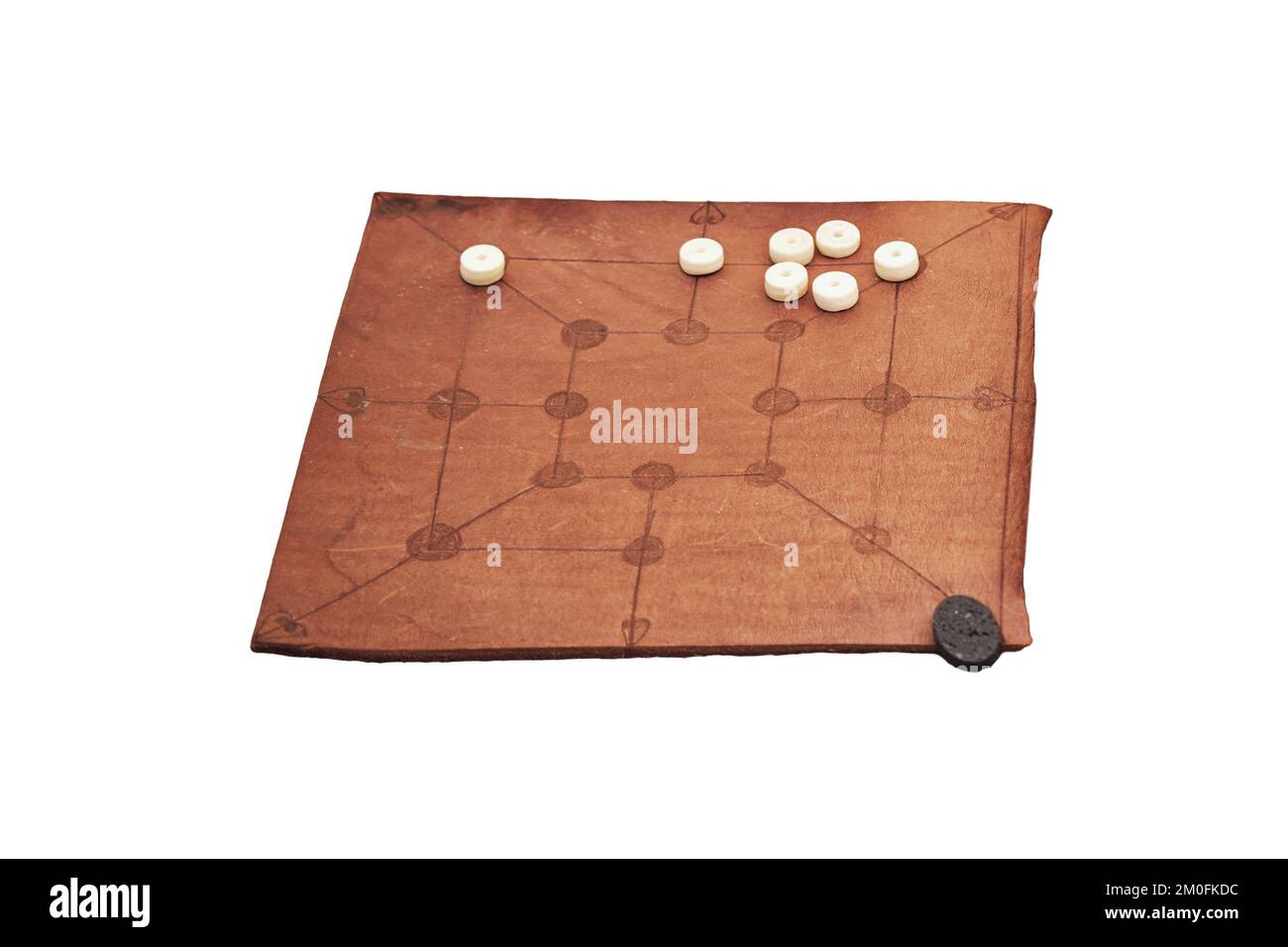 Mill game, popular in ancient Roman, isolated on a white background. Reconstruction of board games from the Roman Empire Stock Photohttps://www.alamy.com/image-license-details/?v=1https://www.alamy.com/mill-game-popular-in-ancient-roman-isolated-on-a-white-background-reconstruction-of-board-games-from-the-roman-empire-image499445224.html
Mill game, popular in ancient Roman, isolated on a white background. Reconstruction of board games from the Roman Empire Stock Photohttps://www.alamy.com/image-license-details/?v=1https://www.alamy.com/mill-game-popular-in-ancient-roman-isolated-on-a-white-background-reconstruction-of-board-games-from-the-roman-empire-image499445224.htmlRF2M0FKDC–Mill game, popular in ancient Roman, isolated on a white background. Reconstruction of board games from the Roman Empire
 U.S. Army Chaplains and their assistants from 17th Fires Brigade visit the Ziggurat of Ur, Iraq near Contingency Operating Base Adder, May 18. The Ziggurat was constructed by King Ur-Nammu as a place of worship in the 21st century B.C. and today after more than 4,000 years it is one of the most well-preserved structures of the Neo-Sumerian city of Ur. Operation Iraqi Freedom 284465 Stock Photohttps://www.alamy.com/image-license-details/?v=1https://www.alamy.com/stock-photo-us-army-chaplains-and-their-assistants-from-17th-fires-brigade-visit-129497541.html
U.S. Army Chaplains and their assistants from 17th Fires Brigade visit the Ziggurat of Ur, Iraq near Contingency Operating Base Adder, May 18. The Ziggurat was constructed by King Ur-Nammu as a place of worship in the 21st century B.C. and today after more than 4,000 years it is one of the most well-preserved structures of the Neo-Sumerian city of Ur. Operation Iraqi Freedom 284465 Stock Photohttps://www.alamy.com/image-license-details/?v=1https://www.alamy.com/stock-photo-us-army-chaplains-and-their-assistants-from-17th-fires-brigade-visit-129497541.htmlRMHEK3C5–U.S. Army Chaplains and their assistants from 17th Fires Brigade visit the Ziggurat of Ur, Iraq near Contingency Operating Base Adder, May 18. The Ziggurat was constructed by King Ur-Nammu as a place of worship in the 21st century B.C. and today after more than 4,000 years it is one of the most well-preserved structures of the Neo-Sumerian city of Ur. Operation Iraqi Freedom 284465
